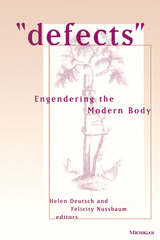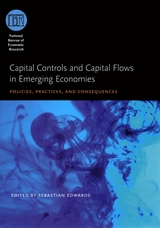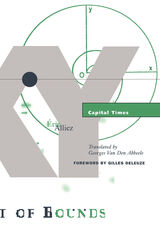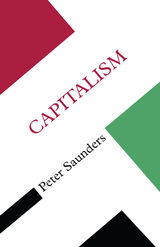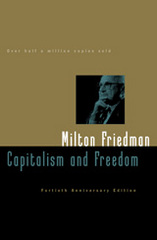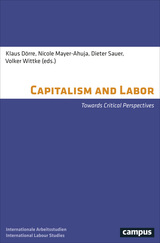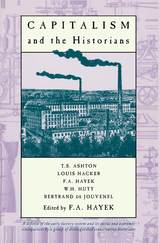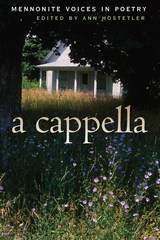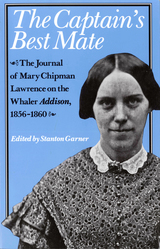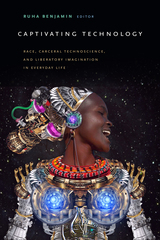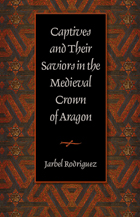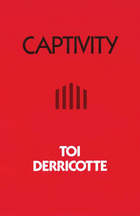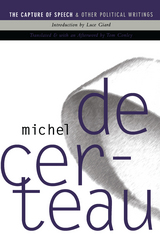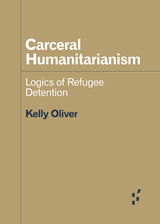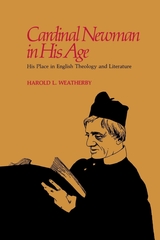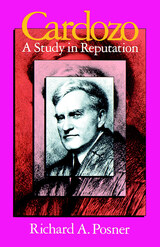Can't Pay, Won't Pay: The Fight to Stop the Poll Tax
Simon Hannah
Pluto Press, 2020 Thirty years ago, a social movement helped bring down one of the most powerful British Prime Ministers of the 20th Century. For the 30th anniversary of the Poll Tax rebellion, Simon Hannah looks back on those tumultuous days of resistance, telling the story of the people that beat the bailiffs, rioted for their rights and defied a government.
Starting in Scotland where the 'Community Charge' was first trialled, Can't Pay, Won't Pay immerses the reader in the gritty history of the rebellion. Amidst the drama of large scale protests and blockaded estates a number of key figures and groups emerge: Neil Kinnock and Tommy Sheridan; Militant, Class War and the Metropolitan Police.
Assessing this legacy today, Hannah demonstrates the centrality of the Poll Tax resistance as a key chapter in the history of British popular uprisings, Labour Party factionalism, the anti-socialist agenda and failed Tory ideology.
 Cantankerous Essays: Musings of a Disillusioned Japanophile
Ronald Dore
Amsterdam University Press, 2015 Prompted by increasing evidence of the world’s shift to the right, not least among the industrialised nations, here is a cri de coeur from almost the last survivor from the post-war crop of European sociologists and scholars of Japanese Studies. After six decades following developments in Japanese society, economy and culture and as a well-known ‘leftie’ – he describes the evolution of his cognitive and evaluative/emotional perceptions of Japan, and explains why he can no longer be described as a Japanophile. To which are added essays on more general issues of the day, such as events in the Ukraine, Iran and Israel. The key words are indeed ‘cantankerous’ (because he is greatly exercised by the ‘conspiracies of silence’ embedded in the culture of modern political and public life); ‘musings’ (because this is not so much a single-focus monograph, rather a collection of spontaneous, but deeply-considered reflections on matters of the moment) and ‘disillusioned’ (both by Japan’s reversion to chauvinistic nationalism, and because, as a youth, he hoped for and expected an enhancement of the role of reason in international affairs.) This will be of special interest to all who know or have accessed the author’s vast literary output relating to Japan; but it also has considerably wider relevance among those who are in any way connected with contemporary society, politics and economics and wish to confront the ‘conspiracy of silence’ within our interdependent world.
 Cantata in onore del Sommo Pontefice Pio IX: Poetry by Giovanni Marchetti
Gioachino Rossini
University of Chicago Press, 1996 This brilliant cantata was first performed on January 1, 1847 as part of a day of grand festivities honoring the recently elected Pius IX, who was widely welcomed in Europe as a reforming pope. Not heard again until it was revived in 1992 to great acclaim, the Cantata calls for large performing forces including four solo singers (STTB), mixed chorus with solo voices, full orchestra with serpentone, and stage band.
Rossini, in poor health at the time, had only reluctantly accepted the commission to compose the Cantata. To facilitate the task he based five of the movements on pieces from his Neapolitan operas Armida (1817) and Ricciardo e Zoraide (1818), and the Parisian opera Le Siège de Corinthe (1826). These he modified and joined together with newly-composed recitatives, the whole set to a new libretto by Count Giovanni Marchetti. A spectacular work in its own right, the Cantata in onore del Sommo Pontefice Pio IX also provides an illuminating example of Rossini's recompositional practices in adapting previous compositions to new contexts.
 Canto hondo / Deep Song
Francisco X. Alarcón
University of Arizona Press, 2015 Canto hondo / Deep Song honors the Andalusian deep lyric, or canto hondo, poetry of famed Spanish writer Federico García Lorca through rich and expressive poems. Francisco X. Alarcón deftly places Spanish and English side-by-side in this bilingual collection that is a modern meditation on love, self, loss, and universal truths.
In this new collection, Alarcón creates poetry with roots in Gypsy songs clapped out in the distinctively short rhythms of flamenco music. Each page lifts the heart and stirs the soul by delving deep into the struggle for self and sexual identity.
Canto hondo / Deep Song includes 106 poems divided into four sections that articulate struggle, otherness, and the meaning of the poetic landscape. Like Lorca, Alarcón seeks out the fault lines where the lyric and the political bleed productively and proactively into one another.
An important voice in Chicano and GLBT poetry, Alarcón writes with a complex, emotionally powerful style that is accessible to students and all lovers of poetry and poetic traditions.
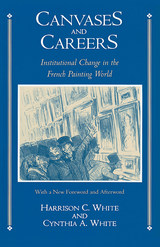 Canvases and Careers: Institutional Change in the French Painting World
Harrison C. White and Cynthia A. White
University of Chicago Press, 1993 In the nineteenth century, the Académie des Beaux Arts, and institution of central importance to the artistic life of France for over two hundred years, yielded much of its power to the present system of art distribution, which is dependent upon critics, dealers, and small exhibitions. In Canvases and Careers, Harrison and Cynthia White examine in scrupulous and fascinating detail how and why this shift occurred. Assimilating a wide range of historical and sociological data, the authors argue convincingly that the Academy, by neglecting to address the social and economic conditions of its time, undermined its own ability to maintain authority and control.
Originally published in 1965, this ground-breaking work is a classic piece of empirical research in the sociology of art. In this edition, Harrison C. White's new Foreword compares the marketing approaches of two contemporary painters, while Cynthia A. White's new Afterword reviews recent scholarship in the field.
 Canyon
Michael P. Ghiglieri
University of Arizona Press, 1992 Fasten your life jackets for a ride you'll never forget. Now the excitement of a raft trip through the Grand Canyon has been re-created by a seasoned whitewater guide with a passion to share one of the world's most fantastic journeys. Michael Ghiglieri, a professional river guide for more than 17 years, has written the first book to describe that trip from the modern boatman's point of view.
From Lee's Ferry to Diamond Creek, Ghiglieri leads you down 226 miles of wild river and through some of the most breathtaking scenery on earth. Along the way, he navigates the Colorado River's dozens of notorious rapids—many of which drop fifteen feet or more—and shares the excitement of waves and boulders, thunder and foam. Recounting a real journey through this geological wonder, Canyon interweaves heart-pounding adventure with factual insights into the world of Grand Canyon. Between the rapids, Ghiglieri relates tales of river runners past and present, lessons in geology and wildlife, observations on the impact of Glen Canyon Dam, and stories of Native inhabitants, from Anasazi ancestors to Havasupai Rastafarians. This trip also offers more than its share of human drama for the passengers aboard, leaving them with tales of their own to tell.
"Running the Colorado River in the Grand Canyon is to me the most impressive journey on our planet," writes Ghiglieri, "an adventure that leaves no traveler unchanged." For anyone who has ever shared or contemplated that adventure, Canyon recreates an unforgettable ride.
 Canyon and Cosmos: Searching for Human Identity in the Grand Canyon
Don Lago
University of Nevada Press, 2025 Throughout history, humans have sought creation stories to define our identity and affirm our connections with the universe, diverse life forms, and one another. Over the last two centuries, science has delivered a bold new creation story full of immense time and space, extraordinary objects, and powerful natural forces. Science ideas can seem mere abstractions, but at the Grand Canyon, better than anywhere else on Earth, our new creation story is manifested physically and powerfully.
A major work of literary nature writing, Canyon and Cosmos takes readers on a journey through the Grand Canyon's deep time, geological forces, and biological evolution, making them very real, personal, and meaningful. Through decades of hiking and kayaking, author Don Lago has gotten to know the canyon intimately. Ranging through world mythologies and Native American spirituality, he explores how humans have sought to understand the universe. He confronts existential questions of whether humans can find enough meaning in the scientific cosmos. Through poetic prose, symbolism, and philosophical insight, he shows how existence itself is our deepest source of life and meaning.
Canyon de Chelly: Its People and Rock Art
Campbell Grant
University of Arizona Press, 1978 With the exception of the Grand Canyon itself, none of the great gorges of the American Southwest is more uniquely beautiful than Canyon de Chelly, with its sheer red cliffs and innumerable prehistoric Indian dwellings. Of all the important centers of prehistoric Anasazi culture, only this magnificent canyon shows an unbroken record of settlement for more than 1,000 years. In this liberally illustrated book, rock art authority Campbell Grant examines four aspects of the spectacular canyon: its physical characteristics, its history of human habitation, its explorers and archaeologists, and its countless rock paintings and petroglyphs. Grant surveys 96 sites in the two main canyons and offers an interpretation of the rock art found there.
 Canyon, Mountain, Cloud: Absence and Longing in American Parks
Tyra A. Olstad
Oregon State University Press, 2021 What do we seek and what do we find when we visit parks and protected areas? What does it mean to become so deeply attached to a beautiful, wild place that it becomes part of one’s identity? And why does it matter if a particular landscape doesn’t speak to one’s soul?
Part memoir and part scholarly analysis of the psychological and societal dimensions of place-creation, Canyon, Mountain, Cloud details the author’s experiences working and living in Black Canyon of the Gunnison National Park, Denali National Park and Preserve, Adirondack State Park, and arctic Alaska. Along the way, Olstad explores canyons, climbs mountains, watches clouds, rafts rivers, searches for fossils, and protects rare and fragile vegetation. She learns and shares local natural and cultural histories, questions perceptions of “wilderness,” deepens her appreciation for wildness, and reshapes her understanding of self and self-in-place.
Anyone who has ever felt appreciation for wild places and who wants to think more deeply about individual and societal relationships with American parks and protected areas will find humor, fear, provocation, wonder, awe, and, above all, inspiration in these pages.
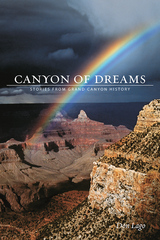 Canyon of Dreams: Stories from Grand Canyon History
Don Lago
University of Utah Press, 2014 The Grand Canyon—long recognized as one of North America’s premier natural wonders—has stirred human imagination and creativity, leaving an indelible mark on all who have encountered its spectacular vistas and intricate landscapes. Stories of the canyon’s early inhabitants to its modern day visitors are as varied and deep as the canyon’s cliffs.
In 1928 astronomer Edwin Hubble came to the canyon to test it as a site for the world’s greatest observatory. In the 1960s the Apollo astronauts hiked into the canyon to learn geology in preparation for lunar explorations. Famous writers and poets have looked to the canyon to find the meanings of nature and God. Dreamers turned a 1909 newspaper hoax into an elaborate myth about ancient Egyptian tombs in the canyon. Canyon of Dreams tells these and other stories, including that of Brighty the burro, who inspired a classic children’s novel, and the story of a teenaged Roger Miller, who spent a summer living in a trailer and “pushin’ broom” at the canyon, leading to his song “King of the Road.” Newspaper tycoon William Randolph Hearst’s fight against the National Park Service to retain property he owned on the canyon rim is another illuminating tale. Despite being little known in the official annals of Grand Canyon history, the fight served as a pivotal moment in the much broader struggle between promoters of wilderness conquest and those advocating for preservation.
This eclectic compilation runs the gamut from the idiosyncratic to the landmark, the mythical to the empirical, and everything in between. The narratives are captivating and sure to appeal to readers interested in the Grand Canyon’s long and complex history. The work is thoroughly researched and will prove a valuable contribution to historical scholarship. Canyon of Dreams sheds light on many obscure aspects of the canyon and takes readers on rollicking adventures in the process.
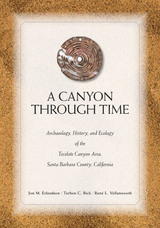 A Canyon through Time: Archaeology, History, and Ecology of the Tecolote Canyon Area, Santa Barbara County, California
Jon M Erlandson
University of Utah Press, 2008 Long a refuge for bootleggers and hobos, Tecolote Canyon was engulfed by an industrialized oil boom for twenty years beginning in the 1930s, and endured the only Japanese attack on the contiguous U.S. during World War II. In the postindustrial era, the lower canyon was a haven for surfers, nudists, and gravediggers before being transformed into a five-star resort in the 1990s. But this beautiful area of California’s Santa Barbara coast has been occupied by humans for at least 9,000 years.
Known by the Chumash Indians as Hel’apunitse (guitar fish), the canyon was a major nexus of Chumash village life from about 2000 to 500 years ago. After the arrival of Europeans, the canyon passed from Chumash hands through successive Spanish, Mexican, and American administrations.
In A Canyon through Time, the authors summarize the deep history of this beautiful canyon, which serves as a fascinating history in microcosm of the California coastal region. Using data from archaeology, ecology, geology, geography, and history, they weave an interdisciplinary tale of the natural and human prehistory and history of the Tecolote Canyon area.
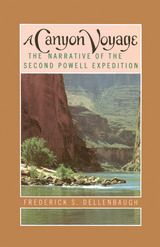 A Canyon Voyage: The Narrative of the Second Powell Expedition down the Green-Colorado River from Wyoming, and the Explorations on Land, in the Years 1871 and 1872
Frederick S. Dellenbaugh
University of Arizona Press, 1980 This account of the second Powell expedition is a reprint of the 1962 edition and includes all 50 illustrations and a substantial foreword by William H. Geotzmann.
"One of the seminal books on western history . . . The author was only 17 when he began the expedition, and he honestly hero-worshipped Powell all his life. Yet this bright, sharp account is so detailed and truthful that the reader can see through his enthusiasm to discover Powell's mean spirit and sometimes reckless nature. It's also a great river-running book." —Deseret News
"It was decidedly worth writing, this detailed record: a more absorbing, and at times stirring, story of adventure has not seen the light in a long time, and the author's unadorned, yet vivid, style enables the reader to share all the emotions of the explorers:" —The Nation
"In these later years (1909) when amateur travel in the west is frequent, a detailed record of this kind will be of value to seekers after adventure." —Science
Canyoneering 2: Technical Loop Hikes in Southern Utah
Steve Allen
University of Utah Press, 2002 Canyoneering 2: Technical Loop Hikes is a guide to seven, week-long backpack trips into some for the most unspoiled and least-visited areas in the Utah section of the Colorado Plateau. Every hike contains the four essentials of a great canyoneering route: spectacular canyons, intimate narrows, big views, and physical challenge. Although the routes are difficult, newcomers to the canyons will also find detailed information here that can be used to plan less demanding excursions. Hikes include Muddy Creek in the San Rafael Swell, Dirty Devil North, Dirty Devil South, Dark Canyon, White Canyon, Escalante East, and Escalante South. For experienced canyoneers.
 Canyoneering 3: Loop Hikes in Utah’s Escalante
Steve Allen
University of Utah Press, 1997 Utah’s Escalante country: a vast jigsaw puzzle of desert canyons, draws, defiles, gorges, slots, and washes demarcating upland expanses of slickrock, benches, and ridges, above which stand towers, pinnacles, and peaks. Inhabited for centuries by the ancient Puebloans and now managed primarily by various federal agencies, it is a land of stark contrasts and unforgettable beauty.
This guide features 37 major hikes designed to satisfy any canyoneer from novice to expert, including 20 in the new Grand Staircase-Escalante National Monument. All hikes are designed as loops, eliminating the need to backtrack or car shuttle for those inclined to do the full routes. Dayhikers can choose routes from an hour to all day, backpackers will find multi-day hikes, and those who prefer charting their own course will also profit from the information here.
Aside from the detailed route descriptions, Canyoneering 3 describes 14 road sections plus side roads to ensure time will not be lost finding a trailhead in this often confusing country. Also included are sections on geology, history, equipment, and technical canyoneering. Thoroughly researched, this is now the most comprehensive guide to the wonderland of the Escalante.
Hikes include: Death Hollow; Sand Creek; Boulder Mail Trail; Big Flat Wash, the Escalante River, and the Bowington Road; Middle Boulder Creek; Upper Boulder Creek and Dry Hollow; Phipps Wash; Big Horn Canyon; The Escalante River and the Sand Slides; Red Breaks Canyon; Harris Wash; Egypt 3-The Slot; Lower Harris Wash; Fence Canyon, the Escalante River, and Twenty-five Mile Wash; Twenty-five Mile Wash, the Escalante River, and Scorpion Gulch; Spooky and Peek-a-Book Gulches-The Long Loop; Upper Brimstone Gulch-The Slot; Scorpion Gulch and the Scorpion Horse Trail; Peek-a-Boo and Spooky Gulches-The Standard Loop; Coyote Gulch; Stevens Canyon and the Waterpocket Fold; Stevens and Fold Canyons; The Pollywog Bench Area; Forty-mile Creek and Willow Gulch Everett Russ; Fifty-mile Creek; Sixty Point and Twilight Canyon; Llewellyn and Cottonwood Gulches; Davis Gulch; Clear Creek and the Cathedral in the Desert; Deer Creek; Steep Creek and Horse Canyon; The Gulch and Horse Canyon; Little Death Hollow and Wolverine Creek; Egg Canyon and Lamanite Arch; Silver Falls Creek and Choprock Canyon; Deer Point-An Ascent; Moody Creek Canyons
 Canyoneering the Northern San Rafael Swell
Steve Allen
University of Utah Press, 2013 The San Rafael Swell is a seemingly endless expanse of slickrock, reefs, rivers, narrow canyons, mesas, towers, and pinnacles. It is the wilderness home of coyotes, eagles, mountain lions, and bighorn sheep. Steve Allen’s Canyoneering: The San Rafael Swell has long been the standard for exploring this remarkable area. With the input of fellow guidebook author Joe Mitchell, Canyoneering the Northern San Rafael Swell replacesthe older volume with a completely rewritten and updated text containing more detail, greater accuracy, and a tighter focus on the northern half of the Swell. This is the most current and comprehensive guide to the region. Designed for wilderness enthusiasts of all ages and skill levels, this guide provides detailed information on 25 hikes, including trip length, difficulty, elevation gain, and water sources. Side trips, points of interest, and historical information are noted throughout the text. This guidebook includes for the first time a wealth of topographic maps for all routes and roads, elevation profiles, and GPS coordinates.
A second volume covering the southern portion of the San Rafael Swell is in preparation.
 Canyonlands Country: Geology of Canyonlands and Arches National Parks
Donald L. Baars
University of Utah Press, 1993 An easy-to-read geological history of the amazing red rock landscapes in southeastern Utah. Towering red buttes, plunging canyon walls, domes, pinnacles, spires, ten thousand strangely carved forms—what visitor hasn’t marveled at the land of rock in southeastern Utah that is Canyonlands Country? Canyonlands Country offers a unique geological history of this awesome landscape, in language understandable by the non-geologist. The story is as strange and fascinating as the land itself. Each exposed rock layer has a different geologic history: one is a stream deposit, another is an ancient field of dunes, another was deposited by shallow tropic seas. The Green and Colorado Rivers began carving canyons thirty million years ago, but to understand such relatively recent events Canyonlands Country takes us on a journey of two billion years. Tours include Arches National Park, Island in the Sky, Needles District, The Maze and Elaterite Basin, Labyrinth and Stillwater Canyons, Meander Canyon, and Cataract Canyon.
Canyons of the Southwest: A Tour of the Great Canyon Country from Colorado to Northern Mexico
John Annerino
University of Arizona Press, 1993 The canyons of the southwestern United States and northern Mexico contain some of the most dramatic landscapes in the world. John Annerino's pictorial celebration of this visually rich region is a handsome memento for those who have heard the wind whistling in these haunting canyons, and a beckoning invitation for those who have not yet made the journey. Annerino has spent much of his adult life exploring this territory—as wilderness runner, adventurer, and photojournalist—and combines his firsthand knowledge with his expertise as a nature photographer and author to create an intimate portrait of these timeless places. Accompanying the photographs are informative essays describing the region's geological and human history.
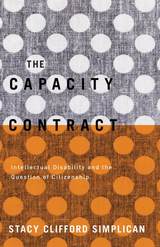 The Capacity Contract: Intellectual Disability and the Question of Citizenship
Stacy Clifford Simplican
University of Minnesota Press, 2015 In the first sustained examination of disability through the lens of political theory, The Capacity Contract shows how the exclusion of disabled people has shaped democratic politics. Stacy Clifford Simplican demonstrates how disability buttresses systems of domination based on race, sex, and gender. She exposes how democratic theory and politics have long blocked from political citizenship anyone whose cognitive capacity falls below a threshold level⎯marginalization with real-world repercussions on the implementation of disability rights today. Simplican’s compelling ethnographic analysis of the self-advocacy movement describes the obstacles it faces. From the outside, the movement must confront stiff budget cuts and dwindling memberships; internally, self-advocates must find ways to demand political standing without reinforcing entrenched stigma against people with profound cognitive disabilities. And yet Simplican’s investigation also offers democratic theorists and disability activists a more emancipatory vision of democracy as it relates to disability⎯one that focuses on enabling people to engage in public and spontaneous action to disrupt exclusion and stigma.
Taking seriously democratic promises of equality and inclusion, The Capacity Contract rejects conceptions of political citizenship that privilege cognitive capacity and, instead, centers such citizenship on action that is accessible to all people.
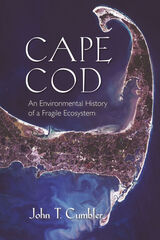 Cape Cod: An Environmental History of a Fragile Ecosystem
John T. Cumbler
University of Massachusetts Press, 2014 To many, Cape Cod represents the classic setting for an American summer vacation. Attracting seasonal tourists with picturesque beaches and abundant seafood, the Cape has held a place in our national imagination for almost two hundred years. People have been drawn to its beauty and resources since Native Americans wandered up its long sandy peninsula some 12,000 years ago, while writers such as Henry David Thoreau and Norman Mailer have celebrated its mystery and allure. But, despite its idealized image, Cape Cod has a long history of scarcity and an increasingly evident fragility.
John T. Cumbler's book offers an environmental, social, and economic history of Cape Cod told through the experiences of residents as well as visitors. He notes that over the past four hundred years the Cape has experienced three regimes of resource utilization. The first regime of Native Americans who lived relatively lightly on the land was supplanted by European settlers who focused on production and extraction. This second regime began in the age of sail but declined through the age of steam as the soil and seas failed to yield the resources necessary to sustain continuing growth. Environmental and then economic crises during the second half of the nineteenth century eventually gave way to the third regime of tourism and recreation. But this regime has its own environmental costs, as residents have learned over the last half century.
Although the Cape remains a special place, its history of resource scarcity and its attempts to deal with that scarcity offer useful lessons for anyone addressing similar issues around the globe.
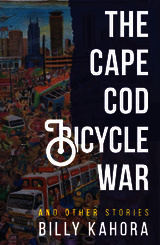 The Cape Cod Bicycle War: and Other Stories
Billy Kahora
Ohio University Press, 2020 Each of the realistic worlds Billy Kahora brings us in the short stories and novella that make up The Cape Cod Bicycle War and Other Stories explores the tensions and transitions of characters moving between youthful folly and a precarious adulthood. In the title story, immigrant workers with varying ambitions work at a Wendy’s in wintry Cape Cod. Sharing one house, they must also share, or rather compete for, bicycles—crucial transportation—which are in short supply. In other stories, a young man caught between a broken family and political violence befriends an aged gorilla in a Nairobi zoo; a pastor struggles to come to terms with the arrest of his brother, who is suspected of terrorism; and a dissolute bank employee on a serious bender returns to work to face a review board. The Cape Cod Bicycle War and Other Stories is Billy Kahora’s long-awaited debut collection. Stories in this volume have appeared in Granta and McSweeney’s and have been shortlisted for the Caine Prize for African Writing.
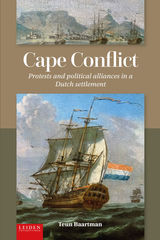 Cape Conflict: Protest and Political Alliances in a Dutch Settlement
Teun Baartman
Leiden University Press, 2019 From 1652 until 1795, the Cape of Good Hope was a Dutch settlement marked by tensions, often portrayed as antagonism between the oppressive Dutch East India Company (VOC) and the Cape’s aggrieved burghers. However, by comparing the political structures, institutions and dynamics of the Dutch Republic and its overseas settlement, the Teun Baartman demonstrates that this relationship was more cooperative and that the Cape burghers were able to influence policies in their favor similar to the way burghers in the Dutch Republic did by forming political factions. Using the Cape Conflict of the later eighteenth century as a case study, Baartman illustrates that it was in fact a fight for power between factions within the ruling elite, which consisted of both VOC officials and burghers. This book offers new evidence, a variety of interpretations, and an innovative narrative about where burghers came from, what their position was, and how the Cape political world operated.
 The Cape Herders: A History of the Khoikhoi of Southern Africa
Emile Boonzaier
Ohio University Press, 1996
The Cape Herders provides the first comprehensive picture of the Khoikhoi people. In doing so, it fills a long-standing gap in the resources of Southern African studies, and at a time when interest in the indigenous populations of South Africa is growing daily.
Combining the insights of archaeology, history, and anthropology, this account ranges from the origins of the Khoikhoi in Southern Africa to the contemporary politics of the Namaqualand “reserves.” Its authors have produced a scholarly, yet accessible, book, lavishly illustrated and supplemented with short biographies and fascinating detail.
The Cape Herders explodes a variety of South African myths—not least those surrounding the negative stereotype of the “Hottentot” and those which contribute to the idea that the Khoikhoi are by now “a vanished people.” The story it tells instead is one of enduring interest—the history of a herding people in Southern Africa, its society, economy, and culture, its relationship to the indigenous hunters of the Cape, its encounters with European expeditions, and its subsequent exposure to the first effects of colonization. It is a story of change and adaptation, and it confirms the Khoikhoi’s central role in the making of today’s South Africa.
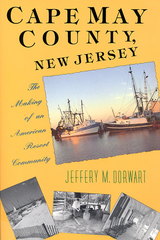 Cape May County, New Jersey: The Making of an American Resort Community
Dorwart, Jeffery M
Rutgers University Press, 1992 Cape May County, at the southern tip of New Jersey, is one of America's most vibrant seashore resorts. Jeffery Dorwart has written a history of this community from its earliest settlement as an Atlantic maritime and farming frontier to its development today as a major regional tourist attraction. From earliest times, Cape May County was a region of cultural ferment, as American Indians, African-American slaves, European Quakers, Baptists, and Presbyterians struggled to coexist on the wild, isolated Jersey Cape. Despite this variety of settlers, a distinct type of resident, known as the whaler yeoman, dominated affairs on the Cape May peninsula for over two hundred years. Railroad development and the arrival during the late nineteenth century of Eastern European, Italian, and Scandinavian immigrants gradually changed Cape May County society. A multiethnic, multicultural community evolved that threatened whaler yeoman domination. New settlements appeared in the pine wilderness of the mainland and on the uninhabited Atlantic Ocean barrier islands. These changes caused social and political conflicts, and new development assaulted the fragile seashore environment. Fishing and shipbuilding were key industries throughout the early history of Cape May County. In addition, familiar industries such as cranberry harvesting and nearly forgotten endeavors such as goldbeating, sugar refining, and cedar shingle mining played vital roles in the county's economic development. Dorwart also traces the origins of the seashore resort industry through the history of the city of Cape May, with its unique architectural styles and heritage, as well as the founding of Wildwood, Ocean City, and the newer resort towns. The story of how Cape May County responded to dramatic change not only illuminates the historical development of a New Jersey seashore community but also enhances our understanding of the American experience with changing social and economic conditions.
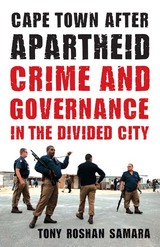 Cape Town after Apartheid: Crime and Governance in the Divided City
Tony Roshan Samara
University of Minnesota Press, 2010 Nearly two decades after the dismantling of apartheid in South Africa, how different does the nation look? In Cape Town, is hardening inequality under conditions of neoliberal globalization actually reproducing the repressive governance of the apartheid era? By exploring issues of urban security and development, Tony Roshan Samara brings to light the features of urban apartheid that increasingly mark not only Cape Town but also the global cities of our day—cities as diverse as Los Angeles, Rio de Janeiro, Paris, and Beijing.
Cape Town after Apartheid focuses on urban renewal and urban security policies and practices in the city center and townships as this aspiring world-class city actively pursues a neoliberal approach to development. The city’s attempt to escape its past is, however, constrained by crippling inequalities, racial and ethnic tensions, political turmoil, and persistent insecurity. Samara shows how governance in Cape Town remains rooted in the perceived need to control dangerous populations and protect a somewhat fragile and unpopular economic system. In urban areas around the world, where the affluent minority and poor majority live in relative proximity to each other, aggressive security practices and strict governance reflect and reproduce the divided city.
A critical case for understanding a transnational view of urban governance, especially in highly unequal, majority-poor cities, this closely observed study of postapartheid Cape Town affords valuable insight into how security and governance technologies from the global North combine with local forms to create new approaches to social control in cities across the global South.
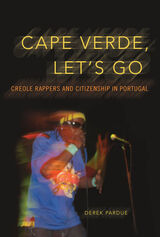 Cape Verde, Let's Go: Creole Rappers and Citizenship in Portugal
Derek Pardue
University of Illinois Press, 2015 Musicians rapping in kriolu--a hybrid of Portuguese and West African languages spoken in Cape Verde--have recently emerged from Lisbon's periphery. They popularize the struggles with identity and belonging among young people in a Cape Verdean immigrant community that shares not only the kriolu language but its culture and history. Drawing on fieldwork and archival research in Portugal and Cape Verde, Derek Pardue introduces Lisbon's kriolu rap scene and its role in challenging metropolitan Portuguese identities. Pardue demonstrates that Cape Verde, while relatively small within the Portuguese diaspora, offers valuable lessons about the politics of experience and social agency within a postcolonial context that remains poorly understood. As he argues, knowing more about both Cape Verdeans and the Portuguese invites clearer assessments of the relationship between the experience and policies of migration. That in turn allows us to better gauge citizenship as a balance of individual achievement and cultural ascription. Deftly shifting from domestic to public spaces and from social media to ethnographic theory, Pardue describes an overlooked phenomenon transforming Portugal, one sure to have parallels in former colonial powers across twenty-first-century Europe.
Cape Verdean Blues
Shauna Barbosa
University of Pittsburgh Press, 2017 “These words feel like experiences. Some are personal, most are enlightening, but all connect. Connect on a higher Level. A spiritual level.” —Kendrick Lamar, Grammy Award-winning artist, and winner of the 2018 Pulitzer Prize for Music
A Lit Hub Favorite Book of 2018
The speaker in Cape Verdean Blues is an oracle walking down the street. Shauna Barbosa interrogates encounters and the weight of their space. Grounded in bodily experience and the phenomenology of femininity, this collection provides a sense of Cape Verdean identity. It uniquely captures the essence of “Sodade,” as it refers to the Cape Verdean American experience, and also the nostalgia and self-reflection one navigates through relationships lived, lost, and imagined. And its layers of unusual imagery and sound hold the reader in their grip.
 Capital and Credit in British Overseas Trade: The View from the Chesapeake, 1700–1776
Jacob Price
Harvard University Press, 1980 In a model study Jacob Price illuminates the dynamic growth of Britain’s foreign trade in the eighteenth century through an investigation of the investment patterns and credit institutions that financed that expansion. Concentrating on the trade between Britain and the Chesapeake tobacco colonies of Virginia and Maryland, for which a unique set of records exists, Price surveys the ways in which commerce developed and working capital was mobilized in Britain to support expanding overseas trade.
Price develops the clearest picture ever of the financial environment within Britain as it affected Southern colonies in the preindustrial age. He does so by determining the kind of capital resources merchants in foreign trade actually commanded and measuring how much of their own wealth merchants brought to trade. In great and absorbing detail he discusses also the development of merchant-oriented banks in London and other ports, reinvestment of profits, long-term borrowing on bond, and the long-term credit provided to export merchants by wholesalers in textiles, ironmongery, and other industries.
The relationship of debt to the coming of the American Revolution is also treated. Tobacco growers suffered more than others from a psychological unease caused by immense debt and were more revolutionary than farmers with less intensive capital needs and, hence, with lighter debt. This history will enlighten Anglo-American historians, economic historians, and historians of the American revolutionary era.
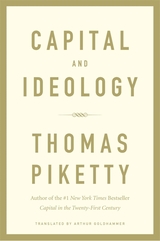 Capital and Ideology
Thomas Piketty
Harvard University Press, 2020 A New York Times Bestseller
An NPR Best Book of the Year
The epic successor to one of the most important books of the century: at once a retelling of global history, a scathing critique of contemporary politics, and a bold proposal for a new and fairer economic system.
Thomas Piketty’s bestselling Capital in the Twenty-First Century galvanized global debate about inequality. In this audacious follow-up, Piketty challenges us to revolutionize how we think about politics, ideology, and history. He exposes the ideas that have sustained inequality for the past millennium, reveals why the shallow politics of right and left are failing us today, and outlines the structure of a fairer economic system.
Our economy, Piketty observes, is not a natural fact. Markets, profits, and capital are all historical constructs that depend on choices. Piketty explores the material and ideological interactions of conflicting social groups that have given us slavery, serfdom, colonialism, communism, and hypercapitalism, shaping the lives of billions. He concludes that the great driver of human progress over the centuries has been the struggle for equality and education and not, as often argued, the assertion of property rights or the pursuit of stability. The new era of extreme inequality that has derailed that progress since the 1980s, he shows, is partly a reaction against communism, but it is also the fruit of ignorance, intellectual specialization, and our drift toward the dead-end politics of identity.
Once we understand this, we can begin to envision a more balanced approach to economics and politics. Piketty argues for a new “participatory” socialism, a system founded on an ideology of equality, social property, education, and the sharing of knowledge and power. Capital and Ideology is destined to be one of the indispensable books of our time, a work that will not only help us understand the world, but that will change it.
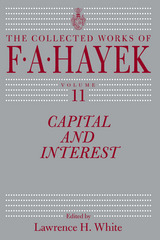 Capital and Interest
F. A. Hayek
University of Chicago Press, 2015 Produced throughout the first fifteen years of Hayek’s career, the writings collected in Capital and Interest see Hayek elaborate upon and extend his landmark lectures that were published as Prices and Production and work toward the technically sophisticated line of thought seen in his later Pure Theory of Capital. Illuminating the development of Hayek’s detailed contributions to capital and interest theory, the collection also sheds light on how Hayek’s work related to other influential economists of the time. Highlights include the 1936 article “The Mythology of Capital”—presented here alongside Frank Knight’s criticisms of the Austrian theory of capital that prompted it—and “The Maintenance of Capital,” with subsequent comments by the English economist A. C. Pigou. These and other familiar works are accompanied by lesser-known articles and lectures, including a lecture on technological progress and excess capacity. An introduction by the book’s editor, leading Hayek scholar Lawrence H. White, places Hayek’s contributions in careful historical context, with ample footnotes and citations for further reading, making this a touchstone addition to the University of Chicago Press’s Collected Works of F. A. Hayek series.
 Capital and Labor in American Copper, 1845–1990: A Study of the Linkages between Product and Labor Markets
George Hildebrand and Garth Mangum
Harvard University Press, 1992 The book is the first comprehensive study of the American copper industry to include labor markets, unionism, and labor relations as an integral part of its focus. It also undertakes a careful examination of the influences exerted by geography and geology in the shaping of the industry.
The study begins with the formation, development, and later histories of all the principal copper producers, their major business and labor policies, technical innovations, attempts at diversification, and foreign ventures. On the labor side, the book examines the beginnings of unionism in the 1880s; the emergence of the Western Federation of Miners in 1893; the later appearance of the International Union of Mine, Mill and Smelter Workers in 1916. The eventual takeover of the Mine Mill by the Steel workers in 1967 and the reasons for the eventual collapse of the pattern system in 1983 are also carefully considered.
The study emphasizes the role of strategic innovations in shaping American copper history, most prominently in the successive development of underground block-caving and open-pit mining; concentration and flotation; and solvent extraction and electrowinning. The study concludes with an evaluation of the lessons supplied by the past and the prospects for the future of the industry.
Capital at the Brink: Overcoming the Destructive Legacies of Neoliberalism
Jeffrey R. Di Leo and Uppinder Mehan, editors
Michigan Publishing, 2014 Capital at the Brink reveals the pervasiveness, destructiveness, and dominance of neoliberalism within American society and culture. The contributors to this collection also offer points of resistance to an ideology wherein, to borrow Henry Giroux’s comment, “everything either is for sale or is plundered for profit.” The first step in fighting neoliberalism is to make it visible. By discussing various inroads that it has made into political, popular, and literary culture, Capital at the Brink is taking this first step and joining a global resistance that works against neoliberalism by revealing the variety of ways in which it dominates and destroys various dimensions of our social and cultural life.
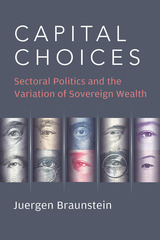 Capital Choices: Sectoral Politics and the Variation of Sovereign Wealth
Juergen Braunstein
University of Michigan Press, 2019 Sovereign wealth funds are state-controlled pools of capital that hold financial and real assets, including shares of state enterprises, and manage them to grow the nation’s base of sovereign wealth. The dramatic rise of sovereign wealth funds (SWFs) in both number and size—this group is now larger than the size of global private equity and hedge funds, combined—and the fact that most are located in non-OECD countries, has raised concern about the direction of capitalism. Yet SWFs are not a homogenous group of actors. Why do some countries with large current account surpluses, notably China, create SWFs while others, such as Switzerland and Germany, do not? Why do other countries with no macroeconomic justification, such as Senegal and Turkey, create SWFs? And why do countries with similar macroeconomic features, such as Kuwait and Qatar or Singapore and Hong Kong, choose different types of SWFs?
Capital Choices analyzes the creation of different SWFs from a comparative political economy perspective, arguing that different state-society structures at the sectoral level are the drivers for SWF variation. Juergen Braunstein focuses on the early formation period of SWFs, a critical but little understood area given the high levels of political sensitivity and lack of transparency that surround SWF creation. Braunstein’s novel analytical framework provides practical lessons for the business and finance organizations and policymakers of countries that have created, or are planning to create, SWFs.
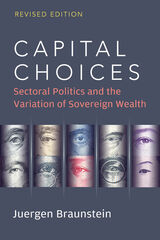 Capital Choices: Sectoral Politics and the Variation of Sovereign Wealth
Juergen Braunstein
University of Michigan Press, 2022 Sovereign wealth funds are state-controlled pools of capital that hold financial and real assets, including shares of state enterprises, and manage them to grow the nation’s base of sovereign wealth. The dramatic rise of sovereign wealth funds (SWFs) in both number and size—this group is now larger than the size of global private equity and hedge funds, combined—and the fact that most are located in non-OECD countries, has raised concern about the direction of capitalism. Yet SWFs are not a homogenous group of actors. Why do some countries with large current account surpluses, notably China, create SWFs while others, such as Switzerland and Germany, do not? Why do other countries with no macroeconomic justification, such as Senegal and Turkey, create SWFs? And why do countries with similar macroeconomic features, such as Kuwait and Qatar or Singapore and Hong Kong, choose different types of SWFs?
Capital Choices analyzes the creation of different SWFs from a comparative political economy perspective, arguing that different state-society structures at the sectoral level are the drivers for SWF variation. Juergen Braunstein focuses on the early formation period of SWFs, a critical but little understood area given the high levels of political sensitivity and lack of transparency that surround SWF creation. Braunstein’s novel analytical framework provides practical lessons for the business and finance organizations and policymakers of countries that have created, or are planning to create, SWFs.
 Capital Cities of Arab Islam
Philip Hitti
University of Minnesota Press, 1973
Professor Hitti, the distinguished authority on the Islamic world, views the highlights of Arab history through the windows of the capital cities where those events occurred. The account focuses on six cities -- Mecca, the religious capital; Medina, the caliphal capital; Damascus, the imperial capital; Baghdad, the intellectual capital; Cairo, the dissident capital; and Cordova, the European capital. The approach is historical rather than geographical, and the book is addressed to the student and the cultured layman rather than the specialist. Tourists to the Middle East and Spain also will find the book especially interesting.The author describes the physical settings of the cities, the primary occupations of the people, and the significant monumental structures. He discusses such modern history of a city as is relevant to the story, but the emphasis is on the period of Arab ascendancy -- roughly, the seventh to the thirteenth century. In addition to Arabic sources, he quotes Europeans’ descriptions where appropriate (such descriptions are rare because Europeans were not allowed in such cities as Mecca and Medina). As he makes clear, the six cities were more than capitals; they left their indelible imprint not only on the subsequent history of the Arabs and other Moslems but on the development of civilization at large.
 Capital, Class & Technology in Contemporary American Culture: Projecting Post-Fordism
Nick Heffernan
Pluto Press, 2000 In the tradition of Mike Davis and Fredric Jameson, Nick Heffernan engages in a series of meditations on capital, class and technology in contemporary America.
He turns to the stories we generate and tell ourselves - via fiction, film journalism, theory - to see how change is registered. By investigating a variety of texts, he observes how structural change affects the way people organise their lives economically, socially and culturally. Case studies include Ridley Scott's Blade Runner, William Gibson's cyberspace trilogy, Thomas Pynchon's The Crying of Lot 49, and Wim Wenders's Until the End of the World.
Using the links between narrative cultural forms and the process of historical understanding, he brings together debates that have so far been conducted largely within the separate domains of political economy, social theory and cultural criticism to provide a compelling analysis of contemporary cultural change. By relocating postmodernism in the context of changing modes of capitalism, Heffernan puts the question of class and class agency back at the centre of the critical agenda.
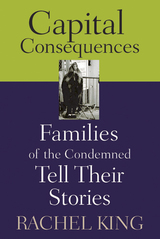 Capital Consequences: Families of the Condemned Tell Their Stories
King, Rachel
Rutgers University Press, 2004 Those who support capital punishment often claim that they do so because it provides justice and closure for the victims’ families. In Capital Consequences, attorney Rachel King reminds us that there are other families and other victims who must be considered in the debate over the death penalty.
Combining a narrative voice with vivid, passionate, and painful accounts of the families of death row inmates, the book demonstrates that crimes that lead to death sentences also devastate the families of those convicted. These families, King argues, are the unseen victims of capital punishment.
King challenges readers to question the morality of a punishment that victimizes families of the condemned and ripples out through future generations. Chapters tell the stories of families that have lost life savings supporting an accused loved one, endured intense public scrutiny, been subjected to harassment by the media, and are struggling to live with the inhumane treatment that their loved ones receive on death row. The author also explores the unique nature of the grief that these families suffer. Because their pain tends to elicit less attention and empathy than that of the crime victims’ families, King shows how it becomes much more desperate and isolating.
On a human level, this book is a powerful reminder that tragic events have tragic consequences that far outreach their immediate victims. At the same time, the accounts illustrate many of the flaws inherent in the judicial system—racial and economic bias, incompetent counsel, prosecutorial misconduct, the execution of juveniles, and wrongful convictions, some of which are only now being overturned because of recent advances in DNA technology.
Regardless of which side of the death penalty issue you are on, this book will lead you to pause and consider that all acts—criminal and retributive—have broader human implications than we are sometimes willing to realize.
Capital Controls and Capital Flows in Emerging Economies: Policies, Practices, and Consequences
Edited by Sebastian Edwards
University of Chicago Press, 2007 Some scholars argue that the free movement of capital across borders enhances welfare; others claim it represents a clear peril, especially for emerging nations. In Capital Controls and Capital Flows in Emerging Economies, an esteemed group of contributors examines both the advantages and the pitfalls of restricting capital mobility in these emerging nations.
In the aftermath of the East Asian currency crises of 1997, the authors consider mechanisms that eight countries have used to control capital inflows and evaluate their effectiveness in altering the maturity of the resulting external debt and reducing macroeconomic vulnerability. This volume is essential reading for all those interested in emerging nations and the costs and benefits of restricting international capital flows.
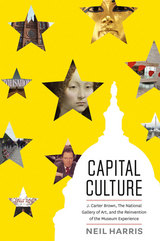 Capital Culture: J. Carter Brown, the National Gallery of Art, and the Reinvention of the Museum Experience
Neil Harris
University of Chicago Press, 2013 American art museums flourished in the late twentieth century, and the impresario leading much of this growth was J. Carter Brown, director of the National Gallery of Art in Washington, DC, from 1969 to 1992. Along with S. Dillon Ripley, who served as Smithsonian secretary for much of this time, Brown reinvented the museum experience in ways that had important consequences for the cultural life of Washington and its visitors as well as for American museums in general. In Capital Culture, distinguished historian Neil Harris provides a wide-ranging look at Brown’s achievement and the growth of museum culture during this crucial period.
Harris combines his in-depth knowledge of American history and culture with extensive archival research, and he has interviewed dozens of key players to reveal how Brown’s showmanship transformed the National Gallery. At the time of the Cold War, Washington itself was growing into a global destination, with Brown as its devoted booster. Harris describes Brown’s major role in the birth of blockbuster exhibitions, such as the King Tut show of the late 1970s and the National Gallery’s immensely successful Treasure Houses of Britain, which helped inspire similarly popular exhibitions around the country. He recounts Brown’s role in creating the award-winning East Building by architect I. M. Pei and the subsequent renovation of the West building. Harris also explores the politics of exhibition planning, describing Brown's courtship of corporate leaders, politicians, and international dignitaries.
In this monumental book Harris brings to life this dynamic era and exposes the creation of Brown's impressive but costly legacy, one that changed the face of American museums forever.
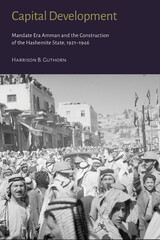 Capital Development: Mandate Era Amman and the Construction of the Hashemite State (1921–1946)
Harrison B. Guthorn
Gingko, 2021 The history of the city of Amman under the British mandate government of Transjordan.
Amman, the capital of Jordan, contends with a crisis of identity rooted in how it grew to become a symbol for the Anglo-Hashemite government first, and a city second. As a representation of the new centralized authority, Amman became the seat of the Mandatory government that orchestrated the development of Transjordan, the British mandate established in 1921.
Despite its diminutive size, the city grew to house all the components necessary for a thriving and cohesive state by the end of the British mandate in 1946. However, in spite of its modernizing and regulatory ambitions, the Transjordan government did not control all facets of life in the region. Instead, the story of Transjordan is one of tensions between the state and the realities of the region, and these limitations forced the government to scale down its aspirations. This book presents the history of Amman’s development under the rule of the British mandate from 1921–46 and illustrates how the growth of the Anglo-Hashemite state imbued the city with physical, political, and symbolic significance.
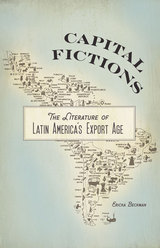 Capital Fictions: The Literature of Latin America's Export Age
Ericka Beckman
University of Minnesota Press, 2012 Between 1870 and 1930, Latin American countries were incorporated into global capitalist networks like never before, mainly as exporters of raw materials and importers of manufactured goods. During this Export Age, entire regions were given over to the cultivation of export commodities such as coffee and bananas, capital and labor were relocated to new production centers, and barriers to foreign investment were removed. Capital Fictions investigates the key role played by literature in imagining and interpreting the rapid transformations unleashed by Latin America’s first major wave of capitalist modernization. Using an innovative blend of literary and economic analysis and drawing from a rich interdisciplinary archive, Ericka Beckman provides the first extended evaluation of Export Age literary production. She traces the emergence of a distinct set of fictions, fantasies, and illusions that accompanied the rise of export-led, dependent capitalism. These “capital fictions” range from promotional pamphlets for Guatemalan coffee and advertisements for French fashions, to novels about stock market collapse in Argentina and rubber extraction in the Amazon. Beckman explores how Export Age literature anticipated some of the key contradictions faced by contemporary capitalist societies, including extreme financial volatility, vast social inequality, and ever-more-intense means of exploitation. Questioning the opposition between culture and economics in Latin America and elsewhere, Capital Fictions shows that literature operated as a powerful form of political economy during this period.
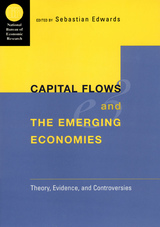 Capital Flows and the Emerging Economies: Theory, Evidence, and Controversies
Edited by Sebastian Edwards
University of Chicago Press, 2000 The 1990s witnessed several acute currency crises among developing nations that invariably spread to other nearby at-risk countries. These episodes—in Mexico, Thailand, South Korea, Russia, and Brazil—were all exacerbated by speculative foreign investments and high-volume movements of capital in and out of those countries. Insufficient domestic controls and a sluggish international response further undermined these economies, as well as the credibility of external oversight agencies like the International Monetary Fund. This timely volume examines the correlation between volatile capital mobility, currency instability, and the threat of regional contagion, focusing particular attention on the emergent economies of Latin America, Southeast Asia, and Eastern Europe.
Together these studies offer a new understanding of the empirical relationship between capital flows, international trade, and economic performance, and also afford key insights into realms of major policy concern.
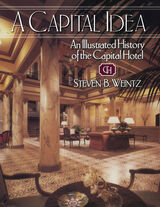 A Capital Idea: An Illustrated History of the Capital Hotel
Steven Weintz
University of Arkansas Press, 2002 The Capital Hotel is uniquely beautiful, with its cast-iron façade and marble lobby, its high-ceilinged rooms, and its rich history. Since its opening in 1876, it has been the stage for the struggles, schemes, and dreams of generations of politicians, debutantes, prostitutes, carpenters, and businessmen. And a wide variety of owners and visionaries has shaped the hotel's fortunes, among them the Yankee entrepreneur who started it all; the Italian immigrant family who kept it going in its worst days; the architect who envisioned new lives for old buildings; and the financiers and craftsmen who brought the Capital to its current glory as a luxury hotel. The story of the Capital Hotel is also the story of Little Rock, and of many American cities: built in the commercial boom of the 1870s, in full flower at the turn of the century, battered by the Depression, optimistic in the postwar era, but decrepit by the late 1960s, then renovated in the 1980s and thriving today. This lavishly illustrated volume traces the history of the hotel from its origins as a commercial building to its spectacular renovation into a jewel of downtown Little Rock.
 A Capital Idea: An Illustrated History of the Capital Hotel
Steven Weintz
University of Arkansas Press, 2026 The Capital Hotel of Little Rock, Arkansas, is uniquely beautiful, with its cast-iron façade and marble lobby, its high-ceilinged rooms, and its rich history. Since its opening in 1876, it has been the stage for the struggles, schemes, and dreams of generations of politicians, debutantes, businesspeople, and newlyweds. A wide variety of owners and visionaries have shaped the hotel’s fortunes, including the Yankee entrepreneur who raised its walls, the Italian immigrant family who kept it going in its worst days, the architect who envisioned new life in its venerable bones, and the financiers and craftsmen who brought the Capital to its current glory as a luxury hotel.
The story of the Capital Hotel is also the story of Little Rock and of many American cities: built in the commercial boom of the 1870s, in full flower at the turn of the century—then battered by the Depression, optimistic in the postwar era, decrepit by the late 1960s, rejuvenated in the 1980s and 2000s, and now thriving today. This lavishly illustrated volume—recently updated to celebrate the hotel’s 150th anniversary—traces the building’s lively history, from its origins as a commercial hub to its spectacular renovation into a jewel of downtown Little Rock.
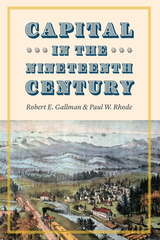 Capital in the Nineteenth Century
Robert E. Gallman and Paul W. Rhode
University of Chicago Press, 2020 Gives permanence and context to Gallman’s influential economic research on growth theory.
When we think about history, we often think about people, events, ideas, and revolutions, but what about the numbers? What do the data tell us about what was, what is, and how things changed over time? Economist Robert E. Gallman (1926–98) gathered extensive data on US capital stock and created a legacy that has, until now, been difficult for researchers to access and appraise in its entirety.
Gallman measured American capital stock from a range of perspectives, viewing it as the accumulation of income saved and invested, and as an input into the production process. He used the level and change in the capital stock as proxy measures for long-run economic performance. Analyzing data in this way from the end of the US colonial period to the turn of the twentieth century, Gallman placed our knowledge of the long nineteenth century—the period during which the United States began to experience per capita income growth and became a global economic leader—on a strong empirical foundation. Gallman’s research was painstaking and his analysis meticulous, but he did not publish the material backing to his findings in his lifetime. Here Paul W. Rhode completes this project, giving permanence to a great economist’s insights and craftsmanship. Gallman’s data speak to the role of capital in the economy, which lies at the heart of many of the most pressing issues today.
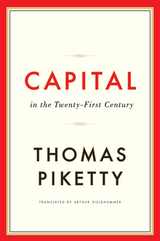 Capital in the Twenty-First Century
Thomas Piketty
Harvard University Press, 2014 A New York Times #1 Bestseller
A Wall Street Journal #1 Bestseller
A USA Today Bestseller
A Sunday Times Bestseller
A Guardian Best Book of the 21st Century
Winner of the Financial Times and McKinsey Business Book of the Year Award
Winner of the British Academy Medal
Finalist, National Book Critics Circle Award
What are the grand dynamics that drive the accumulation and distribution of capital? Questions about the long-term evolution of inequality, the concentration of wealth, and the prospects for economic growth lie at the heart of political economy. But satisfactory answers have been hard to find for lack of adequate data and clear guiding theories. In Capital in the Twenty-First Century, Thomas Piketty analyzes a unique collection of data from twenty countries, ranging as far back as the eighteenth century, to uncover key economic and social patterns. His findings will transform debate and set the agenda for the next generation of thought about wealth and inequality.
Piketty shows that modern economic growth and the diffusion of knowledge have allowed us to avoid inequalities on the apocalyptic scale predicted by Karl Marx. But we have not modified the deep structures of capital and inequality as much as we thought in the optimistic decades following World War II. The main driver of inequality—the tendency of returns on capital to exceed the rate of economic growth—today threatens to generate extreme inequalities that stir discontent and undermine democratic values. But economic trends are not acts of God. Political action has curbed dangerous inequalities in the past, Piketty says, and may do so again.
A work of extraordinary ambition, originality, and rigor, Capital in the Twenty-First Century reorients our understanding of economic history and confronts us with sobering lessons for today.
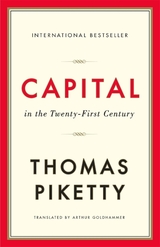 Capital in the Twenty-First Century
Thomas Piketty
Harvard University Press, 2014 A New York Times #1 Bestseller
A Wall Street Journal #1 Bestseller
A USA Today Bestseller
A Sunday Times Bestseller
A Guardian Best Book of the 21st Century
Winner of the Financial Times and McKinsey Business Book of the Year Award
Winner of the British Academy Medal
Finalist, National Book Critics Circle Award
“It seems safe to say that Capital in the Twenty-First Century, the magnum opus of the French economist Thomas Piketty, will be the most important economics book of the year—and maybe of the decade.”
—Paul Krugman, New York Times
“The book aims to revolutionize the way people think about the economic history of the past two centuries. It may well manage the feat.”
—The Economist
“Piketty’s Capital in the Twenty-First Century is an intellectual tour de force, a triumph of economic history over the theoretical, mathematical modeling that has come to dominate the economics profession in recent years.”
—Steven Pearlstein, Washington Post
“Piketty has written an extraordinarily important book…In its scale and sweep it brings us back to the founders of political economy.”
—Martin Wolf, Financial Times
“A sweeping account of rising inequality…Piketty has written a book that nobody interested in a defining issue of our era can afford to ignore.”
—John Cassidy, New Yorker
“Stands a fair chance of becoming the most influential work of economics yet published in our young century. It is the most important study of inequality in over fifty years.”
—Timothy Shenk, The Nation
 Capital, Interrupted: Agrarian Development and the Politics of Work in India
Vinay Gidwani
University of Minnesota Press, 2008 The central Gujarat region of western India is home to the entrepreneurial landowning Patel caste who have leveraged their rural dominance to become a powerful global diaspora of merchants, industrialists, and professionals. Investigating the Patels’ intriguing ascent, Vinay Gidwani analyzes its broad implications for the nature of labor and capital worldwide. With the Patels as his central case, Gidwani interrogates established concepts of value, development, and the relationship between capital and history. Capitalism, he argues, is not a frame of economic organization based on the smooth, consistent operation of a series of laws, but rather an assemblage of contingent and interrupted logics stitched together into the appearance of a deus ex machina. Following this line of thinking, Gidwani points to ways in which political economy might be freed of its lingering Eurocentrism, raises questions about the adequacy of postcolonial studies’ critique of Marx and capitalism, and opens the possibility of situating capitalism as a geographically uneven social formation in which different normative or value-creating practices are imperfectly sutured together in ways that can equally impair and enable profit and accumulation. Both theoretically astute and empirically informed, Capital, Interrupted unsettles encrusted understandings of staple concepts within the human sciences such as hegemony, governmentality, caste, and agency and, ultimately, does nothing less than rethink the very constitution of capitalism. Vinay Gidwani is associate professor of geography and global studies at the University of Minnesota.
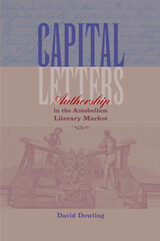 Capital Letters: Authorship in the Antebellum Literary Market
David Dowling
University of Iowa Press, 2009 In the 1840s and 1850s, as the market revolution swept the United States, the world of literature confronted for the first time the gaudy glare of commercial culture. Amid growing technological sophistication and mounting artistic rejection of the soullessness of materialism, authorship passed from an era of patronage and entered the clamoring free market. In this setting, romantic notions of what it meant to be an author came under attack, and authors became professionals. In lively and provocative writing, David Dowling moves beyond a study of the emotional toll that this crisis in self-definition had on writers to examine how three sets of authors—in pairings of men and women: Harriet Wilson and Henry David Thoreau, Fanny Fern and Walt Whitman, and Rebecca Harding Davis and Herman Melville—engaged with and transformed the book market. What were their critiques of the capitalism that was transforming the world around them? How did they respond to the changing marketplace that came to define their very success as authors? How was the role of women influenced by these conditions? Capital Letters concludes with a fascinating and daring transhistorical comparison of how two superstar authors—Herman Melville in the nineteenth century and Stephen King today—have negotiated the shifty terrain of the literary marketplace. The result is an important contribution to our understanding of print culture and literary work.
 Capital Letters: Hugo, Baudelaire, Camus, and the Death Penalty
Ève Morisi
Northwestern University Press, 2020 Capital Letters sheds new light on how literature has dealt with society’s most violent legal institution, the death penalty. It investigates this question through the works of three major French authors with markedly distinct political convictions and literary styles: Victor Hugo, Charles Baudelaire, and Albert Camus. Working at the intersection of poetics, ethics, and law, Ève Morisi uncovers an unexpected transhistorical dialogue on both the modern death penalty and the ends and means of literature after the French Revolution. Through close textual analysis, careful contextualization, and the critique of violence forged by Giorgio Agamben, Michel Foucault, and René Girard, Morisi reveals that, despite their differences, Hugo, Baudelaire, and Camus converged in questioning France’s humanitarian redefinition of capital punishment dating from the late eighteenth century. Conversely, capital justice led all three writers to interrogate the functions, tools, and limits of their art. Capital Letters shows that the key modern debate on the political and moral responsibility, or autonomy, of literature crystallizes around the death penalty in works whose form disturbs the commonly accepted divide between aestheticism and engagement.
 The Capital of Basketball: A History of DC Area High School Hoops
John McNamara, Andrea Chamblee, and David Elfin. Foreword by Gary Williams and Andrea Chamblee
Georgetown University Press, 2019 The celebration of Washington D.C. basketball is long overdue. The D.C. metro area stands second to none in its contributions to the game. Countless figures who have had a significant impact on the sport over the years have roots in the region, including E.B. Henderson, the first African-American certified to teach public school physical education, and Earl Lloyd, the first African-American to take the court in an actual NBA game. The city's Spingarn High School produced two players – Elgin Baylor and Dave Bing – recognized among the NBA’s 50 greatest at the League’s 50th anniversary celebration. No other high school in the country can make that claim.
These figures and many others are chronicled in this book, the first-ever comprehensive look at the great high school players, teams and coaches in the D.C. metropolitan area.
Based on more than 150 interviews, The Capital of Basketball is first and foremost a book about basketball. But in discussing the trends and evolution of the game, McNamara also uncovers the turmoil in the lives of the players and area residents as they dealt with prejudice, educational inequities, politics, and the ways the area has changed through the years.
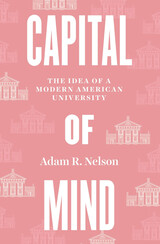 Capital of Mind: The Idea of a Modern American University
Adam R. Nelson
University of Chicago Press, 2024 The second volume of an ambitious new economic history of American higher education.
Capital of Mind is the second volume in a breathtakingly ambitious new economic history of American higher education. Picking up from the first volume, Exchange of Ideas, Adam R. Nelson looks at the early decades of the nineteenth century, explaining how the idea of the modern university arose from a set of institutional and ideological reforms designed to foster the mass production and mass consumption of knowledge. This “industrialization of ideas” mirrored the industrialization of the American economy and catered to the demands of a new industrial middle class for practical and professional education. From Harvard in the north to the University of Virginia in the south, new experiments with the idea of a university elicited intense debate about the role of scholarship in national development and international competition, and whether higher education should be supported by public funds, especially in periods of fiscal austerity. The history of capitalism and the history of the university, Nelson reveals, are intimately intertwined—which raises a host of important questions that remain salient today. How do we understand knowledge and education as commercial goods? Should they be public or private? Who should pay for them? And, fundamentally, what is the optimal system of higher education for a capitalist democracy?
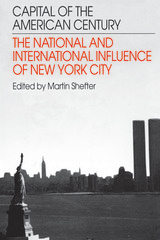 Capital of the American Century: The National and International Influence of New York City
Martin Shefter
Russell Sage Foundation, 1993 Capital of the American Century investigates the remarkable influence that New York City has exercised over the economy, politics, and culture of the nation throughout much of the twentieth century. New York's power base of corporations, banks, law firms, labor unions, artists and intellectuals has played a critical role in shaping areas as varied as American popular culture, the nation's political doctrines, and the international capitalist economy. If the city has lost its unique prominence in recent decades, the decline has been largely—and ironically—a result of the successful dispersion of its cosmopolitan values. The original essays in Capital of the American Century offer objective and intriguing analyses of New York City as a source of innovation in many domains of American life. Postwar liberalism and modernism were advanced by a Jewish and WASP coalition centered in New York's charitable foundations, communications media, and political organizations, while Wall Street lawyers and bankers played a central role in fashioning national security policies. New York's preeminence as a cultural capital was embodied in literary and social criticism by the "New York intellectuals," in the fine arts by the school of Abstract Expressionism, and in popular culture by Broadway musicals. American business was dominated by New York, where the nation's major banks and financial markets and its largest corporations were headquartered. In exploring New York's influence, the contributors also assess the larger social and economic conditions that made it possible for a single city to exert such power. New York's decline in recent decades stems not only from its own fiscal crisis, but also from the increased diffusion of industrial, cultural, and political hubs throughout the nation. Yet the city has taken on vital new roles that, on the eve of the twenty-first century, reflect an increasingly global era: it is the center of U.S. foreign trade and the international art market: The New York Times and The Wall Street Journal have emerged as international newspapers; and the city retains a crucial influence in information-intensive sectors such as corporate law, accounting, management consulting, and advertising. Capital of the American Century provides a fresh link between the study of cities and the analysis of national and international affairs. It is a book that enriches our historical sense of contemporary urban issues and our understanding of modern culture, economy, and politics.
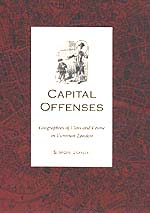 Capital Offenses: Geographies of Class and Crime in Victorian London
Simon Joyce
University of Virginia Press, 2003 As London became the first major city of the nineteenth century, new models of representation emerged in the journalism, poetry, fiction, and social commentary of the period. Simon Joyce argues that such writing reflected a persistent worry about the problem of crime but was never able to contain it. Such commentators as Wordsworth, Dickens, Mayhew, Stevenson, Conan Doyle, Booth, and Wilde all struggled with the same questions about how to represent London and the relations among its varied populations, yet their accounts often undermined one another.
Whereas Victorian social science presumed a correlation between criminal activity, geographical residence, and social class, the popular literature of the period often sought just as strenuously to deny the link, giving rise to privileged and pathological offenders like Dorian Gray and Dr. Jekyll. This in turn shifted attention away from the urban slums that had been the setting for the so-called Newgate novels of the 1830s and 1840s. By 1900, crime appears as a distinctively modern problem, requiring large-scale solutions and government intervention in place of an older approach that was rooted in personal morality or philanthropic paternalism.
Illustrating "literary geography"--in which physical space is not merely a backdrop for the plot but an integral element in shaping textual meaning--Simon Joyce's Capital Offenses reveals how certain geographical patterns can not only give weight to interpretive meanings already suggested in the texts but also enable us to read them in a new and surprising light.
--------------------------------------------------------------------------------
Simon Joyce is Associate Professor of English and Director of Literary and Cultural Studies at the College of William and Mary.
 The Capital Order: How Economists Invented Austerity and Paved the Way to Fascism
Clara E. Mattei
University of Chicago Press, 2022 A Financial Times Best Book of the Year
"A must-read, with key lessons for the future."—Thomas Piketty
A groundbreaking examination of austerity’s dark intellectual origins.
For more than a century, governments facing financial crisis have resorted to the economic policies of austerity—cuts to wages, fiscal spending, and public benefits—as a path to solvency. While these policies have been successful in appeasing creditors, they’ve had devastating effects on social and economic welfare in countries all over the world. Today, as austerity remains a favored policy among troubled states, an important question remains: What if solvency was never really the goal?
In The Capital Order, political economist Clara E. Mattei explores the intellectual origins of austerity to uncover its originating motives: the protection of capital—and indeed capitalism—in times of social upheaval from below.
Mattei traces modern austerity to its origins in interwar Britain and Italy, revealing how the threat of working-class power in the years after World War I animated a set of top-down economic policies that elevated owners, smothered workers, and imposed a rigid economic hierarchy across their societies. Where these policies “succeeded,” relatively speaking, was in their enrichment of certain parties, including employers and foreign trade interests, who accumulated power and capital at the expense of labor. Here, Mattei argues, is where the true value of austerity can be observed: its insulation of entrenched privilege and its elimination of all alternatives to capitalism.
Drawing on newly uncovered archival material from Britain and Italy, much of it translated for the first time, The Capital Order offers a damning and essential new account of the rise of austerity—and of modern economics—at the levers of contemporary political power.
 Capital Punishment and Roman Catholic Moral Tradition, Second Edition
E. Christian Brugger
University of Notre Dame Press, 2014 Why is the Catholic Church against the death penalty? This second edition of Brugger’s classic work Capital Punishment and Roman Catholic Moral Tradition traces the doctrinal path the Church has taken over the centuries to its present position as the world’s largest and most outspoken opponent of capital punishment. The pontificate of John Paul II marked a watershed in Catholic thinking. The pope taught that the death penalty is and can only be rightly assessed as a form of self-defense. But what does this mean? What are its implications for the Church’s traditional retribution-based model of lethal punishment? How does it square with what the Church has historically taught? Brugger argues that the implications of this historic turn have yet to be fully understood.
In his new preface, Brugger examines the contribution of the great Polish pope’s closest collaborator and successor in the Chair of Peter, Pope Benedict XVI, to Catholic thinking on the death penalty. He argues that Pope Benedict maintained the doctrinal status quo of his predecessor’s teaching on capital punishment as self-defense, with detectable points of reluctance to draw attention to nontraditional implications of that teaching.
 Capital Punishment Roman Catholic Mora
Brugger
University of Notre Dame Press, 2004 What is the Catholic Church's position on the death penalty? How and why has it changed through the ages? In his engrossing and meticulously researched book, Capital Punishment and Roman Catholic Moral Tradition, E. Christian Brugger traces the history of this thorny moral issue.
Part 1 of the book offers a detailed exegesis of the Church's account of the morality of the death penalty as formulated in the Catechism of the Catholic Church. Brugger argues that while the Catechism does not explicitly state that the death penalty is wrong, it lays down premises that logically imply this conclusion. Brugger argues that the fundamental moral reasoning found in the papal encyclicals Evangelium Vitae and Veritatis Splendor favor this same conclusion.
Part 2 provides an in-depth exploration of the treatment of the death penalty in the doctrine, traditional teachings, and texts of the Catholic Church. From the Old Testament and patristic writers to medieval and modern Catholic thinkers, Brugger mines this rich moral and theological tradition for arguments pertaining to capital punishment. He extracts from these teachings a "cumulative consensus" that capital punishment is morally legitimate and juxtaposes this traditional view with current church teaching.
Brugger's historical and systematic analysis of contemporary and traditional Catholic teachings on the morality of the death penalty leads him to conclude that a philosophically consistent, doctrinally sound framework and vocabulary can and should be developed for rejecting the death penalty in principle.
E. CHRISTIAN BRUGGER is assistant professor of ethics in the department of religious studies at Loyola University in New Orleans, Louisiana.
----------
"Destined to become a primary resource on the complex moral question of capital punishment, this book is the culmination of many years of extensive scholarship by Brugger (ethics, Loyola Univ.). The material is historically and theologically sound. Impressive, scholarly, and authoritative, this is recommended for large university libraries." --Library Journal
"... a superior example of disciplined scholarly reflection...." --America
"... a serious, in-depth, scholarly study of a controversial, ethical, moral, and social issue." --Midwest Book Review
"Capital Punishment and Roman Catholic Moral Tradition is an impressive work of scholarship. It could easily become the leading treatise on its subject. It provides a valuable resource for scholars in theology, history, philosophy, and political science, as well as for Catholics and others interested in the history and morality of the death penalty in Western thought." --Robert P. George, Princeton University
"This important book is a model of theological method, at every point exemplifying philosophical sophistication, critical care, creativity in systematics, and fidelity to theology's foundations in scripture and tradition." --John Finnis, Oxford University and University of Notre Dame
"Christian Brugger's Capital Punishment and Roman Catholic Moral Tradition is an admirable contribution to the current intra-church dialogue. It is welcome for several reasons, not the least of which are Brugger's consistent clarity, careful argument, and gentle tone in making his nuanced case. In this regard the book stands out as a most timely model, marked by thorough research and balanced judgment. With it he has certainly advanced the conversation about this difficult issue in a truly interesting and commendable manner, deserving of a broad readership." --James J. Megivern, University of North Carolina at Wilmington
"Brugger carefully explores and defends the proposition that the Catholic Church could teach that capital punishment is always morally wrong. His theological argument deserves careful consideration. I recommend the book especially to Catholics who believe that capital punishment is justifiable in principle even if inappropriate in practice." --Germain Grisez, Mount Saint Mary's College
"… a valuable contribution to the discussion of an unsettled and unsettling question." --First Things
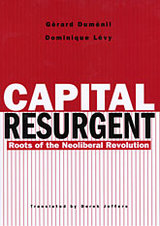 Capital Resurgent: Roots of the Neoliberal Revolution
Gérard Duménil and Dominique Lévy
Harvard University Press, 2004 The advent of economic neoliberalism in the 1980s triggered a shift in the world economy. In the three decades following World War II, now considered a golden age of capitalism, economic growth was high and income inequality decreasing. But in the mid-1970s this social compact was broken as the world economy entered the stagflation crisis, following a decline in the profitability of capital. This crisis opened a new phase of stagnating growth and wages, and unemployment. Interest rates as well as dividend flows rose, and income inequality widened.
Economists Gérard Duménil and Dominique Lévy show that, despite free market platitudes, neoliberalism was a planned effort by financial interests against the postwar Keynesian compromise. The cluster of neoliberal policies--including privatization, liberalization of world trade, and reduction in state welfare benefits--is an expression of the power of finance in the world economy.
The sequence of events initiated by neoliberalism was not unprecedented. In the late nineteenth century, when economic conditions were similar to those of the 1970s, a structural crisis led to the first financial hegemony culminating in the speculative boom of the late 1920s. The authors argue persuasively for stabilizing the world economy before we run headlong into another economic disaster.
 Capital Rules: The Construction of Global Finance
Rawi Abdelal
Harvard University Press, 2007 Listen to a short interview with Rawi AbdelalHost: Chris Gondek | Producer: Heron & Crane
The rise of global financial markets in the last decades of the twentieth century was premised on one fundamental idea: that capital ought to flow across country borders with minimal restriction and regulation. Freedom for capital movements became the new orthodoxy.
In an intellectual, legal, and political history of financial globalization, Rawi Abdelal shows that this was not always the case. Transactions routinely executed by bankers, managers, and investors during the 1990s--trading foreign stocks and bonds, borrowing in foreign currencies--had been illegal in many countries only decades, and sometimes just a year or two, earlier.
How and why did the world shift from an orthodoxy of free capital movements in 1914 to an orthodoxy of capital controls in 1944 and then back again by 1994? How have such standards of appropriate behavior been codified and transmitted internationally? Contrary to conventional accounts, Abdelal argues that neither the U.S. Treasury nor Wall Street bankers have preferred or promoted multilateral, liberal rules for global finance. Instead, European policy makers conceived and promoted the liberal rules that compose the international financial architecture. Whereas U.S. policy makers have tended to embrace unilateral, ad hoc globalization, French and European policy makers have promoted a rule-based, "managed" globalization. This contest over the character of globalization continues today.
 Capital, State, Empire: The New American Way of Digital Warfare
Scott Timcke
University of Westminster Press, 2017 The United States presents the greatest source of global geo-political violence and instability. Guided by the radical political economy tradition, this book offers an analysis of the USA’s historical impulse to weaponize communication technologies. Scott Timcke explores the foundations of this impulse and how the militarization of digital society creates structural injustices and social inequalities. He analyses how new digital communication technologies support American paramountcy and conditions for worldwide capital accumulation. Identifying selected features of contemporary American society, Capital, State, Empire undertakes a materialist critique of this digital society and of the New American Way of War. At the same time it demonstrates how the American security state represses activists—such as Black Lives Matter—who resist this emerging security leviathan. The book also critiques the digital positivism behind the algorithmic regulation used to control labour and further diminish prospects for human flourishing for the ‘99%’. Capital, State, Empire contributes to a broader understanding of the dynamics of global capitalism and political power in the early 21st century.
 Capital Taxation
Martin Feldstein
Harvard University Press, 1983 The new chairman of President Reagan's Council of Economic Advisers, Martin Feldstein is also the leading economist in the field of tax analysis. In this important volume he shows how systems of taxation influence the rate and nature of capital formation—a key policy issue in the development of any economy.
The first part of Capital Taxation deals with the overall rate of saving and examines the effects of taxes on both personal and corporate saving as well as on the interaction between the two. The second section describes the effects of tax rules on household portfolios: selection and size of investment and the process of portfolio adjustment. In Part 3, Feldstein turns to corporate investment in plant and equipment and in inventories. Part 4 analyzes the impact of capital taxation in a growing economy. Feldstein's perceptive identification of important economic and policy questions, adroit use of modeling and new data sources, and careful attention to dynamics make this book a powerful addition to the economic literature.
 Capital, the State, and War: Class Conflict and Geopolitics in the Thirty Years' Crisis, 1914-1945
Alexander Anievas
University of Michigan Press, 2014 The history of the modern social sciences can be seen as a series of attempts to confront the challenges of social disorder and revolution wrought by the international expansion of capitalist social relations. Alexander Anievas focuses on one particularly significant aspect of this story: the intersocietal or geosocial origins of the two world wars, and, more broadly, the confluence of factors behind the Thirty Years’ Crisis between 1914 and 1945. Anievas presents the Thirty Years’ Crisis as a result of the development of global capitalism with all its destabilizing social and geopolitical consequences, particularly the intertwined and co-constitutive nature of imperial rivalries, social revolutions, and anti-colonial struggles. Building on the theory of uneven and combined development, he unites geopolitical and sociological explanations into a single framework, thereby circumventing the analytical stalemate between primacy of domestic politics and primacy of foreign policy approaches.
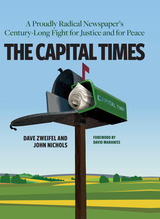 The Capital Times: A Proudly Radical Newspaper’s Century Long Fight for Justice and for Peace
John Nichols
Wisconsin Historical Society Press, 2017 As Madison’s Capital Times marks its 100th anniversary in 2017, editors Dave Zweifel and John Nichols recall the remarkable history of a newspaper that served as the tribune of Robert M. La Follette and the progressive movement, earned the praise of Franklin Delano Roosevelt for its stalwart opposition to fascism, battled Joe McCarthy during the "Red Scare," championed civil rights, women’s rights, and LGBTQ rights, opposed the Vietnam War and the invasion of Iraq, and stood with Russ Feingold when he cast the only US Senate vote against the Patriot Act. The Capital Times did not do this from New York or Washington but from the middle of America, with a readership of farmers, factory workers, teachers, and shopkeepers who stood by The Cap Times when the newspaper was boycotted, investigated, and attacked for its determination. At a point when journalism is under assault, when newspapers struggle to survive, and "old media" struggles to find its way in a digital age, The Capital Times remains unbowed—still living up to the description Lord Francis Williams, the British newspaper editor, wrote 50 years ago: "The vast majority of American papers are as dull as weed-covered ditch-water; vast Saharas of cheap advertising with occasional oases of editorial matter written to bring happiness to the Chamber of Commerce and pain and irritation to none; the bland leading the bland.… Just here and there are a few relics of the old fighting muckraking tradition of American journalism, like The Capital Times of Madison."
 Capital Transfers and Economic Policy: Canada, 1951–1962
Richard E. Caves and Grant L. Reuber
Harvard University Press, 1971 Between 1951 and 1962 nearly ten billion dollars in long-term capital (both direct investment and purchase of securities) flowed into Canada. This massive amount represented one third of all long-term capital moving among industrial nations. Its transfer marked the first time since before World War I that the world witnessed such a large-scale international movement of capital motivated primarily by a prospect of higher rates of return.
In Capital Transfers and Economic Policy the authors test the theory of the causes and effects of international capital movements against the evidence drawn from Canada's experience. They explore Canada's adjustment to capital flows and show how the operation of her economic policy is affected by the sensitivity of capital flows to the country's interest rates and foreign-exchange rate.
Their brilliant analysis is particularly valuable in light of current trends in capital flows among industrial nations and the June 1970 return of the Canadian dollar to a flexible exchange rate, which put the economy in a working situation similar to that of the fifties.
 Capital Untamed: The Politics of Finance in Nineteenth-Century France
Charlotte Robertson
University of Chicago Press The story of a bold political experiment in nineteenth-century France to establish power through finance.
Amid the rise of industrial capitalism and revolutionary turbulence in France, finance was reimagined to be an instrument of economic and social transformation rather than simply a source of private profit, speculation, and inequality. Under Napoleon III’s authoritarian regime of the 1850s, the Bonapartist state attempted to use finance to broaden financial securities ownership and sponsor new banking institutions with the promise to direct investment toward infrastructure and industry. But the effort to mobilize financial capital ran into a problem: the financial markets refused to be tamed.
Drawing on rich archival sources—from police reports and courtroom transcripts to investment manuals and shareholder petitions—Capital Untamed reveals how finance grew beyond being an instrument of political power until it escaped control. Robertson captures how the state and its citizens navigated the moment in European capitalism when the social purpose of financial capital had to be determined.
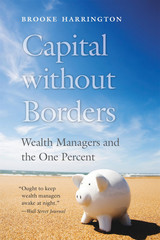 Capital without Borders: Wealth Managers and the One Percent
Brooke Harrington
Harvard University Press, 2020 “A timely account of how the 1% holds on to their wealth…Ought to keep wealth managers awake at night.”
—Wall Street Journal
“Harrington advises governments seeking to address inequality to focus not only on the rich but also on the professionals who help them game the system.”
—Richard Cooper, Foreign Affairs
“An insight unlike any other into how wealth management works.”
—Felix Martin, New Statesman
“One of those rare books where you just have to stand back in awe and wonder at the author’s achievement…Harrington offers profound insights into the world of the professional people who dedicate their lives to meeting the perceived needs of the world’s ultra-wealthy.”
—Times Higher Education
How do the ultra-rich keep getting richer, despite taxes on income, capital gains, property, and inheritance? Capital without Borders tackles this tantalizing question through a groundbreaking multi-year investigation of the men and women who specialize in protecting the fortunes of the world’s richest people. Brooke Harrington followed the money to the eighteen most popular tax havens in the world, interviewing wealth managers to understand how they help their high-net-worth clients dodge taxes, creditors, and disgruntled heirs—all while staying just within the letter of the law. She even trained to become a wealth manager herself in her quest to penetrate the fascinating, shadowy world of the guardians of the one percent.
Capitalism
Peter Saunders
University of Minnesota Press, 1995
 Capitalism, Alone: The Future of the System That Rules the World
Branko Milanovic
Harvard University Press, 2019 An Economist Book of the Year
A Financial Times Book of the Year
A Foreign Affairs Best Book of the Year
A Prospect Best Book of the Year
A ProMarket Book of the Year
An Omidyar Network “8 Storytellers Informing How We’ve been Reimagining Capitalism” Selection
“Brilliant…Poses all the important questions about our future.”
—Gordon Brown
“A scholar of inequality warns that while capitalism may have seen off rival economic systems, the survival of liberal democracies is anything but assured.”
—The Economist
We are all capitalists now. For the first time in human history, the world is dominated by one economic system. At some level capitalism has triumphed because it works: it delivers prosperity and gratifies our desire for autonomy. But this comes at a moral price, pushing us to treat material success as the ultimate goal, and offers no guarantee of stability. While Western liberal capitalism creaks under the strains of inequality and excess, some are flaunting the virtues of political capitalism, exemplified by China, which may be more efficient, but is also vulnerable to corruption and social unrest.
One of the outstanding economists of his generation, Branko Milanovic mines the data to tell his ambitious and compelling story. Capitalism gets a lot wrong, he argues, but also much right—and it isn’t going away anytime soon. Our task is to improve it in the hopes that a more equitable capitalism can take hold.
“Erudite, illuminating…Engaging to read…As a virtuoso economist, Milanovic is superb when he is compiling and assessing data.”
—Robert Kuttner, New York Review of Books
“Leaves little doubt that the social contract no longer holds. Whether you live in Beijing or New York, the time for renegotiation is approaching.”
—Edward Luce, Financial Times
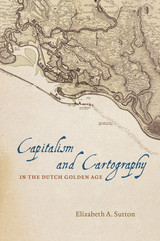 Capitalism and Cartography in the Dutch Golden Age
Elizabeth A. Sutton
University of Chicago Press, 2015 In Capitalism and Cartography in the Dutch Golden Age, Elizabeth A. Sutton explores the fascinating but previously neglected history of corporate cartography during the Dutch Golden Age, from ca. 1600 to 1650. She examines how maps were used as propaganda tools for the Dutch West India Company in order to encourage the commodification of land and an overall capitalist agenda.
Building her exploration around the central figure of Claes Jansz Vischer, an Amsterdam-based publisher closely tied to the Dutch West India Company, Sutton shows how printed maps of Dutch Atlantic territories helped rationalize the Dutch Republic’s global expansion. Maps of land reclamation projects in the Netherlands, as well as the Dutch territories of New Netherland (now New York) and New Holland (Dutch Brazil), reveal how print media were used both to increase investment and to project a common narrative of national unity. Maps of this era showed those boundaries, commodities, and topographical details that publishers and the Dutch West India Company merchants and governing Dutch elite deemed significant to their agenda. In the process, Sutton argues, they perpetuated and promoted modern state capitalism.
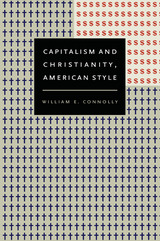 Capitalism and Christianity, American Style
William E. Connolly
Duke University Press, 2008 Capitalism and Christianity, American Style is William E. Connolly’s stirring call for the democratic left to counter the conservative stranglehold over American religious and economic culture in order to put egalitarianism and ecological integrity on the political agenda. An eminent political theorist known for his work on identity, secularism, and pluralism, Connolly charts the path of the “evangelical-capitalist resonance machine,” source of a bellicose ethos reverberating through contemporary institutional life. He argues that the vengeful vision of the Second Coming motivating a segment of the evangelical right resonates with the ethos of greed animating the cowboy sector of American capitalism. The resulting evangelical-capitalist ethos finds expression in church pulpits, Fox News reports, the best-selling Left Behind novels, consumption practices, investment priorities, and state policies. These practices resonate together to diminish diversity, forestall responsibility to future generations, ignore urban poverty, and support a system of extensive economic inequality. Connolly describes how the evangelical-capitalist machine works, how its themes resound across class lines, and how it infiltrates numerous aspects of American life. Proposing changes in sensibility and strategy to challenge this machine, Connolly contends that the liberal distinction between secular public and religious private life must be reworked. Traditional notions of unity or solidarity must be translated into drives to forge provisional assemblages comprised of multiple constituencies and creeds. The left must also learn from the political right how power is infused into everyday institutions such as the media, schools, churches, consumption practices, corporations, and neighborhoods. Connolly explores the potential of a “tragic vision” to contest the current politics of existential resentment and political hubris, explores potential lines of connection between it and theistic faiths that break with the evangelical right, and charts the possibility of forging an “eco-egalitarian” economy. Capitalism and Christianity, American Style is William E. Connolly’s most urgent work to date.
 Capitalism and Christianity: The Possibility of Christian Personalism
Richard C. Bayer
Georgetown University Press, 1999 With socialism in eclipse and market economies gaining acceptance worldwide, a new kind of ethics is needed to address social injustice and inequity. Richard C. Bayer debunks the present direction of mainstream social ethical theory by advancing market systems themselves as a means toward promoting justice and meeting human needs. Observing that the primary vehicle for Christian ethics since the New Deal has been the welfare state, Bayer argues instead that market systems can provide a basis for reconciling capitalism and Christianity in both theory and practice. He proposes Christian personalism as an ethical approach that emphasizes the dignity of the human person and promotes the achievement of personal development through participation in a modified market economy. Bayer's work draws on Catholic social thought and orthodox economics, adopting a post-Keynesian approach that deemphasizes the role of the state in the achievement of economic justice. As an example of a personalist economic reform agenda, he describes a "share economy" that advances solidarity among workers, promises greater economic efficiency, and increases employee participation in profit-sharing and decision-making. Capitalism and Christianity integrates moral arguments with economic analysis to challenge prevailing thought in contemporary Christian social ethics. By incorporating key insights of liberalism while providing constructive criticism of that perspective, it creatively addresses both personal development and the common good.
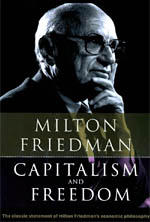 Capitalism and Freedom
Milton Friedman
University of Chicago Press, 1963 In the classic bestseller, Capitalism and Freedom, Milton Friedman presents his view of the proper role of competitive capitalism—the organization of economic activity through private enterprise operating in a free market—as both a device for achieving economic freedom and a necessary condition for political freedom. Beginning with a discussion of principles of a liberal society, Friedman applies them to such constantly pressing problems as monetary policy, discrimination, education, income distribution, welfare, and poverty.
"Milton Friedman is one of the nation's outstanding economists, distinguished for remarkable analytical powers and technical virtuosity. He is unfailingly enlightening, independent, courageous, penetrating, and above all, stimulating."-Henry Hazlitt, Newsweek
"It is a rare professor who greatly alters the thinking of his professional colleagues. It's an even rarer one who helps transform the world. Friedman has done both."-Stephen Chapman, Chicago Tribune
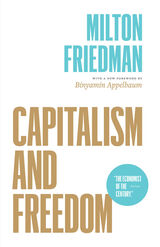 Capitalism and Freedom
Milton Friedman
University of Chicago Press, 2020 One of TIME magazine’s All-TIME 100 Best Nonfiction Books
One of Times Literary Supplement’s 100 Most Influential Books Since the War
One of National Review’s 100 Best Nonfiction Books of the Century
One of the Intercollegiate Studies Institute’s 50 Best Books of the 20th Century
How can we benefit from the promise of government while avoiding the threat it poses to individual freedom? In this classic book, Milton Friedman provides the definitive statement of an immensely influential economic philosophy—one in which competitive capitalism serves as both a device for achieving economic freedom and a necessary condition for political freedom.
First published in 1962, Friedman’s Capitalism and Freedom is one of the most significant works of economic theory ever written. Enduring in its eminence and esteem, it has sold nearly a million copies in English, has been translated into eighteen languages, and continues to inform economic thinking and policymaking around the world. This new edition includes prefaces written by Friedman for both the 1982 and 2002 reissues of the book, as well as a new foreword by Binyamin Appelbaum, lead economics writer for the New York Times editorial board.
Capitalism and Freedom: Fortieth Anniversary Edition
Milton Friedman
University of Chicago Press, 2002 Selected by the Times Literary Supplement as one of the "hundred most influential books since the war"
How can we benefit from the promise of government while avoiding the threat it poses to individual freedom? In this classic book, Milton Friedman provides the definitive statement of his immensely influential economic philosophy—one in which competitive capitalism serves as both a device for achieving economic freedom and a necessary condition for political freedom. The result is an accessible text that has sold well over half a million copies in English, has been translated into eighteen languages, and shows every sign of becoming more and more influential as time goes on.
Capitalism and Labor: Towards Critical Perspectives
Edited by Klaus Dörre, Nicole Mayer-Ahuja, Dieter Sauer, and Volker Wittke
Campus Verlag, 2012 Capitalism’s presence in nearly all areas of contemporary life is widely-known and unshakeable. There is perhaps nowhere more true than in the workplace. Why then, ask the authors of this collection, have the broad concepts of work and capitalism become a progressively smaller focus in sociology in recent decades, shunted to the sidelines in favor of more granular subjects in labor studies? Capitalism and Labor calls for sociologists to refocus their research on the unavoidable realities of the capitalist system, particularly in the wake of the global financial and economic unrest of the past decade. Although they provide no easy solutions, the essays in this book will serve as a starting point for sociologists to renew their focus on labor and its inextricable relationship to capitalism in the twenty-first century.
Capitalism and the Dialectic: The Uno-Sekine Approach to Marxian Political Economy
John R. Bell
Pluto Press, 2009 From the 1960s to the 1990s the ground-breaking Japanese economists Kozo Uno and Thomas Sekine developed a masterful reconfiguration of Marxist economics. The most well-known aspect of which is the levels of analysis approach to the study of capitalism.
Written in Japanese, the Uno-Sekine approach to Marx's work is little understood in West. John Bell seeks to correct this, explaining how problematic elements of Marxian Political Economy such as the law of value and the law of relative surplus population can be solved by using a more rigorous dialectical analysis.
Bell's clear and accessible synthesis provides economists with the tools to interrogate capitalism in a more powerful way than ever before.
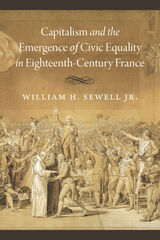 Capitalism and the Emergence of Civic Equality in Eighteenth-Century France
William H. Sewell Jr.
University of Chicago Press, 2021 There is little doubt that the French Revolution of 1789 changed the course of Western history. But why did the idea of civic equality—a distinctive signature of that revolution—find such fertile ground in France? How might changing economic and social realities have affected political opinions?
William H. Sewell Jr. argues that the flourishing of commercial capitalism in eighteenth-century France introduced a new independence, flexibility, and anonymity to French social life. By entering the interstices of this otherwise rigidly hierarchical society, expanded commodity exchange colored everyday experience in ways that made civic equality thinkable, possible, even desirable, when the crisis of the French Revolution arrived. Sewell ties together masterful analyses of a multitude of interrelated topics: the rise of commerce, the emergence of urban publics, the careers of the philosophes, commercial publishing, patronage, political economy, trade, and state finance. Capitalism and the Emergence of Civic Equality in Eighteenth-Century France offers an original interpretation of one of history’s pivotal moments.
Capitalism and the Historians
Edited by F. A. Hayek
University of Chicago Press, 1963 The views generally held about the rise of the factory system in Britain derive from highly distorted accounts of the social consequences of that system—so say the distinguished economic historians whose papers make up this book. The authors offer documentary evidence to support their conclusion that under capitalism the workers, despite long hours and other hardships of factory life, were better off financially, had more opportunities, and led a better life than had been the case before the Industrial Revolution.
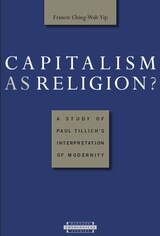 Capitalism as Religion? A Study of Paul Tillich's Interpretation of Modernity
Francis Ching-Wah Yip
Harvard University Press, 2010 The relationship between religion and modern culture remains a controversial issue within Christian theology. This book focuses on Paul Tillich's interpretation of modern culture and the influence of capitalism, highlighting the context of his work in relation to Karl Marx and the Critical Theory of the Frankfurt School. When Tillich moved to the United States he sharpened his focus on the cultural dimensions of capitalism. Using the concept of "cultural modernity," Francis Ching-Wah Yip reconstructs Tillich's interpretation of modernity with the key categories of autonomy, self-sufficient finitude, technical reason, objectification, and dehumanization, and shows that Tillich's notion of theonomy served to underscore the problems of modernity and to develop a response.
The final section of the book relates Tillich's theology to contemporary theological interpretations of global capitalism and modernity. Yip appeals to the work of Jürgen Moltmann to argue that one should go beyond Tillich's analysis by placing much more emphasis on the material-economic basis of culture and by moving away from the Eurocentric viewpoint to a more global perspective. Finally, he draws on Émile Durkheim to show the quasi-religious dimension of capitalism as a global civil religion and as the culture of modern society.
 Capitalism, Colonisation and the Ecocide-Genocide Nexus
Martin Crook
University of London Press, 2024 A timely analysis of the genocidal and ecologically destructive nature of capitalism and colonialism, and its effects.
This timely publication examines the drivers of ecologically induced genocide, in particular, how environmental destruction can lead to conditions that fundamentally threaten a social group’s cultural or physical existence. Focusing on the former British colonies of Kenya and Australia, both united by a discourse of developmentalism, this book draws attention to the critical role that ecological destruction has in the genocide of Indigenous and place-based peoples. The book synthesizes radical political ecology with a political-economic approach, illuminating the chain connection between the inherent genocidal and ecocidal properties of global capitalism, and how this connection intersects with settler and post-colonial structures. In exploring the genocidal effects of climate governance, the economic market for environmental rights, and energy extraction on Indigenous peoples in Kenya and Australia, the book also draws on original interviews to prioritize the lived experiences of the groups that have suffered structural violence and social harm. Fundamentally, Crook calls forward the political economy of genocide. As such, this important book deepens and enriches our knowledge of genocide, the eco-genocidal nature of colonization, and the capitalist mode of production that underpins developmentalism.
 Capitalism, Democracy, and Ecology: Departing from Marx
Timothy W. Luke
University of Illinois Press, 1999 The world that was revolutionized by industrialization is being remade by the information revolution. But this is mostly a revolution from above, increasingly shaped by a new class of technocrats, experts, and professionals in the service of corporate capitalism. Using Marx as a touchstone, Timothy W. Luke warns that if communities are not to be overwhelmed by new class economic and political agendas, then the practice of democracy must be reconstituted on a more populist basis. However, the galvanizing force for this new, more community-centered populism will not be the proletariat, as Marx predicted, nor contemporary militant patriotic groups. Rather, Luke argues that many groups unified by a concern for ecological justice present the strongest potential opposition to capitalism. Wide-ranging and lucid, Capitalism, Democracy, and Ecology is essential reading in the age of information.
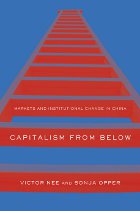 Capitalism from Below: Markets and Institutional Change in China
Victor Nee and Sonja Opper
Harvard University Press, 2012 More than 630 million Chinese have escaped poverty since the 1980s, reducing the fraction remaining from 82 to 10 percent of the population. This astonishing decline in poverty, the largest in history, coincided with the rapid growth of a private enterprise economy. Yet private enterprise in China emerged in spite of impediments set up by the Chinese government. How did private enterprise overcome these initial obstacles to become the engine of China’s economic miracle? Where did capitalism come from?
Studying over 700 manufacturing firms in the Yangzi region, Victor Nee and Sonja Opper argue that China’s private enterprise economy bubbled up from below. Through trial and error, entrepreneurs devised institutional innovations that enabled them to decouple from the established economic order to start up and grow small, private manufacturing firms. Barriers to entry motivated them to build their own networks of suppliers and distributors, and to develop competitive advantage in self-organized industrial clusters. Close-knit groups of like-minded people participated in the emergence of private enterprise by offering financing and establishing reliable business norms.
This rapidly growing private enterprise economy diffused throughout the coastal regions of China and, passing through a series of tipping points, eroded the market share of state-owned firms. Only after this fledgling economy emerged as a dynamic engine of economic growth, wealth creation, and manufacturing jobs did the political elite legitimize it as a way to jump-start China’s market society. Today, this private enterprise economy is one of the greatest success stories in the history of capitalism.
 Capitalism from Outside?: Economic Cultures in Eastern Europe after 1989
János Mátyás Kovács
Central European University Press, 2012 Does capitalism emerging in Eastern Europe need as solid ethnic or spiritual foundations as some other "Great Transformations" in the past? Apparently, one can become an actor of the new capitalist game without belonging to the German, Jewish, or, to take a timely example, Chinese minority. Nor does one have to go to a Protestant church every Sunday, repeat Confucian truisms when falling asleep, or study Adam Smith's teachings on the virtues of the market in a business course. He/she may just follow certain quasi-capitalist routines acquired during communism and import capitalist culture (more exactly, various capitalist cultures) in the form of down-to-earth cultural practices embedded in freshly borrowed economic and political institutions. Does capitalism come from outside? Why do then so many analysts talk about hybridization? This volume offers empirical insights into the current cultural history of the Eastern European economies in three fields: entrepreneurship, state governance and economic science. The chapters are based on large case studies prepared in the framework of an eight-country research project (funded by the European Commission, and directed jointly by the Center for Public Policy at the Central European University and the Institute for Human Sciences) on East-West cultural encounters in the ex-communist economies.
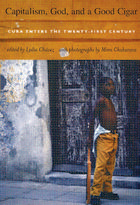 Capitalism, God, and a Good Cigar: Cuba Enters the Twenty-first Century
Lydia Chávez, ed.
Duke University Press, 2005 When the Soviet Union dissolved, so did the easy credit, cheap oil, and subsidies it had provided to Cuba. The bottom fell out of the Cuban economy, and many expected that Castro’s revolution—the one that had inspired the Left throughout Latin America and elsewhere—would soon be gone as well. More than a decade later, the revolution lives on, albeit in a modified form. Following the collapse of Soviet communism, Castro legalized the dollar, opened the island to tourism, and allowed foreign investment, small-scale private enterprise, and remittances from exiles in Miami. Capitalism, God, and a Good Cigar describes what the changes implemented since the early 1990s have meant for ordinary Cubans: hotel workers, teachers, priests, factory workers, rap artists, writers, homemakers, and others. Based on reporting by journalists, writers, and documentary filmmakers since 2001, each of the essays collected here covers a particular dimension of contemporary Cuban society, revealing what it is like to have lived, for more than a decade, suspended between communism and capitalism. There are pieces on hip hop musicians, fiction writing and censorship, the state of ballet and the performing arts, and the role of computers and the Internet. Other essays address the shrinking yet still sizeable numbers of true believers in the promise of socialist revolution, the legendary cigar industry, the changing state of religion, the significance of the recent influx of money and people from Spain, and the tensions between recent Cuban emigrants and previous generations of exiles. Including more than seventy striking documentary photographs of Cuba’s people, countryside, and city streets, this richly illustrated collection offers keen, even-handed insights into the abundant ironies of life in Cuba today. Contributors. Juliana Barbassa, Ana Campoy, Mimi Chakarova, Lydia Chávez, John Coté, Julian Foley, Angel González, Megan Lardner, Ezequiel Minaya, Daniela Mohor, Archana Pyati, Alicia Roca, Olga R. Rodríguez, Bret Sigler, Annelise Wunderlich
 Capitalism Hates You: Marxism and the New Horror Film
Joshua Gooch
University of Minnesota Press, 2025 What contemporary horror films teach us about the cruelties of capitalist society Capitalism Hates You uses the horror film genre as a tool to diagnose and expose the hostile conditions of life under capitalism. Through incisive critical analyses of popular films such as Get Out, Drag Me to Hell, Hereditary, The Babadook, and many others, Joshua Gooch draws connections between Marxist theory and contemporary narratives of psychological unease. Gooch highlights the work of women, trans, and nonwhite filmmakers to show how the remarkable diversity of twenty-first-century horror cinema can provide an expansive catalog of capitalism’s varying forms of oppression. Studying films that interrogate such urgent topics as gentrification, climate change, and reproductive labor, he demonstrates how contemporary horror films give affective shape to the negative undercurrents of our present socioeconomic system. Capitalism Hates You argues that these films and their material conditions can deepen our understanding of essential concepts in contemporary Marxism, from the theory of value and changing forms of commodification to the labor of social reproduction, the abolition of the family, and the necessity of ecosocialism. Synthesizing various strands of Marxist thought, Gooch sheds light on the growing field of socially conscious horror films, examining how they pinpoint and exaggerate latent feelings of dread and discomfort to reflect the ills of society. Retail e-book files for this title are screen-reader friendly with images accompanied by short alt text and/or extended descriptions.
 Capitalism in Context: Essays on Economic Development and Cultural Change in Honor of R.M. Hartwell
Edited by John A. James and Mark Thomas
University of Chicago Press, 1994 Following the approach of R. M. Hartwell, the influential historian of the British Industrial Revolution, these essays explore the cultural contexts and institutional constraints that have shaped growth and development over the past two centuries. Capitalism in Context offers new perspectives on why economic development took place where and when it did.
Thirteen chapters cover: social progress during economic development; the influence of cultural values on social and economic change; economic foundations of development—labor, capital, and technology; and organizational arrangements—property rights, government, and markets. These studies will appeal to economists, historians, and social scientists alike for their wide-ranging treatments of economic development and cultural change.
The contributors are N. F. R. Crafts, Lance E. Davis, Stanley L. Engerman, David W. Galenson, Robert E. Gallman, Stephen Innes, John A. James, Eric L. Jones, Thomas W. Laqueur, Gary D. Libecap, Joel Mokyr, Douglass C. North, Mark Thomas, John J. Wallis, Jeffrey G. Williamson.
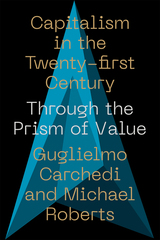 Capitalism in the 21st Century: Through the Prism of Value
Michael Roberts
Pluto Press, 2022 A sweeping, authoritative, and accessible overview of major issues in the global economy from a Marxist perspective.
Contemporary capitalism is always evolving. From digital technologies to cryptocurrencies, current trends in political economy are much discussed, but often little understood. So where can we turn for clarity? As Michael Roberts and Guglielmo Carchedi argue, new trends don't necessarily call for a new theory.
In Capitalism in the 21st Century, the authors show how Marx's law of value explains numerous issues in our modern world. In both advanced economies and the periphery, value theory provides a piercing analytical framework through which we can approach topics as varied as labor, profitability, technology, the environment, the role of China, imperialism, and the state.
An ambitious work that will appeal to both heterodox economists and labor movement activists alike, as it demonstrates the ongoing contemporary relevance of Marxist theory to current trends in political economy.
 Capitalism, Not Globalism: Capital Mobility, Central Bank Independence, and the Political Control of the Economy
William Roberts Clark
University of Michigan Press, 2009 Capitalism, Not Globalism shows that, while much has been made of recent changes in the international economy, the mechanisms by which politicians control the economy have not changed throughout the postwar period. Challenging both traditional and revisionist globalization theorists, William Roberts Clark argues that increased financial integration has led to neither a widening nor a narrowing of partisan differences in macroeconomic polices or outcomes. Rather, he shows that the absence of partisan differences in macroeconomic policy is a long-standing feature of democratic capitalist societies that can be traced to politicians' attempts to use the economy to help them survive in office.
Changes in the structural landscape such as increased capital mobility and central bank independence do not necessarily diminish the ability of politicians to control the economy, but they do shape the strategies they use to do so. In a world of highly mobile capital, politicians manipulate monetary policy to create macroeconomic expansions prior to elections only if the exchange rate is flexible and the central bank is subservient. But they use fiscal policy to induce political business cycles when the exchange rate is fixed or the central bank is independent.
William Roberts Clark is Assistant Professor, Department of Politics, New York University.
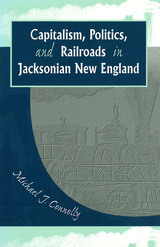 Capitalism, Politics, and Railroads in Jacksonian New England
Michael J. Connolly
University of Missouri Press, 2003
In this engaging new study, Michael J. Connolly seeks to understand the interrelationships among political change, economic interests, and railroad development in northern New England prior to the Civil War. He analyzes the political thought of the region as it involved the growth of party confrontations—among the Radical Democrats in New Hampshire, the Whigs and Conservative Democrats in New Hampshire, and the Whigs in Essex County, Massachusetts—and the rise of voting activity. An assortment of antebellum demographic data on the various railroad lines is made clear by the maps in the book.
New England was an older region with settled patterns of political economy, and innovations like the railroad forced antebellum citizens to alter their patterns of life. Jacksonian Democrats debated among themselves the wisdom of railroad technology, its influence on political power, and its effect on regional economies, remaining skeptical about how this invention would improve their lives. They voiced serious concern that railroads would shrink private rights and destroy the existing “liberal capitalist” economy, all the while making northern New Englanders the minions of business interests far away in Boston and Canada. These concerns separated them from the Whigs.
Whigs remained ebullient over how railroads would transform their political and economic lives, improve the lot of every New Englander in the long run, and rescue a dying region from social oblivion. They believed that danger came in not developing railroads. Whigs were willing to extend public power to a remarkable extent: bridges were destroyed, courthouses demolished, land and buildings taken to make way for railroads. Less sophisticated in economic understanding than the Jacksonians, Whigs never worried over “illiberal capitalism”; they welcomed it. The great consensus between Jacksonians and Whigs was capitalism. No one opposed markets.
The antebellum conflict was not about whether America should be a market society, but what shape those markets should take; not about whether government should have power over private rights, but to what extent states could impose on private citizens. At the center of this debate was the railroad.
Providing an excellent view of the economics of railroad development and how it affected the factory and farm world of northern New England, Capitalism, Politics, and Railroads in Jacksonian New England makes a major contribution to our full understanding of the coming of the Civil War.
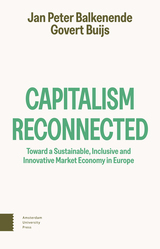 Capitalism Reconnected: Toward a Sustainable, Inclusive and Innovative Market Economy in Europe
Jan Peter Balkenende
Amsterdam University Press, 2024 Capitalism has gone astray. Today we face ecological exhaustion, persistent inequality, financialization, stress on communities, short-termism, and new power concentrations.
An avalanche of new economic thinking and a reorientation of European values show the way toward a different economy. A new perspective is necessary if we want to implement the Sustainable Development Goals and if we consider our planet as ‘Our Common Home,’ for present and future generations.
This book argues that European economies should be the initiators of a global transition toward a sustainable and inclusive world economy. Together, amid severe geopolitical and geoeconomic challenges, they need to develop their own perspective on what a good economy really is, in distinction to Chinese state capitalism and American big business capitalism. Crucially, this requires the rediscovery of key European values, a coherent view on responsible capitalism, and a new self-awareness as a global player for the Common Good in today’s and tomorrow’s world.
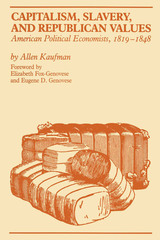 Capitalism, Slavery, and Republican Values: American Political Economists, 1819-1848
By Allen Kaufman
University of Texas Press, 1982 In the troubled days before the American Civil War, both Northern protectionists and Southern free trade economists saw political economy as the key to understanding the natural laws on which every republican political order should be based. They believed that individual freedom was one such law of nature and that this freedom required a market economy in which citizens could freely pursue their particular economic interests and goals. But Northern and Southern thinkers alike feared that the pursuit of wealth in a market economy might lead to the replacement of the independent producer by the wage laborer. A worker without property is a potential rebel, and so the freedom and commerce that give birth to such a worker would seem to be incompatible with preserving the content citizenry necessary for a stable, republican political order. Around the resolution of this dilemma revolved the great debate on the desirability of slavery in this country. Northern protectionists argued that independent labor must be protected at the same time that capitalist development is encouraged. Southern free trade economists answered that the formation of a propertyless class is inevitable; to keep the nation from anarchy and rebellion, slavery—justified by racism—must be preserved at any cost. Battles of the economists such as these left little room for political compromise between North and South as the antebellum United States confronted the corrosive effects of capitalist development. And slavery's retardant effect on the Southern economy ultimately created a rift within the South between those who sought to make slavery more like capitalism and those who sought to make capitalism more like slavery.
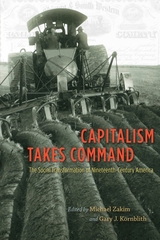 Capitalism Takes Command: The Social Transformation of Nineteenth-Century America
Edited by Michael Zakim and Gary J. Kornblith
University of Chicago Press, 2011 Most scholarship on nineteenth-century America’s transformation into a market society has focused on consumption, romanticized visions of workers, and analysis of firms and factories. Building on but moving past these studies, Capitalism Takes Command presents a history of family farming, general incorporation laws, mortgage payments, inheritance practices, office systems, and risk management—an inventory of the means by which capitalism became America’s new revolutionary tradition. This multidisciplinary collection of essays argues not only that capitalism reached far beyond the purview of the economy, but also that the revolution was not confined to the destruction of an agrarian past. As business ceaselessly revised its own practices, a new demographic of private bankers, insurance brokers, investors in securities, and start-up manufacturers, among many others, assumed center stage, displacing older elites and forms of property. Explaining how capital became an “ism” and how business became a political philosophy, Capitalism Takes Command brings the economy back into American social and cultural history.
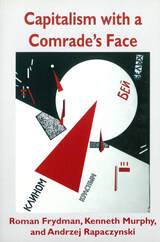 Capitalism with a Comrade's Face
Kenneth Murphy
Central European University Press, 1998 Are nations that are journeying away from communism succeeding in becoming free-market democracies? In what ways do decades of totalitarian rule continue to distort the institutional shape of these societies? Which of communism's legacies may remain as permanent features of their landscape? In an effort to answer these questions, Roman Frydman, Kenneth Murphy, and Andrzej Rapaczynski analyze the turbulent transitions that have taken place in the post-Communist world since the revolutions of 1989-1991. Each of the essays in this collection dissects the institutional upheaval in a particular institution in transition, such as central banking, the trade union movement, capital markets, or corporate govern-ance. In a lively and accessible style, the authors bring out the links between what was and what will be in the social fabric of Eastern Europe and the former Soviet Union. They expose the fragility of political and economic institutions that can easily threaten the region's rebirth, but they also believe that many post-Communist countries are successfully seizing the opportunity to become reunited with the West and the global economy. With both sweeping perspective and critical depth, Frydman, Murphy, and Rapaczynski show the wide range of institutional improvisations under way. They weigh the advantages and disadvantages of different reform strategies and assess the role of politics in fostering or arresting the process of transformation. Each essay illuminates the pro-found difficulties of reconciling the needs of economic development with the special interests fighting for their survival.
Capitalism with a Human Face
Samuel Brittan
Harvard University Press, 1996 Sir Samuel Brittan, the doyen of British economic journalists, explores the connections between economics, ethics, and politics while assessing the merits and defects of capitalism in this post-socialist era.
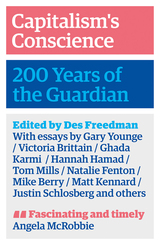 Capitalism's Conscience: 200 Years of the Guardian
Des Freedman
Pluto Press, 2021 'A lively and well-researched history and critique' - Jonathan Steele, former Chief Foreign Correspondent for the Guardian
Since its inception in Manchester in 1821 as a response to the 1819 Peterloo Massacre, the Guardian has been a key institution in the definition and development of liberalism. The stereotype of the 'Guardianista', an environmentally-conscious, Labour-voting, progressively-minded public sector worker endures in the popular mythology of British press history.
Yet the title has a complex lineage and occupies an equivocal position between capital and its opponents. It has both fiercely defended the need for fearless, independent journalism and handed over documents to the authorities; it has carved out a niche for itself in the UK media as a progressive voice but has also consistently diminished more radical projects on the left.
Published to coincide with its 200th anniversary, Capitalism's Conscience brings together historians, journalists and activists in an appraisal of the Guardian's contribution to British politics, society and culture - and its distinctive brand of centrism. Contextualising some of the main controversies in which the title has been implicated, the book offers timely insights into the publication's history, loyalties and political values.
Capitalism's New Clothes: Enterprise, Ethics and Enjoyment in Times of Crisis
Colin Cremin
Pluto Press, 2011 From broadsheet newspapers to television shows and Hollywood films, capitalism is increasingly recognised as a system detrimental to human existence. Colin Cremin investigates why, despite this de-robing, capitalism remains a powerful and seductive force.
Using materialist, psychoanalytic and linguistic approaches, Cremin shows how capitalism, anxiety and desire enter into a mutually supporting relationship. He identifies three ways in which we are tied in to capitalism – through a social imperative for enterprise and competition; through enjoyment and consumption; and through the depoliticisation of ethical debate by government and business.
Capitalism's New Clothes is ideal for students of sociology and for anyone worried about the ethics of capitalism or embarrassed by the enjoyments the system has afforded them.
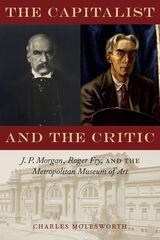 The Capitalist and the Critic: J. P. Morgan, Roger Fry, and the Metropolitan Museum of Art
By Charles Molesworth
University of Texas Press, 2016 A skillful and fascinating retelling of the often testy relationship between J. P. Morgan and Roger Fry, two men who did more to establish the preeminence of the Metropolitan Museum of Art than any collector and curator before or since.
Shortly after the turn of the twentieth century, the Metropolitan Museum of Art began an ambitious program of collection building and physical expansion that transformed it into one of the world’s foremost museums, an eminence that it has maintained ever since. Two men of singular qualities and accomplishments played key roles in the Met’s transformation—J. P. Morgan, America’s leading financier and a prominent art collector, and Roger Fry, the headstrong English expert in art history who served as the Met’s curator of painting. Their complicated, often contentious relationship embodies and illuminates the myriad tensions between commerce and art, philanthropists and professional staff, that a great museum must negotiate to define and fulfill its mission. In this masterful, multidisciplinary narrative, Charles Molesworth offers the first in-depth look at how Morgan and Fry helped to mold the cultural legacy of masterpieces of painting and the development of the “encyclopedic” museum. Structuring the book as a joint biography, Molesworth describes how Morgan used his vast wealth to bring European art to an American citizenry, while Fry brought high standards of art history from the world of connoisseurs to a general public. Their clashes over the purpose and functions of the Met, which ultimately led to Fry’s ouster, reveal the forces—personal and societal—that helped to shape the Metropolitan Museum and other major American cultural institutions during the twentieth century.
 Capitalist Development and Democracy
Dietrich Rueschemeyer, Evelyne Huber Stephens, and John D. Stephens
University of Chicago Press, 1992 It is a commonplace claim of Western political discourse that capitalist development and democracy go hand in hand. Cross-national statistical research on political democracy supports this claim. By contrast, comparative historical studies carried out within a political economy approach argue that economic development was and is compatible with multiple political forms.
The authors offer a fresh and persuasive resolution to the controversy arising out of these contrasting traditions. Focusing on advanced industrial countries, Latin America, and the Caribbean, they find that the rise and persistence of democracy cannot be explained either by an overall structural correspondence between capitalism and democracy or by the role of the bourgeoisie as the agent of democratic reform. Rather, capitalist development is associated with democracy because it transforms the class structure, enlarging the working and middle classes, facilitating their self-organization, and thus making it more difficult for elites to exclude them. Simultaneously, development weakens the landed upper class, democracy's most consistent opponent.
The relationship of capitalist development to democracy, however, is not mechanical. As the authors show, it depends on a complex interplay of three clusters of power: the balance of power among social classes, power relations between the state and society, and transnational structures of economic and political power. Looking to the future, the book concludes with some reflections on current prospects for the development of stable democracy in Latin America and Eastern Europe.
 Capitalist Humanitarianism
Lucia Hulsether
Duke University Press, 2023 The struggle against neoliberal order has gained momentum over the last five decades---to the point that economic elites have not only adapted to the Left's critiques but incorporated them for capitalist expansion. Venture funds expose their ties to slavery and pledge to invest in racial equity. Banks pitch microloans as a path to indigenous self-determination. Fair-trade brands narrate consumption as an act of feminist solidarity with women artisans in the global South. In Capitalist Humanitarianism Lucia Hulsether examines these projects and the contexts of their emergence. Blending historical and ethnographic styles, and traversing intimate and global scales, Hulsether tracks how neoliberal self-critique creates new institutional hegemonies that, in turn, reproduce racial and neocolonial dispossession. From the archives of Christian fair traders to luxury social entrepreneurship conferences, from US finance offices to Guatemalan towns flooded with their loan products, from service economy desperation to the internal contradictions of social movements, Hulsether argues that capitalist humanitarian projects are fueled as much by a profit motive as by a hope that racial capitalism can redeem the losses that accumulate in its wake.
The Capitalist Imaginaries of Popular Music
Charles Fairchild
Intellect Books, 2025 Revelations of neoliberal capitalism’s effects on pop music, challenging its longstanding status as defying the status quo.
Traditionally, popular music has long been said to intrinsically contest, resist, and defy the powers that be. This new book challenges this long-standing orthodoxy, arguing that popular music is not so much a form of resistance to authority, but it often perpetuates the very power it is supposed to be raging against: neoliberal capitalism.
This misconception of popular music came to dominance in the mid-1980s and persists today, even when the vast majority of people have been disempowered, impoverished, and marginalized at home, at work, and in politics. This book explains why such a robust, pervasive, and persistent set of ideas about popular music has taken such a tenacious hold despite substantive evidence to the contrary.
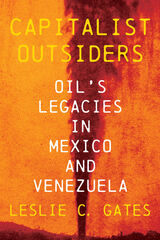 Capitalist Outsiders: Oil's Legacy in Mexico and Venezuela
Leslie Gates
University of Pittsburgh Press, 2023 Social polarization has roiled neoliberal political establishments but has rarely culminated in electoral victories for anticapitalist outsiders. Instead, outsiders who accommodate capitalists often prevail. Capitalist Outsiders revisits celebrated exemplars of Latin American populism in Mexico and Venezuela to shed light on this phenomenon. It reveals how anticorruption campaigns boosted Mexico’s neoliberal-era capitalist outsider by drowning out salacious corporate scandals; how Venezuela’s apparently enlightened capitalist outsiders of the 1940s relied on segregationist, punitive labor relations; and how corporate insiders of Venezuela’s neoliberal political establishment unwittingly validated the anticapitalist Hugo Chávez as the true outsider. It weaves together these case studies to reveal an unlikely common origin for capitalist outsiders in both countries: their sequential insertion into global oil production and Mexico’s early twentieth-century radical oil workers. Capitalist Outsiders moves beyond cataloging “populist” traits and tactics or devising the institutions that might avert their rise. Instead, it specifies the distinct social bases of capitalist vs. anticapitalist outsiders. It exposes how a nation’s earlier incorporation into the capitalist world economy casts a long shadow over neoliberal-era outsider politics.
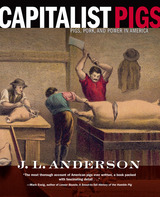 Capitalist Pigs: Pigs, Pork, and Power in America
J. L. Anderson
West Virginia University Press, 2019 Pigs are everywhere in United States history. They cleared frontiers and built cities (notably Cincinnati, once known as Porkopolis), served as an early form of welfare, and were at the center of two nineteenth-century “pig wars.” American pork fed the hemisphere; lard literally greased the wheels of capitalism. J. L. Anderson has written an ambitious history of pigs and pig products from the Columbian exchange to the present, emphasizing critical stories of production, consumption, and waste in American history. He examines different cultural assumptions about pigs to provide a window into the nation’s regional, racial, and class fault lines, and maps where pigs are (and are not) to reveal a deep history of the American landscape. A contribution to American history, food studies, agricultural history, and animal studies, Capitalist Pigs is an accessible, deeply researched, and often surprising portrait of one of the planet’s most consequential interspecies relationships.
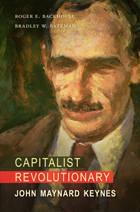 Capitalist Revolutionary: John Maynard Keynes
Roger E. Backhouse and Bradley W. Bateman
Harvard University Press, 2011 The Great Recession of 2008 restored John Maynard Keynes to prominence. After decades when the Keynesian revolution seemed to have been forgotten, the great British theorist was suddenly everywhere. The New York Times asked, “What would Keynes have done?” The Financial Times wrote of “the undeniable shift to Keynes.” Le Monde pronounced the economic collapse Keynes’s “revenge.” Two years later, following bank bailouts and Tea Party fundamentalism, Keynesian principles once again seemed misguided or irrelevant to a public focused on ballooning budget deficits. In this readable account, Backhouse and Bateman elaborate the misinformation and caricature that have led to Keynes’s repeated resurrection and interment since his death in 1946.
Keynes’s engagement with social and moral philosophy and his membership in the Bloomsbury Group of artists and writers helped to shape his manner of theorizing. Though trained as a mathematician, he designed models based on how specific kinds of people (such as investors and consumers) actually behave—an approach that runs counter to the idealized agents favored by economists at the end of the century.
Keynes wanted to create a revolution in the way the world thought about economic problems, but he was more open-minded about capitalism than is commonly believed. He saw capitalism as essential to a society’s well-being but also morally flawed, and he sought a corrective for its main defect: the failure to stabilize investment. Keynes’s nuanced views, the authors suggest, offer an alternative to the polarized rhetoric often evoked by the word “capitalism” in today’s political debates.
Capitalist Workingman's Paradises Revisited: Corporate Welfare Work in Great Britain, the USA, Germany and France in the Golden Age of Capitalism, 1880-1930
Erik de Gier
Amsterdam University Press, 2016 This book offers an in-depth exploration of the international phenomenon of enlightened paternalist capitalism and social engineering in the golden age of capitalism in the United States, United Kingdom, Germany, and France. Erik de Gier shows how utopian socialist, religious, and craft-based ideas influenced the welfare work and educations programmes offered by paternalistic businesses in different ways from nation to nation, looking closely at sites like the Pullman community in Chicago and Port Sunlight in the UK. De Gier brings the book fully up to date with a brief comparison to contemporary welfare capitalism in our highly flexible working world.
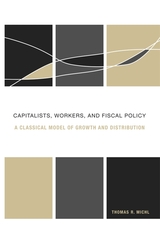 Capitalists, Workers, and Fiscal Policy: A Classical Model of Growth and Distribution
Thomas R. Michl
Harvard University Press, 2009 Drawing on the work of the classical-Marxian economists and their modern successors, Capitalists, Workers, and Fiscal Policy sets forth a new model of economic growth and distribution, and applies it to two major policy issues: public debt and social security.
The book homes in specifically on the problem of fiscal policy, examining the ways that taxation and government spending affect the distribution of wealth and income as well as the rate of economic growth. Thomas Michl’s model shows that public debt has a regressive effect on wealth distribution. It also demonstrates that the accumulation of wealth by public authorities, for example, in the form of a pension reserve such as the U.S. social security trust fund, can have a progressive effect on wealth distribution, both directly (since it represents ownership by the citizenry) and indirectly through its general equilibrium effects on the structure of accumulation. The book’s findings provide an analytical foundation for a macroeconomic policy of using fiscal surpluses to accumulate a public pension reserve fund that serves to effect a progressive redistribution of wealth.
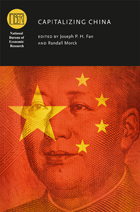 Capitalizing China
Edited by Joseph P. H. Fan and Randall Morck
University of Chicago Press, 2012 China’s economic boom over the last two decades has taken many analysts by surprise, given the ongoing role of central government planning. Its current growth trajectory suggests that the size of its economy could soon surpass that of the United States. Some argue that continued growth and the expanding middle class will ultimately exert pressure on the government to bring about greater openness of the financial market. To better understand China’s recent economic performance, this volume examines the distinctive system it has developed: “market socialism with Chinese characteristics.” While its formal institutional makeup resembles that of a free-market economy, many of its practices remain socialist, including strategically placed state-owned enterprises that wield influence both directly and through controlled business groups, and Communist Party cells whose purpose is to maintain control of many segments of the economy. China’s economic system, the contributors find, also retains many historical characteristics that play a central role in managing the economy. These and other issues are examined in chapters on China’s financial regulations, corporate governance codes, bankruptcy laws, taxation, and disclosure rules.
 Capitalizing on Crisis: The Political Origins of the Rise of Finance
Greta R. Krippner
Harvard University Press, 2011 In the context of the recent financial crisis, the extent to which the U.S. economy has become dependent on financial activities has been made abundantly clear. In Capitalizing on Crisis, Greta Krippner traces the longer-term historical evolution that made the rise of finance possible, arguing that this development rested on a broader transformation of the U.S. economy than is suggested by the current preoccupation with financial speculation.
Krippner argues that state policies that created conditions conducive to financialization allowed the state to avoid a series of economic, social, and political dilemmas that confronted policymakers as postwar prosperity stalled beginning in the late 1960s and 1970s. In this regard, the financialization of the economy was not a deliberate outcome sought by policymakers, but rather an inadvertent result of the state’s attempts to solve other problems. The book focuses on deregulation of financial markets during the 1970s and 1980s, encouragement of foreign capital into the U.S. economy in the context of large fiscal imbalances in the early 1980s, and changes in monetary policy following the shift to high interest rates in 1979.
Exhaustively researched, the book brings extensive new empirical evidence to bear on debates regarding recent developments in financial markets and the broader turn to the market that has characterized U.S. society over the last several decades.
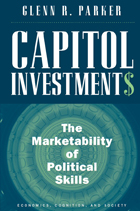 Capitol Investments: The Marketability of Political Skills
Glenn R. Parker
University of Michigan Press, 2011 What would you do if, the very day you were hired, you knew you could be unemployed in as little as two years? You'd seek opportunities in your current job to develop a portfolio of skills and contacts in order to make yourself more attractive to future employers. Representatives and senators think about their jobs in Congress in this way, according to Glenn R. Parker. While in office, members of Congress plan not merely for the next election but for the next stage of their careers. By networking, serving on committees, and championing particular legislation, they deliberately accumulate human capital---expertise, networks, and reputation---which later will give them bargaining power in the job market. Parker's study of the postelective careers of more than 200 former members of Congress, both U.S. representatives and senators, who have left office during the last half century shows that such strategic planning generally succeeds. In most cases, the human capital these politicians amassed while in office increased their occupational mobility and earning power. Capitol Investments offers a sophisticated yet accessible analysis of the acquisition and marketability of political skills. It suggests that an awareness of the trade in human capital shapes an officeholder's actions as much as the desire to win another election. Glenn R. Parker is Distinguished Professor in the Department of Political Science at Purdue University.
Capitol Punishment: An Andy Hayes Mystery
Andrew Welsh-Huggins
Ohio University Press, 2016 The job seems simple enough: Reporter Lee Hershey needs protection for a couple of weeks as he pursues the biggest story of his career with all eyes on swing state Ohio in the midst of a presidential election. Columbus private eye Andy Hayes, broke as usual, doesn’t have much choice but to sign on, even with his girlfriend falling for the charming journalist. Then murder strikes at the Statehouse and Andy finds himself partly responsible for the death. With an innocent man behind bars, a mysterious vehicle following Andy around the city, and more lives in danger, the detective has his hands full trying to solve a killing in a poisonous political environment where everyone has a motive for murder and anyone could be the next target.
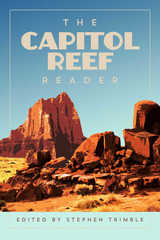 The Capitol Reef Reader
Stephen Trimble
University of Utah Press, 2019 For 12,000 years, people have left a rich record of their experiences in Utah’s Capitol Reef National Park. In The Capitol Reef Reader, award-winning author and photographer Stephen Trimble collects the best of this writing—160 years worth of words that capture the spirit of the park and its surrounding landscape in personal narratives, philosophical riffs, and historic and scientific records.
The volume features nearly fifty writers who have anchored their attention and imagination in Utah’s least-known national park. The bedrock elders of Colorado Plateau literature are here (Clarence Dutton, Wallace Stegner, Edward Abbey), as are generations of writers who love this land (including Ellen Meloy, Craig Childs, Charles Bowden, Renny Russell, Ann Zwinger, Gary Ferguson, and Rose Houk). Their pieces are a pleasure to read and each reveals a facet of Capitol Reef’s story, creating a gem of a volume. Editor Stephen Trimble guides and orients with commentary and context.
A visual survey of the park in almost 100 photographs adds another layer to our understanding of this place. Historic photos, pictures from Trimble’s forty-five years of hiking the park, as well as images from master visual artists who have worked in Capitol Reef are included. No other book captures the essence of Capitol Reef like this one.
Part of the National Park Reader series, edited by Lance Newman and David Stanley
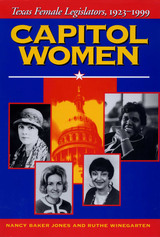 Capitol Women: Texas Female Legislators, 1923-1999
By Nancy Baker Jones and Ruthe Winegarten
University of Texas Press, 2000 Along with bar rooms and bordellos, there has hardly been a more male-focused institution in Texas history than the Texas Legislature. Yet the eighty-six women who have served there have made a mark on the institution through the legislation they have passed, much of which addresses their concerns as citizens who have been inadequately represented by male lawmakers. This first complete record of the women of the Texas Legislature places such well-known figures as Kay Bailey Hutchison, Sissy Farenthold, Barbara Jordan, Irma Rangel, Eddie Bernice Johnson, Susan Combs, and Judith Zaffirini in the context of their times and among the women and men with whom they served. Drawing on years of primary research and interviews, Nancy Baker Jones and Ruthe Winegarten offer concise biographies and profiles of all eighty-six women who have served or currently hold office in the Texas Legislature. The biographies describe the women lawmakers' lives, campaign strategies, and legislative successes and defeats. Four introductory essays provide historical and cultural context for the biographies, which are arranged chronologically to give a sense of the passage of time, of relationships among and between women, and of the issues of their eras.
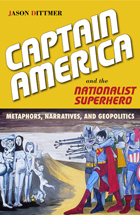 Captain America and the Nationalist Superhero: Metaphors, Narratives, and Geopolitics
Jason Dittmer
Temple University Press, 2012 Nationalist superheroes—such as Captain America, Captain Canuck, and Union Jack—often signify the “nation-state” for readers, but how do these characters and comic books address issues of multiculturalism and geopolitical order? In his engaging book Captain America and the Nationalist Superhero, geographer Jason Dittmer traces the evolution of the comic book genre as it adapted to new national audiences. He argues that these iconic superheroes contribute to our contemporary understandings of national identity, the righteous use of power, and the role of the United States, Canada, and Britain in the world. Tracing the nationalist superhero genre from its World War II origins to contemporary manifestations throughout the world, Captain America and the Nationalist Superhero analyzes nearly one thousand comic books and audience responses to those books. Dittmer also interviews key comic book writers from Stan Lee and J. M. DeMatteis to Steve Englehart and Paul Cornell. At a time when popular culture is saturated with superheroes and their exploits, Captain America and the Nationalist Superhero highlights the unique relationship between popular culture and international relations.
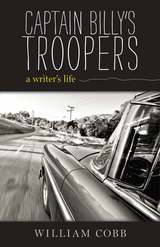 Captain Billy's Troopers: A Writer's Life
William Cobb
University of Alabama Press, 2015 Opens a candid window into the life of a writer and teacher who overcame years of addiction and serious health problems as his voice, artistic vision, and sense of self evolved and matured
In this audacious memoir, William Cobb reveals the tumultuous creative life of a distinguished practitioner of southern and Alabama storytelling. As poignant and inspiring as his own fiction, Captain Billy’s Troopers traces Cobb’s early life, education, and struggles with alcohol and the debilitating condition normal pressure hydrocephalus (NPH).
Like a curving river, the broad sweep of Cobb’s turbulent life includes both startling cataracts and desultory eddies, leading sometimes into shadows or opening into unexpected sunlight. With unsentimental clarity, Cobb recounts coming of age in his native Demopolis in the churning middle years of the twentieth century. It’s there he has his first tantalizing tastes of alcohol and begins to drink habitually. Readers then travel with Cobb to Livingston University (now the University of West Alabama) and then on to Vanderbilt University. Along the way, readers relish his first experiences of love and success as a writer, leading to a career as a professor of writing at Alabama College (now the University of Montevallo) in 1963.
From there Cobb’s struggles with alcohol and depression lead to elongated years of tumbling creative output and the collapse of his marriage. The summer of 1984 found Cobb in rehab, the first step in his path to recovery. His unflinching memoir narrates both the milestones and telling details of his intense therapy and years in Alcoholics Anonymous (AA). In the sober thirty years since, Cobb has published a string of critically praised novels and a prize-winning collection of short stories. The capstone of his comeback was winning the Harper Lee Award in 2007 for distinguished fiction writing.
In 2000, shortly after retiring, Cobb developed NPH, which upset his sense of balance and triggered dementia symptoms and other maladies. Nine years later in 2009, brain surgery brought Cobb a dramatic recovery, which began the third act in his writing career. Vital, honest, and entertaining, Captain Billy’s Troopers captures the life of an Alabama original.
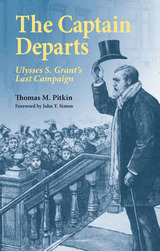 The Captain Departs: Ulysses S. Grant's Last Campaign
Thomas M. Pitkin. Foreword by John Y. Simon
Southern Illinois University Press, 1973 Early in 1885 Americans learned that General Grant was writing his Memoirs in a desperate race for time against an incurable cancer. Not generally known was the General’s precarious personal finances, made so by imprudent investments, and his gallant effort to provide for his family by his writing. For six months newspaper readers followed the dramatic contest, and the hearts of Americans were touched by the General’s last battle. Grant’s last year was one of both personal and literary triumph in the midst of tragedy, as Thomas M. Pitkin shows in this memorable and inspiring book. The Memoirs was completed; its remarkable literary quality made ita triumph. Ultimately more than 300,000sets of the two-volume work were sold. And Grant accepted the inevitable with quiet courage, and faded away in a manner sadly familiar to many American families. Though told without maudlin touches, the story of Grant’s last year will leave few readers emotionally uninvolved, for itis an account of pain and suffering as well as mighty deeds, and truly deserves to be considered the General’s final victory.
 Captain Kidd and the War against the Pirates
Robert Ritchie
Harvard University Press, 1989 The legends that die hardest are those of the romantic outlaw, and those of swashbuckling pirates are surely among the most durable. Swift ships, snug inns, treasures buried by torchlight, palm-fringed beaches, fabulous riches, and, most of all, freedom from the mean life of the laboring man are the stuff of this tradition reinforced by many a novel and film.
It is disconcerting to think of such dashing scoundrels as slaves to economic forces, but so they were—as Robert Ritchie demonstrates in this lively history of piracy. He focuses on the shadowy figure of William Kidd, whose career in the late seventeenth century swept him from the Caribbean to New York, to London, to the Indian Ocean before he ended in Newgate prison and on the gallows. Piracy in those days was encouraged by governments that could not afford to maintain a navy in peacetime. Kidd’s most famous voyage was sponsored by some of the most powerful men in England, and even though such patronage granted him extraordinary privileges, it tied him to the political fortunes of the mighty Whig leaders. When their influence waned, the opposition seized upon Kidd as a weapon. Previously sympathetic merchants and shipowners did an about-face too and joined the navy in hunting down Kidd and other pirates.
By the early eighteenth century, pirates were on their way to becoming anachronisms. Ritchie’s wide-ranging research has probed this shift in the context of actual voyages, sea fights, and adventures ashore. What sort of men became pirates in the first place, and why did they choose such an occupation? What was life like aboard a pirate ship? How many pirates actually became wealthy? How were they governed? What large forces really caused their downfall?
As the saga of the buccaneers unfolds, we see the impact of early modern life: social changes and Anglo-American politics, the English judicial system, colonial empires, rising capitalism, and the maturing bureaucratic state are all interwoven in the story. Best of all, Captain Kidd and the War against the Pirates is an epic of adventure on the high seas and a tale of back-room politics on land that captures the mind and the imagination.
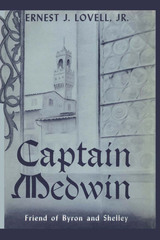 Captain Medwin: Friend of Byron and Shelley
By Ernest J. Lovell
University of Texas Press, 1962 Here is the first biography of Thomas Medwin—literary adventurer, rascal, scholar, confidence man, successful fortune hunter, and bemused speculator on a grand scale in old Italian oil paintings. Poet, novelist, translator of Aeschylus, cousin and boyhood friend of the poet Shelley, he was a man of fiery temper, fierce hatreds, and enduring loves. Although an intimate friend of Lord Byron, he was so dangerous (or disreputable) that his Lordship warned Teresa Guiccioli, his last mistress, not to be alone in Medwin's company. Later, Medwin introduced Byron's daughter to her future husband, Lord Lovelace, and so determined the poet's line of descent. Friend of Washington Irving, gentleman of the old school, neglected Boswell of the nineteenth century, Medwin reported the conversations of Byron, Shelley, Trelawny, Hazlitt, Canova the sculptor, and others. His life and adventures light up little-known aspects of the nineteenth-century literary, military, social, and publishing world—in England, India, Italy, France, Switzerland, and Germany. Medwin served as midwife to the words of a dead man—Lord Byron—who returned to laugh and sneer at the living from the Captain's pages. The Conversations of Lord Byron thus became the most controversial book of the day, going through a dozen editions, in six countries, and being translated into French, German, and Italian. It aroused the wrath, indignation, or enthusiastic interest of such individuals as Goethe, Lady Byron, Lady Caroline Lamb, the Countess Teresa Guiccioli, John Cam Hobhouse (later Lord Broughton), Sir Walter Scott, John Murray, and Washington Irving. Medwin, whose long and adventurous life extended from the rise and flowering of the Romantic Period to the mid-Victorian Age (which he regarded as a dreary decline from the great heights of his youth), was an influence of the first magnitude in determining the early public image of Byron and the reputation of Shelley. This often amusing story, as engrossing as a novel, is drawn from all the available accounts, including many important sources never before published. In effect a new contribution to the biographical study of Byron and Shelley, it clarifies Medwin's relations not only with these two poets but also with many other important and interesting figures of the day.
 Captain Paul Cuffe, Yeoman: A Biography
Jeffrey A. Fortin
University of Massachusetts Press, 2024 Paul Cuffe is best understood as a member of the Black founding fathers—a group of pre-eminent African Americans who built institutions and movements during the first decades of the United States. While he is known amongst scholars, his astounding life story deserves a much wider audience. Jeffrey A. Fortin has crafted a beautiful, moving portrait of this important maritime figure that will appeal to anyone interested in early American history and who loves great story telling.
Born on Cuttyhunk Island, Massachusetts in 1759 to a formerly enslaved African father and a Wampanoag Indian mother, Cuffe emerged from anonymity to become the most celebrated African-American sea captain during the Age of Sail. An abolitionist, veteran, and community activist, celebrity followed Cuffe as he built a shipping empire that traded both in American coastal waters and across the wider Atlantic Ocean. Cuffe and his Black crews shook the foundations of systemic racism, challenging norms by sailing into Charleston and other ports where slavery was legal, and thus demonstrating that business and profits were more powerful than social limitations. He founded America’s first racially integrated school in Westport, Massachusetts, and is considered the leader of the nation’s first back-to-Africa movement. Newspapers in England, the United States, and the Caribbean reported his whereabouts and adventures, and abolitionists hailed him for his Quaker beliefs, sobriety, and commitment to advancing opportunities for persons of African descent.
Drawing on pamphlets, letters, and other documents, and painstakingly reconstructing his genealogy, Fortin vividly describes Cuffe’s experiences and places them within the broader history of the Early Republic to help reveal the central role of African Americans in the founding of the United States. Unlike previous biographies, Fortin situates Cuffe within an Atlantic world where race and identity were fluid, and Africans and African Americans sought to build and govern a free Black nation in West Africa.
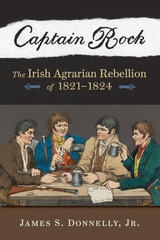 Captain Rock: The Irish Agrarian Rebellion of 1821–1824
James S. Donnelly, Jr.
University of Wisconsin Press, 2009 Named for its mythical leader “Captain Rock,” avenger of agrarian wrongs, the Rockite movement of 1821–24 in Ireland was notorious for its extraordinary violence. In Captain Rock, James S. Donnelly, Jr., offers both a fine-grained analysis of the conflict and a broad exploration of Irish rural society after the French revolutionary and Napoleonic wars.
Originating in west Limerick, the Rockite movement spread quickly under the impact of a prolonged economic depression. Before long the insurgency embraced many of the better-off farmers. The intensity of the Rockites’ grievances, the frequency of their resort to sensational violence, and their appeal on such key issues as rents and tithes presented a nightmarish challenge to Dublin Castle—prompting in turn a major reorganization of the police, a purging of the local magistracy, the introduction of large military reinforcements, and a determined campaign of judicial repression. A great upsurge in sectarianism and millenarianism, Donnelly shows, added fuel to the conflagration. Inspired by prophecies of doom for the Anglo-Irish Protestants who ruled the country, the overwhelmingly Catholic Rockites strove to hasten the demise of the landed elite they viewed as oppressors.
Drawing on a wealth of sources—including reports from policemen, military officers, magistrates, and landowners as well as from newspapers, pamphlets, parliamentary inquiries, depositions, rebel proclamations, and threatening missives sent by Rockites to their enemies—Captain Rock offers a detailed anatomy of a dangerous, widespread insurgency whose distinctive political contours will force historians to expand their notions of how agrarian militancy influenced Irish nationalism in the years before the Great Famine of 1845–51.
 Captains of Charity: The Writing and Wages of Postrevolutionary Atlantic Benevolence
Mary Kathleen Eyring
University of New Hampshire Press, 2017 In this thematically rich book, Mary Kathleen Eyring examines authors whose writings were connected with their charitable endeavors, which addressed the worst by-products of the brisk maritime commerce in Atlantic seaport cities in the first half of the nineteenth century. She argues that charitable institutions and societies emerged in this era because they captured and contained the discontent of imperiled and impoverished groups, thereby effectively thwarting the development of a revolutionary class in America.
According to Eyring, the men and women who most successfully wrote about and engaged in benevolent work strategically connected their work with the affluence generated by maritime commerce. The water trades supported the growth of the American publishing industry, but they also generated both vast inequities in wealth and physically and economically hazardous conditions that, in the absence of a welfare state, required the intervention of benevolent societies. Laborers in Atlantic port cities barred from lucrative professions by gender, race, physical ability, or social status found a way to make a living wage by conjoining the literary with the charitable—and attaching both to a profit structure. In so doing, they transformed the nature of American benevolence and gave rise to the nonprofit sector, which has since its inception provided discontented laborers with a forum in which to express their critique of for-profit American enterprise, by imitating it.
In Captains of Charity, Eyring looks at writers who overcame their marginalized status by bringing together the strands of maritime industry, publishing, and benevolence. These include Richard Allen and Absalom Jones, two black clergymen who managed a massive relief effort when refugees fleeing revolution in Haiti transported the yellow fever virus to Philadelphia in 1793; Nancy Prince, a free woman of color who sought her livelihood in the Protestant missions of Jamaica in the years immediately following Britain's emancipation of laborers in its Caribbean colonies; Sarah Josepha Hale, who parlayed the social influence she had gained as the founder of a seaman's aid society in Boston into a role as editor of the hugely popular periodical Godey's Lady's Book; and Sarah Pogson Smith, who donated the proceeds of her writing to such prominent charitable causes as the New York Institution for the Instruction of the Deaf and Dumb and then capitalized on the goodwill this charity work generated among her wealthy friends in New York City, Philadelphia, and Charleston.
Hardcover is un-jacketed.
 Captioning and Subtitling for d/Deaf and Hard of Hearing Audiences
Soledad Zárate
University College London, 2021 A comprehensive guide to the theory and practice of captioning and subtitling.
Captioning and Subtitling for d/Deaf and Hard of Hearing Audiences is a comprehensive guide to the theory and practice of captioning and subtitling, with examples and exercises at the end of each chapter. Analyzing the requirements of d/Deaf and hard of hearing audiences in detail, as well as treating the linguistic and technical considerations necessary for effective captioning, this volume will familiarize the reader with the characteristics, needs, and diversity of d/Deaf and hard of hearing audiences. Based on first-hand experience in the field, the book provides a step-by-step guide to making live performances accessible to d/Deaf and hard of hearing audiences. The guide will be valuable reading to students of audiovisual translation, professional subtitlers, and captioners, as well as any organization or venue that engages with d/Deaf and hard of hearing people.
A Captive Audience: Voices of Japanese American Youth in World War II Arkansas
Ali Welky
Butler Center for Arkansas Studies, 2015 Using archival primary material such as photographs, yearbooks, artwork, and first-person written accounts, A Captive Audience gives an inside look at the experiences of young people at the Rohwer and Jerome Relocation Centers in Arkansas during the forced incarceration of Japanese Americans during World War II. Many young internees at the camps saw their families lose their homes, businesses, and possessions on the West Coast when the U.S. government rounded up people of Japanese descent after the bombing of Pearl Harbor. Yet through all the chaos and heartbreak of the internment experience, young people often brought a unique perspective of hope and resiliency.
Intended for young-adult readers, this book explores important dimensions of Arkansas and U.S. history, including human rights and what it means to be an American.
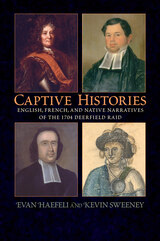 Captive Histories: English, French, and Native Narratives of the 1704 Deerfield Raid
Evan Haefeli
University of Massachusetts Press, 2006 This volume draws together an unusually rich body of original sources that tell the story of the 1704 French and Indian attack on Deerfield, Massachusetts, from different vantage points. Texts range from one of the most famous early American captivity narratives, John Williams's The Redeemed Captive, to the records of French soldiers and clerics, to little-known Abenaki and Mohawk stories of the raid that emerged out of their communities' oral traditions. Evan Haefeli and Kevin Sweeney provide a general introduction, extensive annotations, and headnotes to each text.
Although the oft-reprinted Redeemed Captive stands at the core of this collection, it is juxtaposed to less familiar accounts of captivity composed by other Deerfield residents: Quentin Stockwell, Daniel Belding, Joseph Petty, Joseph Kellogg, and the teenaged Stephen Williams. Presented in their original form, before clerical editors revised and embellished their content to highlight religious themes, these stories challenge long-standing assumptions about classic Puritan captivity narratives.
The inclusion of three Abenaki and Mohawk narratives of the Deerfield raid is equally noteworthy, offering a rare opportunity not only to compare captors' and captives' accounts of the same experiences, but to do so with reference to different Native oral traditions. Similarly, the memoirs of French military officers and an excerpt from the Jesuit Relations illuminate the motivations behind the attack and offer fresh insights into the complexities of French-Indian alliances.
Taken together, the stories collected in this volume, framed by the editors' introduction and the assessments of two Native scholars, Taiaiake Alfred and Marge Bruchac, allow readers to reconstruct the history of the Deerfield raid from multiple points of view and, in so doing, to explore the interplay of culture and memory that shapes our understanding of the past.
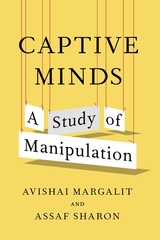 Captive Minds: A Study of Manipulation
Avishai Margalit and Assaf Sharon
Harvard University Press From philosophers Avishai Margalit and Assaf Sharon, an erudite yet approachable inquiry into political manipulation and the grave threat it poses to human freedom today.
Manipulation is as old as history itself, yet Aldous Huxley’s paraphrase of Churchill rings truer than ever: “never have so many been manipulated so much by so few.” Manipulation presents a clear danger to liberal democracy today. Demagogues undermine civic discussion, and propagandists and conspiracy theorists create cognitive traps that erode critical thinking.
What exactly is manipulation, and what sets it apart from other forms of influence? How does it differ from convincing, attracting, or nudging? Drawing on examples from mythology, literature, history, and politics, philosophers Margalit and Sharon argue that manipulation is not just a form of deceit and intellectual harm; it is, above all, an exercise of power. Manipulation exploits mental weaknesses and vulnerabilities with the goal of establishing control. Whereas liberal philosophers overlook manipulation, instead treating coercion as the primary form of political domination, Margalit and Sharon argue that manipulation should be seen as coercion’s insidious counterpart in undermining human freedom.
Public support is fundamental to the legitimacy of government. Today, political manipulation is corrupting the formation and expression of public opinion, making manipulation a driving force of the global crisis of democratic decline. A timely work, but also a work for all times, Captive Minds stands as the definitive study of a pervasive threat to political freedom and the increasingly fragile institutions that sustain it.
 Captive of the Labyrinth: Sarah L. Winchester, Heiress to the Rifle Fortune
Mary Jo Ignoffo
University of Missouri Press, 2010
Since her death in 1922, Sarah Winchester has been perceived as a mysterious, haunted figure. After inheriting a vast fortune upon the death of her husband in 1881, Sarah purchased a simple farmhouse in San José, California. She began building additions to the house and continued construction on it for the next twenty years. A hostile press cast Sarah as the conscience of the Winchester Repeating Arms Company—a widow shouldering responsibility for the many deaths caused by the rifle that brought her riches. She was accused of being a ghost-obsessed spiritualist, and to this day it is largely believed that the extensive construction she executed on her San José house was done to appease the ghouls around her.
But was she really as guilt-ridden and superstitious as history remembers her? When Winchester’s home was purchased after her death, it was transformed into a tourist attraction. The bizarre, sprawling mansion and the enigmatic nature of Winchester’s life were exaggerated by the new owners to generate publicity for their business. But as the mansion has become more widely known, the person of Winchester has receded from reality, and she is only remembered for squandering her riches to ward off disturbed spirits.
Captive of the Labyrinth: Sarah L. Winchester, Heiress to the Rifle Fortune demystifies the life of this unique American. In the first full-length biography of Winchester, author and historian Mary Jo Ignoffo unearths the truth about this notorious eccentric, revealing that she was not a maddened spiritualist driven by remorse but an intelligent, articulate woman who sought to protect her private life amidst the chaos of her public existence. The author takes readers through Winchester’s several homes, explores her private life, and, by excerpting from personal correspondence, gives the heiress a voice for the first time since her death. Ignoffo’s research reveals that Winchester’s true financial priority was not dissipating her fortune on the mansion in San José but investing it for a philanthropic legacy.
For too long Sarah Winchester has existed as a ghost herself—a woman whose existence lies somewhere between the facts of her life and a set of sensationalized recollections of who she may have been. Captive of the Labyrinth finally puts to rest the myths about this remarkable woman, and, in the process, uncovers the legacy she intended to leave behind.
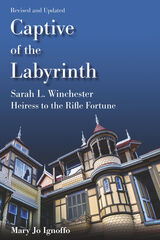 Captive of the Labyrinth: Sarah L. Winchester, Heiress to the Rifle Fortune, Revised and Updated Edition
Mary Jo Ignoffo
University of Missouri Press, 2022 Captive of the Labyrinth is reissued here to commemorate the 100th anniversary of the death of rifle heiress Sarah L. Winchester in 1922. After inheriting a vast fortune upon the death of her husband in 1881, Winchester purchased a simple farmhouse in San José, California. She built additions to the house and continued construction for the next twenty years. When neighbors and the local press could not imagine her motivations, they invented fanciful ones of their own. She was accused of being a ghost-obsessed spiritualist, and to this day it is largely believed that the extensive construction she executed on her San José house was done to thwart death and appease the spirits of those killed by the Winchester rifle.
Author and historian Mary Jo Ignoffo’s definitive biography unearths the truth about this reclusive eccentric, revealing that she was not a maddened spiritualist driven by remorse but an intelligent, articulate woman who sought to protect her private life amidst the chaos of her public existence and the social mores of the time. The author takes readers through Winchester’s several homes, explores her private life, and, by excerpting from personal correspondence, one learns the widow’s true priority was not dissipating her fortune on the mansion in San José but endowing a hospital to eradicate a dread disease.
Sarah Winchester has been exploited for profit for over a century, but Captive of the Labyrinth finally puts to rest the myths about this American heiress, and, in the process, uncovers her true legacies.
 Captive Revolution: Palestinian Women's Anti-Colonial Struggle within the Israeli Prison System
Nahla Abdo
Pluto Press, 2014 Women throughout the world have always played their part in struggles against colonialism, imperialism and other forms of oppression. However, there are few books on Arab political prisoners, fewer still on the Palestinians who have been detained in their thousands for their political activism and resistance.
Nahla Abdo's Captive Revolution seeks to break the silence on Palestinian women political detainees, providing a vital contribution to research on women, revolutions, national liberation and anti-colonial resistance. Based on stories of the women themselves, as well as her own experiences as a former political prisoner, Abdo draws on a wealth of oral history and primary research in order to analyse their anti-colonial struggle, their agency and their appalling treatment as political detainees.
Making crucial comparisons with the experiences of female political detainees in other conflicts, and emphasising the vital role Palestinian political culture and memorialisation of the 'Nakba' have had on their resilience and resistance, Captive Revolution is a rich and revealing addition to our knowledge of this little-studied phenomenon.
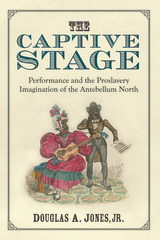 The Captive Stage: Performance and the Proslavery Imagination of the Antebellum North
Douglas A. Jones, Jr.
University of Michigan Press, 2014 In The Captive Stage, Douglas A. Jones, Jr. argues that proslavery ideology remained the dominant mode of racial thought in the antebellum north, even though chattel slavery had virtually disappeared from the region by the turn of the nineteenth century—and that northerners cultivated their proslavery imagination most forcefully in their performance practices. Jones explores how multiple constituencies, ranging from early national artisans and Jacksonian wage laborers to patrician elites and bourgeois social reformers, used the stage to appropriate and refashion defenses of black bondage as means to affirm their varying and often conflicting economic, political, and social objectives. Joining performance studies with literary criticism and cultural theory, he uncovers the proslavery conceptions animating a wide array of performance texts and practices, such as the “Bobalition” series of broadsides, blackface minstrelsy, stagings of the American Revolution, reform melodrama, and abolitionist discourse. Taken together, he suggests, these works did not amount to a call for the re-enslavement of African Americans but, rather, justifications for everyday and state-sanctioned racial inequities in their post-slavery society. Throughout, The Captive Stage elucidates how the proslavery imagination of the free north emerged in direct opposition to the inclusionary claims black publics enacted in their own performance cultures. In doing so, the book offers fresh contexts and readings of several forms of black cultural production, including early black nationalist parades, slave dance, the historiography of the revolutionary era, the oratory of radical abolitionists and the black convention movement, and the autobiographical and dramatic work of ex-slave William Wells Brown.
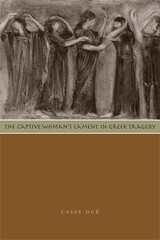 The Captive Woman's Lament in Greek Tragedy
By Casey Dué
University of Texas Press, 2006 The laments of captive women found in extant Athenian tragedy constitute a fundamentally subversive aspect of Greek drama. In performances supported by and intended for the male citizens of Athens, the songs of the captive women at the Dionysia gave a voice to classes who otherwise would have been marginalized and silenced in Athenian society: women, foreigners, and the enslaved. The Captive Woman's Lament in Greek Tragedy addresses the possible meanings ancient audiences might have attached to these songs. Casey Dué challenges long-held assumptions about the opposition between Greeks and barbarians in Greek thought by suggesting that, in viewing the plight of the captive women, Athenian audiences extended pity to those least like themselves. Dué asserts that tragic playwrights often used the lament to create an empathetic link that blurred the line between Greek and barbarian. After a brief overview of the role of lamentation in both modern and classical traditions, Dué focuses on the dramatic portrayal of women captured in the Trojan War, tracing their portrayal through time from the Homeric epics to Euripides' Athenian stage. The author shows how these laments evolved in their significance with the growth of the Athenian Empire. She concludes that while the Athenian polis may have created a merciless empire outside the theater, inside the theater they found themselves confronted by the essential similarities between themselves and those they sought to conquer.
Captives and Their Saviors in the Medieval Crown of Aragon
Jarbel Rodriguez
Catholic University of America Press, 2007 Captives and Their Saviors in the Medieval Crown of Aragon argues that by this time the ransoming efforts were on a kingdom-wide scale engaging not only professional ransomers, merchants, and officials of the crown but the population at large.
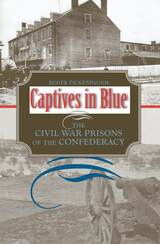 Captives in Blue: The Civil War Prisons of the Confederacy
Roger Pickenpaugh
University of Alabama Press, 2013 A study of Union prisoners in Confederate prisons
In Captives in Blue, Roger Pickenpaugh examines the ways the Confederate army contended with the growing prison population, the variations in the policies and practices of different Confederate prison camps, the effects these policies and practices had on Union prisoners, and the logistics of prisoner exchanges. He explores conditions that arose from conscious government policy decisions and conditions that were the product of local officials or unique local situations. He also considers how Confederate prisons and policies dealt with African American Union soldiers. Black soldiers held captive in Confederate prisons faced uncertain fates; many former slaves were returned to their former owners, while others faced harsh treatment in the camps. Drawing on prisoner diaries, Pickenpaugh provides compelling first-person accounts of life in prison camps often overlooked by scholars in the field.
This study of Union captives in Confederate prisons is a companion to Roger Pickenpaugh’s earlier groundbreaking book Captives in Gray: The Civil War Prisons of the Union and extends his examination of Civil War prisoner-of-war facilities into the Confederacy.
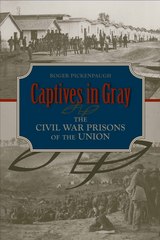 Captives in Gray: The Civil War Prisons of the Union
Roger Pickenpaugh
University of Alabama Press, 2009 “This is a vivid description of conditions and events rarely described: the imprisonment of captured Confederate soldiers during the Civil War. Its many parallels to circumstances in Andersonville are especially intriguing.” —Jimmy Carter, 39th President of the United States Contains contemporary reports from prisoners and witnesses humanize the grim realities of the POW camps Captives in Gray is Civil War prison camp authority Roger Pickenpaugh’s acclaimed and definitive account of the Union’s POW camps. Combining his own extensive research into official records and a rich variety of letters and diaries with the best contemporary scholarship, Pickenpaugh covers every major northern camp. Because the Union won few victories in 1861 and took few prisoners, the North had time to plan and build prison camps, an opportunity it largely squandered. Pickenpaugh gives illuminating accounts of the role and leadership of thrifty Lieutenant Colonel William Hoffman, the commissary general of prisoners for most of the conflict, and President Abraham Lincoln's secretaries of war, the incompetent Simon Cameron and the malignant Edwin M. Stanton. Death came in many ways. Soldiers from the Deep South had no experience with extreme cold, and they died by the hundreds each winter. In one memorable freeze, Rock Island, Illinois, saw temperatures between twenty-eight and thirty-one degrees below zero. With insufficient fuel and inadequate shelter, clothing, and blankets, prisoners there and in other camps froze to death. Food rations varied widely. A few Confederates enjoyed better rations than they had in the CSA armies, but the majority supplemented their meager rations by eating rats, dogs, cats, and seagulls. Poor medical care added to the death toll. Treatment was bad even by the standards of Civil War medicine, often due to Hoffman's reluctance to spend. Prisoners suffered from lice and scurvy, as well as pneumonia, measles, and a variety of fevers. As in both armies, diarrhea and dysentery were chronic. Smallpox epidemics killed many. Poor sanitation and drainage caused 385 deaths at Elmira, New York, in September 1864 alone. During the war, over 12 percent of rebel prisoners, or 25,976 of the 214,865, died in captivity. Together with his Captives in Blue, Captives in Gray gives the fullest account of the experiences of prisoners of war in the American Civil War.
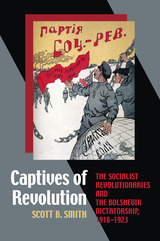 Captives of Revolution: The Socialist Revolutionaries and the Bolshevik Dictatorship, 1918–1923
Scott B. Smith
University of Pittsburgh Press, 2011
The Socialist Revolutionaries (SRs) were the largest political party in Russia in the crucial revolutionary year of 1917. Heirs to the legacy of the People’s Will movement, the SRs were unabashed proponents of peasant rebellion and revolutionary terror, emphasizing the socialist transformation of the countryside and a democratic system of government as their political goals. They offered a compelling, but still socialist, alternative to the Bolsheviks, yet by the early 1920s their party was shattered and its members were branded as enemies of the revolution. In 1922, the SR leaders became the first fellow socialists to be condemned by the Bolsheviks as “counter-revolutionaries” in the prototypical Soviet show trial.
In Captives of the Revolution, Scott B. Smith presents both a convincing account of the defeat of the SRs and a deeper analysis of the significance of the political dynamics of the Civil War for subsequent Soviet history. Once the SRs decided to openly fight the Bolsheviks in 1918, they faced a series of nearly impossible political dilemmas. At the same time, the Bolsheviks fatally undermined the revolutionary credentials of the SRs by successfully appropriating the rhetoric of class struggle, painting a simplistic picture of Reds versus Whites in the Civil War, a rhetorical dominance that they converted into victory over the SRs and any left-wing alternative to Bolshevik dictatorship. In this narrative, the SRs became a bona fide threat to national security and enemies of the people—a characterization that proved so successful that it became an archetype to be used repeatedly by the Soviet leadership against any political opponents, even those from within the Bolshevik party itself.
In this groundbreaking study, Smith reveals a more complex and nuanced picture of the postrevolutionary struggle for power in Russia than we have ever seen before and demonstrates that the Civil War—and in particular the struggle with the SRs—was the formative experience of the Bolshevik party and the Soviet state.
Captivity
Toi Derricotte
University of Pittsburgh Press, 1989 What are the forces that cause us to strike out and harm each other? Captivity explores the way in which the individual is held hostage by society; how the forces of racism, sexism, and classism frequently express themselves as violence within the family. The book also explores a deeper captivity, like the Jews in Egypt yearning for the Promised Land, the soul trapped in exile from God.
 Captivity and Sentiment: Cultural Exchange in American Literature, 1682–1861
Michelle Burnham
Dartmouth College Press, 2000 In a radically new interpretation and synthesis of highly popular 18th- and 19th-century genres, Michelle Burnham examines the literature of captivity, and, using Homi Bhabha's concept of interstitiality as a base, provides a valuable redescription of the ambivalent origins of the US national narrative. Stories of colonial captives, sentimental heroines, or fugitive slaves embody a "binary division between captive and captor that is based on cultural, national, or racial difference," but they also transcend these pre-existing antagonistic dichotomies by creating a new social space, and herein lies their emotional power. Beginning from a simple question on why captivity, particularly that of women, so often inspires a sentimental response, Burnham examines how these narratives elicit both sympathy and pleasure. The texts carry such great emotional impact precisely because they "traverse those very cultural, national, and racial boundaries that they seem so indelibly to inscribe. Captivity literature, like its heroines, constantly negotiates zones of contact," and crossing those borders reveals new cultural paradigms to the captive and, ultimately, the reader.
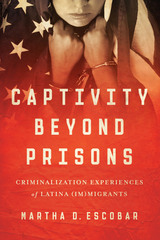 Captivity Beyond Prisons: Criminalization Experiences of Latina (Im)migrants
By Martha D. Escobar
University of Texas Press, 2016 Today the United States leads the world in incarceration rates. The country increasingly relies on the prison system as a “fix” for the regulation of societal issues. Captivity Beyond Prisons is the first full-length book to explicitly link prisons and incarceration to the criminalization of Latina (im)migrants. Starting in the 1990s, the United States saw tremendous expansion in the number of imprisoned (im)migrants, specifically Latinas/os. Consequently, there was also an increase in the number of deportations. In addition to regulating society, prisons also serve as a reproductive control strategy, both in preventing female inmates from having children and by separating them from their families. With an eye to racialized and gendered technologies of power, Escobar argues that incarcerated Latinas are especially depicted as socially irrecuperable because they are not considered useful within the neoliberal labor market. This perception impacts how they are criminalized, which is not limited to incarceration but also extends to and affects Latina (im)migrants’ everyday lives. Escobar also explores the relationship between the immigrant rights movement and the prison abolition movement, scrutinizing a variety of social institutions working on solutions to social problems that lead to imprisonment. Accessible to both academics and those in the justice and social service sectors, Escobar’s book pushes readers to consider how, even in radical spaces, unequal power relations can be reproduced by the very entities that attempt to undo them.
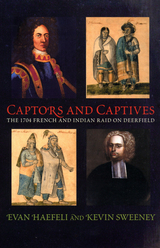 Captors and Captives: The 1704 French and Indian Raid on Deerfield
Evan Haefeli
University of Massachusetts Press, 2003 On February 29, 1704, a party of French and Indian raiders descended on the Massachusetts village of Deerfield, killing fifty residents and capturing more than a hundred others. In this masterful work of history, Evan Haefeli and Kevin Sweeney reexamine the Deerfield attack and place it within a framework stretching from the Atlantic Ocean to the Great Lakes. Drawing on previously untapped sources, they show how the assault grew out of the aspirations of New England family farmers, the ambitions of Canadian colonists, the calculations of French officials, the fears of Abenaki warriors, and the grief of Mohawk women as they all struggled to survive the ongoing confrontation of empires and cultures.
Haefeli and Sweeney reconstruct events from multiple points of view, through the stories of a variety of individuals involved. These stories begin in the Native, French, and English communities of the colonial Northeast, then converge in the February 29 raid, as a force of more than two hundred Frenchmen, Abenakis, Hurons, Kahnawake Mohawks, Pennacooks, and Iroquois of the Mountain overran the northwesternmost village of the New England frontier. Although the inhabitants put up more of a fight than earlier accounts of the so-called Deerfield Massacre have suggested, the attackers took 112 men, women, and children captive. The book follows the raiders and their prisoners on the harsh three-hundred-mile trek back to Canada and into French and Native communities. Along the way the authors examine how captives and captors negotiated cultural boundaries and responded to the claims of competing faiths and empires—all against a backdrop of continuing warfare.
By giving equal weight to all participants, Haefeli and Sweeney range across the fields of social, political, literary, religious, and military history, and reveal connections between cultures and histories usually seen as separate.
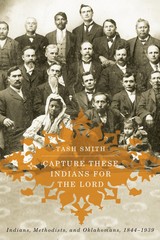 Capture These Indians for the Lord: Indians, Methodists, and Oklahomans, 1844-1939
Tash Smith
University of Arizona Press, 2014 In 1844, on the heels of the final wave of the forced removal of thousands of Indians from the southern United States to what is now Oklahoma, the Southern Methodist Church created a separate organization known as the Indian Mission Conference to oversee its missionary efforts among the Native communities of Indian Territory. Initially, the Church conducted missions as part of the era’s push toward assimilation. But what the primarily white missionaries quickly encountered was a population who exerted more autonomy than they expected and who used Christianity to protect their culture, both of which frustrated those eager to bring Indian Territory into what they felt was mainstream American society.
In Capture These Indians for the Lord, Tash Smith traces the trajectory of the Southern Methodist Church in Oklahoma when it was at the frontlines of the relentless push toward western expansion. Although many Native people accepted the missionaries’ religious practices, Smith shows how individuals found ways to reconcile the Methodist force with their traditional cultural practices. When the white population of Indian Territory increased and Native sovereignty came under siege during the allotment era of the 1890s, white communities marginalized Indians within the Church and exploited elements of mission work for their own benefit.
Later, with white indifference toward Indian missions peaking in the early twentieth century, Smith explains that as the remnants of the Methodist power weakened, Indian membership regained control and used the Church to regenerate their culture. Throughout, Smith explores the complex relationships between white and Indian community members and how these phenomena shaped Methodist churches in the twentieth century.
 Captured Peace: Elites and Peacebuilding in El Salvador
Christine J. Wade
Ohio University Press, 2015 El Salvador is widely considered one of the most successful United Nations peacebuilding efforts, but record homicide rates, political polarization, socioeconomic exclusion, and corruption have diminished the quality of peace for many of its citizens. In Captured Peace: Elites and Peacebuilding in El Salvador, Christine J. Wade adapts the concept of elite capture to expand on the idea of “captured peace,” explaining how local elites commandeered political, social, and economic affairs before war’s end and then used the peace accords to deepen their control in these spheres. While much scholarship has focused on the role of gangs in Salvadoran unrest, Wade draws on an exhaustive range of sources to demonstrate how day-to-day violence is inextricable from the economic and political dimensions. In this in-depth analysis of postwar politics in El Salvador, she highlights the local actors’ primary role in peacebuilding and demonstrates the political advantage an incumbent party—in this case, the Nationalist Republican Alliance (ARENA—has throughout the peace process and the consequences of this to the quality of peace that results.
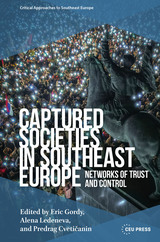 Captured Societies in Southeast Europe: Networks of Trust and Control
Eric Gordy
Central European University Press, 2025 In Southeast Europe, there is a growing disjunction between “the way the world is” and the world that is described by law. The informal practices that address problems when formal institutions fail can be celebrated as spaces of creative problem-solving, or criticized as spaces for favouritism and corruption. When ruling political parties control informal networks, they consolidate the hold of unaccountable actors on power, moving from state capture to societal capture.
This book presents findings from a collaborative, multidisciplinary research project. Over three years, a group of forty researchers examined informal practices in nine Southeast European states, adopting a mix of qualitative and quantitative methodologies.
This close look at the Balkans illuminates persistent deficits in state legitimacy and capacity. The evidence allows a critical assessment of “Europeanisation” processes that produce only superficial formal changes, and of ways that networks of mutual assistance turn into instruments of social control and closure.
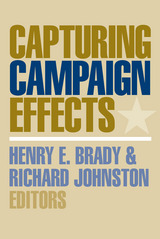 Capturing Campaign Effects
Henry E. Brady and Richard Johnston, eds.
University of Michigan Press, 2006 Capturing Campaign Effects is the definitive study to date of the influence of campaigns on political culture. Comprising a broad exploration of campaign factors (debates, news coverage, advertising, and polls) and their effects (priming, learning, and persuasion), as well as an impressive survey of techniques for the collection and analysis of campaign data, Capturing Campaign Effects examines different kinds of campaigns in the U.S. and abroad and presents strong evidence for significant campaign effects.
"Capturing Campaign Effects is an accessible and penetrating account of modern scholarship on electoral politics. It draws critical insights from a range of innovative analyses."
--Arthur Lupia, University of Michigan
"What a wonderful way to usher in the new era of election studies! This book spotlights fascinating paradoxes in the literature of voting behavior, highlights many promising approaches to resolving those paradoxes, and shows how these strategies can yield important findings with terrific payoffs for our understanding of contemporary democracy. Fasten your seatbelts, folks: scholarship on elections is about to speed up thanks to this collection of great essays."
--Jon Krosnick, Stanford University
"The past decade has seen a renewed interest in understanding campaign effects. How and when do voters learn? Does the election campaign even matter at all? Capturing Campaign Effects draws on leading political scientists to address these matters. The result is a collection that will become the major reference for the study of campaigns. The lesson that emerges is that campaigns do affect voter decision making, usually for the better."
--Robert S. Erikson, Columbia University
Henry E. Brady is Class of 1941 Monroe Deutsch Professor of Political Science and Public Policy, and Director of the Survey Research Center at the University of California, Berkeley.
Richard Johnston is Professor and Head of Political Science and Distinguished University Scholar at the University of British Columbia.
 Capturing Contemporary Japan: Differentiation and Uncertainty
edited by Satsuki Kawano, Glenda S. Roberts, and Susan Orpett Long
University of Hawaii Press, 2014 What are people’s life experiences in present-day Japan? This timely volume addresses fundamental questions vital to understanding Japan in the first decade of the twenty-first century. Its chapters collectively reveal a questioning of middle-class ideals once considered the essence of Japaneseness. In the postwar model household a man was expected to obtain a job at a major firm that offered life-long employment; his counterpart, the “professional” housewife, managed the domestic sphere and the children, who were educated in a system that provided a path to mainstream success. In the past twenty years, however, Japanese society has seen a sharp increase in precarious forms of employment, higher divorce rates, and a widening gap between haves and have-nots.
Contributors draw on rich, nuanced fieldwork data collected during the 2000s to examine work, schooling, family and marital relations, child rearing, entertainment, lifestyle choices, community support, consumption and waste, material culture, well-being, aging, death and memorial rites, and sexuality. The voices in these pages vary widely: They include schoolchildren, teenagers, career women, unmarried women, young mothers, people with disabilities, small business owners, organic farmers, retirees, and the elderly.
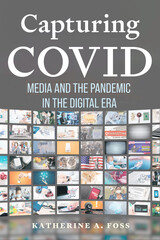 Capturing COVID: Media and the Pandemic in the Digital Era
Katherine A. Foss
University of Massachusetts Press, 2025 When health authorities quarantined guests aboard the Diamond Princess on February 5, 2020, the cruise ship abruptly shifted from a dream vacation vessel to a public health nightmare. Over the next three weeks, 712 passengers tested positive for coronavirus, with fourteen deaths, and the ship outbreak quickly became the largest cluster of cases outside of China. Guests began to routinely share quarantine updates on social media, ranging from the quality of the ship’s food to their sense of imprisonment. These Facebook, Twitter, Instagram, YouTube, and TikTok accounts became a key source of information for news outlets like the Associated Press, and they helped to set the tone for how the media would cover and frame the pandemic for the next several years.
Unlike past outbreaks, epidemics, and pandemics, COVID-19 emerged in a 21st-century digital landscape of instant communication and abundant online platforms, with older models of news and entertainment media mingling with new types of citizen-produced content. In Capturing COVID, Katherine A. Foss makes sense of how this contemporary media landscape shaped the public’s knowledge and perceptions of the new pandemic. The book focuses on crucial media moments, including the initial reporting from Wuhan; news and social media content on the Diamond Princess quarantine; stories of inequality, stigma, and injustice; narratives of the vaccine rollout; and representations of pandemic life in popular culture. Drawing on press releases, interviews, websites, blogs, social media posts, and other publicly available materials, and guided by critical media analysis, Foss illuminates how this new digital era profoundly shaped the progression of the pandemic. This media landscape kept people informed and connected, but also led to the politicization of the virus, rampant mis/disinformation, and stigmatizing messaging that contributed to public distrust and division. Capturing COVID deftly helps make sense of the entire affair.
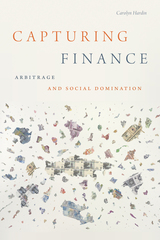 Capturing Finance: Arbitrage and Social Domination
Carolyn Hardin
Duke University Press, 2021 Arbitrage—the trading practice that involves buying assets in one market at a cheap price and immediately selling them in another market for a profit—is fundamental to the practice of financial trading and economic understandings of how financial markets function. Because traders complete transactions quickly and use other people's money, arbitrage is considered to be riskless. Yet, despite the rhetoric of riskless trading, the arbitrage in mortgage-backed securities led to the 2008 financial crisis. In Capturing Finance Carolyn Hardin offers a new way of understanding arbitrage as a means for capturing value in financial capitalism. She shows how arbitrage relies on a system of abstract domination built around risk. The commonsense beliefs that taking on debt is necessary for affording everyday life and that investing is necessary to secure retirement income compel individuals to assume risk while financial institutions amass profits. Hardin insists that mitigating financial capitalism's worst consequences, such as perpetuating class and racial inequities, requires challenging the narratives that naturalize risk as a necessary element of financial capitalism as well as social life writ large.
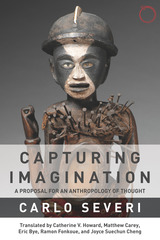 Capturing Imagination: A Proposal for an Anthropology of Thought
Carlo Severi
HAU, 2018 We have all found ourselves involuntarily addressing inanimate objects as though they were human. For a fleeting instant, we act as though our cars and computers can hear us. In situations like ritual or play, objects acquire a range of human characteristics, such as perception, thought, action, or speech. Puppets, dolls, and ritual statuettes cease to be merely addressees and begin to address us—we see life in them.
How might we describe the kind of thought that gives life to the artifact, making it memorable as well as effective, in daily life, play, or ritual action? Following The Chimera Principle, in this collection of essays Carlo Severi explores the kind of shared imagination where inanimate artifacts, from non-Western masks and ritual statuettes to paintings and sculptures in our own tradition, can be perceived as living beings. This nuanced inquiry into the works of memory and shared imagination is a proposal for a new anthropology of thought.
 Capturing Labor: A History of Unfree Work in the Southwest
Edited by Jessica R. Pliley and John Mckiernan-González
University of Texas Press, 2026 A collection of essays grappling with the many, often overlooked, forms of unfree labor in the West. When Americans think of unfree labor—coerced, extracted from workers unable to freely enter and exit contracts—what comes to mind is Black slavery and peonage in the South. But other forms of unfree labor also built the United States. Collecting a diverse range of sharply argued historical essays, Capturing Labor shares the story of unfree labor in the Southwest, affecting mainly Indigenous people, Mexican Americans, and people of color. In Texas and elsewhere, state agents developed various methods for directing the movement of workers, seizing their time, and controlling the products of their efforts. Case studies highlight the detention during World War I of Indigenous children and unaccompanied women, who were placed in boarding schools, fined, and obligated to work off the resulting debt. Other essays expose authorities forcing workers to break strikes and jailing Americans who supported labor uprisings in rural Mexico and the United States . Prisons and asylums supplied coerced agricultural workers and musicians who were never compensated for their labor or by the labels that took their recordings. Editors Jessica Pliley and John Mckiernan-González contend that unfree labor continues to shape American life, and is all around us today. Understanding its history aids us in recognizing and bringing attention to the grim realities of the present.
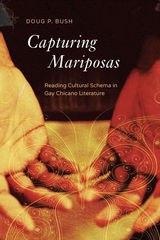 Capturing Mariposas: Reading Cultural Schema in Gay Chicano Literature
Doug P. Bush
Ohio State University Press, 2019 Gay Chicano/Latinx literature often holds an intensely personal meaning for its readers, sometimes being the first artistic expression encountered that affirms their own identity as a double minority in a world that is frequently hostile to both. Nevertheless, much of the academic discourse surrounding this body of literature has overlooked how critical audience reaction can be in this inherently political genre, instead seeing the power of a work as resting within the piece itself.
In Capturing Mariposas: Reading Cultural Schema in Gay Chicano Literature, Doug P. Bush looks at the book as only the beginning, considering how this literature has the power to bring understanding to disparate groups, speak truth about repressed sexuality and repressive communities, and recast traditional spaces as ones of inclusion, all through the idea of the cultural schema. Integrating elements of narratology and cognitive studies of literature, the cultural schema speaks to how these authors challenge, reaffirm, and transform commonly held experiences of gay Chicanos—or potentially any audience who reads their works. Focusing on twenty-first-century writers such as Manuel Muñoz, Rigoberto González, and Alex Espinoza, Bush examines the cultural schema of their works and then moves toward a more holistic discussion of the publishing and political implications of this genre. In addition to Bush’s important scholarship, the book includes extensive interviews with the authors themselves.
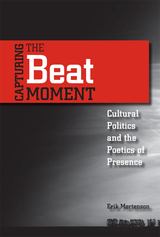 Capturing the Beat Moment: Cultural Politics and the Poetics of Presence
Erik Mortenson
Southern Illinois University Press, 2010 CHOICE Outstanding Academic Title
Examining “the moment” as one of the primary motifs of Beat writing, Erik Mortenson offers the first book to investigate immediacy and its presence and importance in Beat writing. Capturing the Beat Moment: Cultural Politics and the Poetics of Presence places an expanded canon of Beat writers in an early postmodern context that highlights their importance in American poetics and provides an account of Beat practices that reveal how gender and race affect Beat politics of the moment.
Mortenson argues that Beat writers focused on action, desire, and spontaneity to establish an authentic connection to the world around them and believed that “living in the moment” was the only way in which they might establish the kind of life that led to good writing. With this in mind, he explores the possibility that, far from being the antithesis of their times, the Beats actually were a product of them. Mortenson outlines the effects of gender and race on Beat writing in the postwar years, as well as the Beats’ attempts to break free of the constrictive notions of time and space prevalent during the 1950s.
Mortenson discusses such topics as the importance of personal visionary experiences; the embodiment of sexuality and the moment of ecstasy in Beat writing; how the Beats used photographs to evoke the past; and the ways that Beat culture was designed to offer alternatives to existing political and social structures. Throughout the volume, Mortenson moves beyond the Kerouac-Ginsberg-Burroughs triumvirate commonly associated with Beat literature, discussing women—such as Diane di Prima, Janine Pommy Vega, and Joyce Johnson—and African American writers, including Bob Kaufman and Amiri Baraka. With the inclusion of these authors comes a richer understanding of the Beat writers’ value and influence in American literary history.
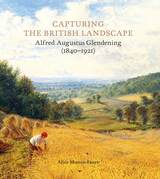 Capturing the British Landscape: Alfred Augustus Glendening (1840–1921)
Alice Munro-Faure
Paul Holberton Publishing, 2022 The life and work of Victorian landscape painter Alfred Augustus Glendening, illustrating his rapid rise from railway clerk to an acclaimed artist.
Though critics often reviewed Alfred Augustus Glendening’s exhibitions, very little has been written about the artist himself. Here, new and extensive research removes layers of mystery and misinformation about his life, family, and career, accurately placing him amid the British art world during much of the nineteenth and into the twentieth century. Glendening was a man from humble origins, working full-time as a railway clerk when he managed to make his London exhibition debut at the age of twenty—a feat that would have been almost impossible before the Victorian era ushered in new possibilities of social mobility. Although his paintings show a tranquil and unspoiled landscape, his environment was rapidly being transformed by social, scientific, and industrial developments, while advances in transport, photography, and other technical discoveries undoubtedly influenced him and his fellow painters.
Celebrating his uniquely Victorian story, the book places Glendening within his proper historical context. Running alongside the main text is a timeline outlining significant landmarks, from political and social events to artistic and technical innovations. Thoroughly researched, the narrative explores why and for whom he painted, his artistic training, and his various inspirations. The book uncovers new information about the Victorian art world and embraces such aspects as Royal Academy prejudices, the popularity of Glendening’s work at home and abroad, his use of photography, and the sourcing of his art materials.
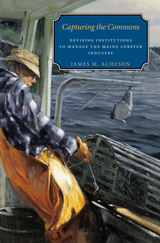 Capturing the Commons: Devising Institutions to Manage the Maine Lobster Industry
James M. Acheson
University Press of New England, 2004 One of the most pressing concerns of environmentalists and policy makers is the overexploitation of natural resources. Efforts to regulate such resources are too often undermined by the people whose livelihoods depend on their use. One of the great challenges for wildlife managers in the twenty-first century is learning to create the conditions under which people will erect effective and workable rules to conserve those resources. James M. Acheson, author of the best-selling Lobster Gangs of Maine (the seminal work on the culture and economics of lobster fishing), here turns his attention to the management of the lobster industry. In this illuminating new book, he shows that resource degradation is not inevitable. Indeed, the Maine lobster fishery is one of the most successful fisheries in the world. Catches have been stable since World War II, and record highs have been achieved since the late 1980s. According to Acheson, these high catches are due, in part, to the institutions generated by the lobster-fishing industry to control fishing practices. These rules are effective. Rational choice theory frames Acheson’s down-to-earth study. Rational choice theorists believe that the overexploitation of marine resources stems from their common-pool nature, which results in collective action problems. In fisheries, what is rational for the individual fishermen can lead to disaster for the society. The progressive Maine lobster industry, lobster fishermen, and local groups have solved a series of such problems by creating three different sets of regulations: informal territorial rules; rules to control the number of traps; and formal conservation legislation. In recent years, the industry has successfully influenced new regulations at the federal level and has developed a strong co-management system with the Maine government. The process of developing these rules has been quite acrimonious; factions of fishermen have disagreed over lobster rules designed to give commercial advantage to one group or another. Although fishermen and scientists have come to share a conservation ethic, they often disagree over how to best conserve the lobster and even the quality of science. The importance of Capturing the Commons is twofold: it provides a case study of the management of one highly successful fishery, which can serve as a management model for policy makers, politicians, and local communities; and it adds to the body of theory concerning the conditions under which people will and will not devise institutions to manage natural resources.
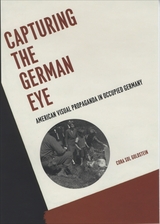 Capturing the German Eye: American Visual Propaganda in Occupied Germany
Cora Sol Goldstein
University of Chicago Press, 2009 Shedding new light on the American campaign to democratize Western Germany after World War II, Capturing the German Eye uncovers the importance of cultural policy and visual propaganda to the U.S. occupation. Cora Sol Goldstein skillfully evokes Germany’s political climate between 1945 and 1949, adding an unexpected dimension to the confrontation between the United States and the USSR. During this period, the American occupiers actively vied with their Soviet counterparts for control of Germany’s visual culture, deploying film, photography, and the fine arts while censoring images that contradicted their political messages. Goldstein reveals how this U.S. cultural policy in Germany was shaped by three major factors: competition with the USSR, fear of alienating German citizens, and American domestic politics. Explaining how the Americans used images to discredit the Nazis and, later, the Communists, she illuminates the instrumental role of visual culture in the struggle to capture German hearts and minds at the advent of the cold war.
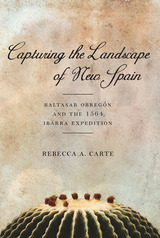 Capturing the Landscape of New Spain: Baltasar Obregón and the 1564 Ibarra Expedition
Rebecca A. Carte
University of Arizona Press, 2015 The son of an encomendero, Baltasar Obregón was twenty years old when he joined the 1564 expedition led by the first governor of Nueva Vizcaya, Francisco de Ibarra. The purpose of the expedition was to establish mining settlements in the borderlands of New Spain and to suppress indigenous rebellions in the region.
Although Obregón’s role in the Ibarra expedition was that of soldier-explorer, and despite his lacking an advanced education, he would go on to compose Historia de los descubrimientos de Nueva España twenty years later, expanding his narrative to include the years before and after his own firsthand experiences with Ibarra. Obregón depicts the storied landscape of the northern borderlands with vivid imagery, fusing setting and situation, constructing a new reality of what was, is, and should be, and presenting it as truth.
In Capturing the Landscape of New Spain, Rebecca A. Carte explains how landscape performs a primary role in Obregón’s retelling, emerging at times as protagonist and others as antagonist. Carte argues that Obregón’s textualization offers one of the first renderings of the region through the Occidental cultural lens, offering insight into Spanish cultural perceptions of landscape during a period of important social and political shifts.
By examining mapping and landscape discourse, Carte shows how history and geography, past and present, people and land, come together to fashion the landscape of northern New Spain.
 Capturing the News: Three Decades of Reporting Crisis and Conflict
Anthony Collings
University of Missouri Press, 2010 Anthony Collings found himself in his share of difficult situations in his thirty-four years as a newsman. Like being captured by AK-47–toting Syrians in Lebanon in 1981 while looking for missiles that threatened a new outbreak of hostilities with Israel, or being “detained” by the KGB in Moscow in 1967 during his first foreign posting for the Associated Press filing stories about Soviet dissidents. Name a hot spot, and Collings has likely been there. From AP correspondent to Newsweek bureau chief to CNN reporter, he covered the Middle East, Rome, Moscow, London, Paris, and Washington. Now he has gathered stories about his work in a book that is both a journalist’s memoir and a commentary on the current ethical crises in the news media and how to address them.
Brimming with entertaining stories about journalism, especially the chaotic early years at CNN when he and his colleagues established the first major cable news network, Collings’s book reveals the dangers and pressures of covering the news and the difficulties of overcoming obstacles to the truth. He recalls smuggling tapes out of Poland after the Communists had imposed martial law; flying dangerously near Libya’s “Line of Death”; interviewing world figures from Brezhnev to Kaddafi and Arafat; and winning awards for covering Iran-Contra and the Oklahoma City bombing. Collings brings fresh insights to the Oliver North affair and examines how the press was suckered in its coverage of the Jessica Lynch prisoner-of-war story in 2003. He voices his concerns regarding oversimplified reporting of complex issues and poses provocative questions about covering terrorism.
In this book, Collings presents an insider’s appraisal of the American news media’s failings and accomplishments. Easy to read, informative, and thoughtful, Capturing the News will enlighten general readers interested in how journalists cover current affairs, while offering newsmen food for thought about the craft and ethics of journalism.
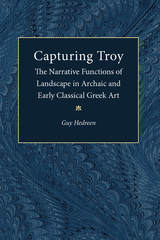 Capturing Troy: The Narrative Functions of Landscape in Archaic and Early Classical Greek Art
Guy Hedreen
University of Michigan Press, 2002 Those in the field of classical art will appreciate this investigation of the most common remnant of ancient Greek society available to the modern scholar, the painted vase. Guy Hedreen discusses how the imagery on Greek vases is only sometimes used as a narrative device, and delves further into the extent to which visual imagery depends upon literary sources. With the backdrop of one of the world's earliest, and some would argue greatest stories ever told, the sacking of Troy, Hedreen brings the reader into one of the most current and persistent topics in the art world: Narrative vs. Art. Employing a wide range of stunning visual imagery to illustrate his points, this insightful original text, Capturing Troy is a valuable new contribution to the subject, accessible to the learned scholar and beginning student alike.
Guy Michael Hedreen is Professor of Art, Williams College.
 Capturing Water: Puebloan Resilience and Agricultural Sustainability in Chaco Canyon
R. Gwinn Vivian and Samantha G. Fladd
University of Utah Press, 2025 An esteemed archaeologist's lifetime of work on water use in Chaco Canyon
The ability of the inhabitants of Chaco Canyon to sustain themselves through farming in an arid environment has long been a topic of debate among scholars. Building upon the work of his father, Gordon, R. Gwinn Vivian dedicated his lifetime of archaeological work to investigating water management and practices at Chaco. These efforts provide compelling evidence of the extensive use of canal irrigation systems and other water management techniques employed by the Ancestral Puebloan people by the ninth century and continuing through recent periods by Navajo farmers.
Rich with archaeological data, ethnographic evidence, maps, and photographs, this volume challenges long-standing assumptions about Chaco Canyon's agricultural potential. By highlighting the adaptability and ingenuity of the canyon's early inhabitants, the book offers a fresh perspective on the role of water management in the development of Chaco Canyon as a sociopolitical center in the northern Southwest.
The Caracas Company, 1728-1784: A Study in The History of Spainish Monopolistic Trade
Roland Dennis Hussey
Harvard University Press This book is primarily a history of the Real Compahia Guipuscoana de Caracas, commonly known as the Caracas Company, which possessed a monopoly of the Venezuelan overseas trade. Roland Hussey has set his story into a broad background. About one-third of his book is devoted to an exposition of Spanish economic theory before and during the eighteenth century; to the many companies projected after 1624; to the Havana, Catalan, Philippine, and domestic Spanish companies formed after that of Caracas; and to the development of Spanish colonial trade in the eighteenth century. Since the study is based upon previously unused manuscript material, it will be indispensable to students of Spanish-American history and of economic history in general.
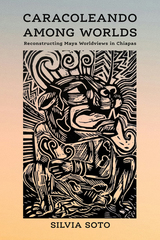 Caracoleando Among Worlds: Reconstructing Maya Worldviews in Chiapas
Silvia Soto
University of Arizona Press, 2024 The contemporary literary movement of Maya writers of Chiapas and the Zapatista Army of National Liberation (or EZLN) insurgency are intricately intertwined. Even as each has forged its own path, they are bound by a shared commitment to rescuing, reclaiming, and recentering Maya worldviews.
This shared vision emerges in Caracoleando Among Worlds, which provides an in-depth analysis of poetry, short stories, and one of the first novels written by a Maya Tsotsil writer of Chiapas alongside close readings of the EZLN’s six declarations of the Lacandon Jungle. Themes echoing ancestral connections, informing epistemologies, and sustaining cultural and spiritual practices emerge and weave the texts to each other. The work brings into the conversation literature that has been translated into English for the first time and places Maya writers of Chiapas in discussion with other Native American and Indigenous scholars.
This work shows how literature, culture, and activism intertwine, and offers a compelling narrative that transcends boundaries and fosters a deeper understanding of Maya identities and resilience.
 The Caravaggio Syndrome: A Novel
Alessandro Giardino
Rutgers University Press, 2024 Leyla is a headstrong Brooklyn-born art historian at a prestigious upstate New York college. When she meets feckless young computer technician Pablo at a party, she quickly becomes pregnant with his child. There’s only one problem: she can’t stand him. And one more problem: her student Michael wants Pablo for himself.
Amid this love triangle, the objects of Leyla and Michael’s study take on a life of their own. Trying to learn more about Caravaggio’s masterpiece The Seven Works of Mercy, they pore over the journal and prison writings of maverick 17th-century utopian philosopher Tommaso Campanella, which, as if by enchantment, transport them back four centuries to Naples. And while the past and present miraculously converge, Leyla, Michael, and Tommaso embark on a voyage of self-discovery in search of a new life.
In this fusion of historical, queer, and speculative fiction, Alessandro Giardino combines the intellectual playfulness of Umberto Eco with the psychological finesse of Michael Cunningham.
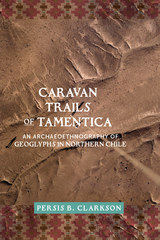 Caravan Trails of Tamentica: An Archaeoethnography of Geoglyphs in Northern Chile
Persis B. Clarkson
University of Utah Press, 2025 An anthropological and narrative exploration of ancient llama caravans and their associated geoglyphs in the Chilean Atacama Desert
Caravan Trails of Tamentica is a vivid exploration of ancient Andean llama caravans and their associated geoglyphs—ground drawings—in the Chilean Atacama Desert. In retracing the paths of caravans and documenting the evidence that remains of their journeys, Persis B. Clarkson sheds new light on the possible social, astronomical, and ritual roles of these magnificent drawings.
Focusing on one segment of caravan trails from the Tamentica Oasis in the Guatacondo Quebrada to the Cerros Maní to the south, Clarkson intertwines insights on the environmental, cultural, and archaeological landscapes with narratives of her methods and personal experiences of archaeological fieldwork in the Atacama Desert. Modern and historic accounts of and by Andean caravanners lend depth and significance, while dozens of aerial photographs capture the breadth and scope of the thousands of geoglyphs in this fascinating region.
Carbine: Stories
Greg Mulcahy
University of Massachusetts Press, 2010 Inhabiting a world that offers no guarantee of any veracity, the characters in these peculiar stories are driven to and goaded by compulsive and perhaps pointless reflection. They are haunted by unrelenting consciousness and knowledge of failure, yet are, at best, ambivalent toward any conventional equation of success. Theirs is a world of broken relationships, futile memory, constant appetite, and the certain knowledge that they are winding down in a culture in which it is impossible to do—or know—the right thing. Frustrated and obsessed, they cannot articulate their lives and are entranced by the strangeness of the everyday.
Written with keen intelligence and biting humor, Carbine is a book about the ridiculousness of contemporary life—a book about what cannot be said.
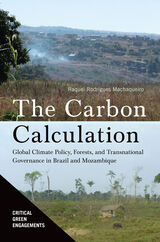 The Carbon Calculation: Global Climate Policy, Forests, and Transnational Governance in Brazil and Mozambique
Raquel Rodrigues Machaqueiro
University of Arizona Press, 2023 The Carbon Calculation examines how climate science, the policy world, and neoliberalism have mutually informed each other to define the problem of climate change as one of “market failure”—precluding alternatives to market-based solutions.
Focusing on REDD+ (Reducing Emissions from Deforestation and Forest Degradation), the book demonstrates how industrialized countries are able to maintain their socioeconomic models largely unaltered while claiming to address global warming using forests in the Global South to offset their pollution. By examining the creation and implementation of REDD+ historically and ethnographically, the book traces the social life of this mechanism as it travels across a complex network spanning several interacting levels: international, national, and local. Through cases in the Brazilian state of Acre and the Zambézia province in Mozambique, the author demonstrates how global climate policy has created new opportunities and rationales for unprecedented levels of intervention in the Global South—all under the guise of saving the planet.
The Carbon Calculation critically highlights the ways in which politics has reinforced a scientific focus on one possible solution to the problem of climate change—namely those that largely absolve the industrialized world from undertaking politically painful transformations in its own economic model.
 The Carbon Control Knob
Richard Alley
Island Press, 2012 On November 2, 2011, Richard Alley participated in The National Climate Seminar, a series of webinars sponsored by Bard College’s Center for Environmental Policy. The online seminars provide a forum for leading scientists, writers, and other experts to talk about critical issues regarding climate change. The series also opens a public conversation, inviting participants to ask questions and contribute their own thoughts.
Dr. Alley conducts research on the paleoclimatic record at The Pennsylvania State University in order to understand the history, and perhaps the future, of climate change. In his lecture, Alley gave a concise overview of why we know what we know about climate change, and what that evidence can tell us about today’s warming planet. Alley not only provides an accessible science lesson, but reveals his own greatest concerns about climate change and offers advice to those who want to stop debating the subtleties of climate science and act now.
This E-ssential is an edited version of Alley’s talk and the subsequent question and answer session. While some material has been cut and some language modified for clarity, the intention was to retain the substance of the original discussion.
 Carbon County, USA: Miners for Democracy in Utah and the West
Christian Wright
University of Utah Press, 2019 Although unions are by no means entirely gone or lacking in lobbying power, their membership in traditional industries is on the decline and their influence continues to diminish. Only a generation ago, large unions such as the United Mine Workers of America held greater political and economic capital and inspired millions beyond their immediate ranks. In this book, Christian Wright explores the complex history of the UMWA and coal mining in the West over a fifty-year period of the twentieth century, concentrating on the coal miners of Carbon and Emery counties in Utah. Wright emphasizes their experience during the 1970s, which saw the rise and passing of American workers’ most successful postwar effort to internally reform a major labor organization: the Miners for Democracy movement. As Wright details how and why Miners for Democracy and nonunion mining raced to control coal’s future, he also touches on the UMWA’s regional origins during and immediately after the New Deal, when cracks in union efficacy and benefit programs began to appear. Using sophisticated demography, Wright not only details how miners’ racial, gender, and generational identities shaped their changing relationships to mining and organized labor, he also illustrates the place of nonunion miners, antiunion employers, the unemployed, ethnic minorities, and women in transforming “Carbon County, USA.”
Drawing on a variety of primary sources, Wright provides evidence for organized labor’s continuing significance and value while effectively illuminating its mounting frustrations during a relatively recent chapter in the history of Utah and the United States.
 Carbon Criminals, Climate Crimes
Ronald C. Kramer
Rutgers University Press, 2020 2020 Choice Outstanding Academic Title
Carbon Criminals, Climate Crimes analyzes the looming threats posed by climate change from a criminological perspective. It advances the field of green criminology through a examination of the criminal nature of catastrophic environmental harms resulting from the release of greenhouse gases. The book describes and explains what corporations in the fossil fuel industry, the U.S. government, and the international political community did, or failed to do, in relation to global warming. Carbon Criminals, Climate Crimes integrates research and theory from a wide variety of disciplines, to analyze four specific state-corporate climate crimes: continued extraction of fossil fuels and rising carbon emissions; political omission (failure) related to the mitigation of these emissions; socially organized climate change denial; and climate crimes of empire, which include militaristic forms of adaptation to climate disruption. The final chapter reviews policies that could mitigate greenhouse gas emissions, adapt to a warming world, and achieve climate justice.
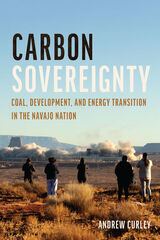 Carbon Sovereignty: Coal, Development, and Energy Transition in the Navajo Nation
Andrew Curley
University of Arizona Press, 2023 For almost fifty years, coal dominated the Navajo economy. But in 2019 one of the Navajo Nation’s largest coal plants closed.
This comprehensive new work offers a deep dive into the complex inner workings of energy shift in the Navajo Nation. Geographer Andrew Curley, a member of the Navajo Nation, examines the history of coal development within the Navajo Nation, including why some Diné supported coal and the consequences of doing so. He explains the Navajo Nation’s strategic choices to use the coal industry to support its sovereignty as a path forward in the face of ongoing colonialism. Carbon Sovereignty demonstrates the mechanism of capitalism through colonialism and the construction of resource sovereignty, in both the Navajo Nation’s embrace and its rejection of a coal economy.
For the people of the Navajo Nation, energy sovereignty is dire and personal. Thanks to on-the-ground interviews with Diné coal workers, environmental activists, and politicians, Curley documents the real consequences of change as they happened. While some Navajo actors have doubled down for coal, others have moved toward transition. Curley argues that political struggles ultimately shape how we should understand coal, capitalism, and climate change. The rise and fall of coal magnify the nuance and complexity of change. Historical and contemporary issues intermingle in everyday life with lasting consequences.
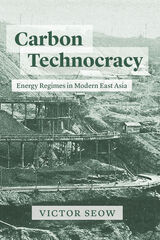 Carbon Technocracy: Energy Regimes in Modern East Asia
Victor Seow
University of Chicago Press, 2021 A forceful reckoning with the relationship between energy and power through the history of what was once East Asia’s largest coal mine.
The coal-mining town of Fushun in China’s Northeast is home to a monstrous open pit. First excavated in the early twentieth century, this pit grew like a widening maw over the ensuing decades, as various Chinese and Japanese states endeavored to unearth Fushun’s purportedly “inexhaustible” carbon resources. Today, the depleted mine that remains is a wondrous and terrifying monument to fantasies of a fossil-fueled future and the technologies mobilized in attempts to turn those developmentalist dreams into reality.
In Carbon Technocracy, Victor Seow uses the remarkable story of the Fushun colliery to chart how the fossil fuel economy emerged in tandem with the rise of the modern technocratic state. Taking coal as an essential feedstock of national wealth and power, Chinese and Japanese bureaucrats, engineers, and industrialists deployed new technologies like open-pit mining and hydraulic stowage in pursuit of intensive energy extraction. But as much as these mine operators idealized the might of fossil fuel–driven machines, their extractive efforts nevertheless relied heavily on the human labor that those devices were expected to displace. Under the carbon energy regime, countless workers here and elsewhere would be subjected to invasive techniques of labor control, ever-escalating output targets, and the dangers of an increasingly exploited earth.
Although Fushun is no longer the coal capital it once was, the pattern of aggressive fossil-fueled development that led to its ascent endures. As we confront a planetary crisis precipitated by our extravagant consumption of carbon, it holds urgent lessons. This is a groundbreaking exploration of how the mutual production of energy and power came to define industrial modernity and the wider world that carbon made.
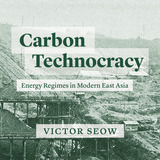 Carbon Technocracy: Energy Regimes in Modern East Asia
Victor Seow
University of Chicago Press, 2021 Audiobook edition
A forceful reckoning with the relationship between energy and power through the history of what was once East Asia’s largest coal mine.
The coal-mining town of Fushun in China’s Northeast is home to a monstrous open pit. First excavated in the early twentieth century, this pit grew like a widening maw over the ensuing decades, as various Chinese and Japanese states endeavored to unearth Fushun’s purportedly “inexhaustible” carbon resources. Today, the depleted mine that remains is a wondrous and terrifying monument to fantasies of a fossil-fueled future and the technologies mobilized in attempts to turn those developmentalist dreams into reality.
In Carbon Technocracy, Victor Seow uses the remarkable story of the Fushun colliery to chart how the fossil fuel economy emerged in tandem with the rise of the modern technocratic state. Taking coal as an essential feedstock of national wealth and power, Chinese and Japanese bureaucrats, engineers, and industrialists deployed new technologies like open-pit mining and hydraulic stowage in pursuit of intensive energy extraction. But as much as these mine operators idealized the might of fossil fuel–driven machines, their extractive efforts nevertheless relied heavily on the human labor that those devices were expected to displace. Under the carbon energy regime, countless workers here and elsewhere would be subjected to invasive techniques of labor control, ever-escalating output targets, and the dangers of an increasingly exploited earth.
Although Fushun is no longer the coal capital it once was, the pattern of aggressive fossil-fueled development that led to its ascent endures. As we confront a planetary crisis precipitated by our extravagant consumption of carbon, it holds urgent lessons. This is a groundbreaking exploration of how the mutual production of energy and power came to define industrial modernity and the wider world that carbon made.
 Carceral Afterlives: Prisons, Detention, and Punishment in Postcolonial Uganda
Katherine Bruce-Lockhart
Ohio University Press, 2022 Drawing upon social history, political history, and critical prison studies, this book analyzes how prisons and other instruments of colonial punishment endured after independence and challenges their continued existence. In Carceral Afterlives, Katherine Bruce-Lockhart traces the politics, practices, and lived experiences of incarceration in postcolonial Uganda, focusing on the period between independence in 1962 and the beginning of Yoweri Museveni’s presidency in 1986. During these decades, Ugandans experienced multiple changes of government, widespread state violence, and war, all of which affected the government’s approach to punishment. Bruce-Lockhart analyzes the relationship between the prison system and other sites of confinement—including informal detention spaces known as “safe houses” and wartime camps—and considers other forms of punishment, such as public executions and “disappearance” by state paramilitary organizations. Through archival and personal collections, interviews with Ugandans who lived through these decades, and a range of media sources and memoirs, Bruce-Lockhart examines how carceral systems were imagined and experienced by Ugandans held within, working for, or impacted by them. She shows how Uganda’s postcolonial leaders, especially Milton Obote and Idi Amin, attempted to harness the symbolic, material, and coercive power of prisons in the pursuit of a range of political agendas. She also examines the day-to-day realities of penal spaces and public perceptions of punishment by tracing the experiences of Ugandans who were incarcerated, their family members and friends, prison officers, and other government employees. Furthermore, she shows how the carceral arena was an important site of dissent, examining how those inside and outside of prisons and other spaces of captivity challenged the state’s violent punitive tactics. Using Uganda as a case study, Carceral Afterlives emphasizes how prisons and the wider use of confinement—both as a punishment and as a vehicle for other modes of punishment—remain central to state power in the Global South and North. While scholars have closely analyzed the prison’s expansion through colonial rule and the rise of mass incarceration in the United States, they have largely taken for granted its postcolonial persistence. In contrast, Bruce-Lockhart demonstrates how the prison’s transition from a colonial to a postcolonial institution explains its ubiquity and reveals ways to critique and challenge its ongoing existence. The book thus explores broader questions about the unfinished work of decolonization, the relationship between incarceration and struggles for freedom, and the prison’s enduring yet increasingly contested place in our global institutional landscape.
 Carceral Citizens: Labor and Confinement in Puerto Rico
Caroline M. Parker
University of Chicago Press, 2024 A nuanced take on how carceral expansions are changing labor and social life.
In Carceral Citizens, anthropologist Caroline M. Parker offers an ethnographic portrait of therapeutic communities in Puerto Rico, the oldest colony in the Americas. As nonprofits nested within the carceral state, therapeutic communities serve as reeducation and recovery centers for the mostly male drug offenders who serve out their sentences engaged in manual labor and prayer. The most surprising aspect of these centers, however, is that their “graduates” often remain long after the completion of their term, working as self-appointed peer counselors in a mixture of volunteer and low-wage positions.
Parker seeks to explain this dynamic by showing how, in these therapeutic communities, criminalized men find new and meaningful ways of living in the shadow of the prison. Through their participation in the day-to-day functioning of the centers, they discover and cultivate alternative forms of belonging, livelihood, and citizenship, despite living within the restrictions of the carceral state. Situating her study against the backdrop of Puerto Rico’s colonial history, and with findings that extend across Latin America, Parker challenges common assumptions about confinement, labor, and rehabilitation. By delving into lives shaped by the convergence of imperialism, the carceral state, and self-help, she offers a fresh understanding of the transformations of labor and social life brought about by mass incarceration.
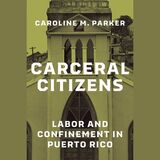 Carceral Citizens: Labor and Confinement in Puerto Rico
Caroline M. Parker
University of Chicago Press, 2024 A nuanced take on how carceral expansions are changing labor and social life.
In Carceral Citizens, anthropologist Caroline M. Parker offers an ethnographic portrait of therapeutic communities in Puerto Rico, the oldest colony in the Americas. As nonprofits nested within the carceral state, therapeutic communities serve as reeducation and recovery centers for the mostly male drug offenders who serve out their sentences engaged in manual labor and prayer. The most surprising aspect of these centers, however, is that their “graduates” often remain long after the completion of their term, working as self-appointed peer counselors in a mixture of volunteer and low-wage positions.
Parker seeks to explain this dynamic by showing how, in these therapeutic communities, criminalized men find new and meaningful ways of living in the shadow of the prison. Through their participation in the day-to-day functioning of the centers, they discover and cultivate alternative forms of belonging, livelihood, and citizenship, despite living within the restrictions of the carceral state. Situating her study against the backdrop of Puerto Rico’s colonial history, and with findings that extend across Latin America, Parker challenges common assumptions about confinement, labor, and rehabilitation. By delving into lives shaped by the convergence of imperialism, the carceral state, and self-help, she offers a fresh understanding of the transformations of labor and social life brought about by mass incarceration.
 Carceral Entanglements: Gendered Public Memories of Japanese American World War II Incarceration
Wendi Yamashita
Temple University Press, 2024 Japanese Americans have long contended with settler colonization and mass criminalization by the state, most notably during the WWII era when they were forced into incarceration camps. In Carceral Entanglements, Wendi Yamashita asks, how do narratives of worth and success that make Japanese Americans legible to the state come to be? What are the consequences of such narratives?
Carceral Entanglements features interviews, archival research, and texts to explore racial violence and patriotic masculinity and explain how Japanese American history and identity are publicly memorialized. Yamashita examines museums, digital archives, pilgrimages, and student-run and performed plays to understand how Japanese Americans occupy a “contradictory location” produced by the state. She also addresses historical erasure, race relations and the struggle for redress and reparations.
Carceral Entanglements is about the interlocking relationship Japanese American incarceration memories have to the prison industrial complex and the settler colonial logics that at times unknowingly sustain it.
Carceral Humanitarianism: Logics of Refugee Detention
Kelly Oliver
University of Minnesota Press, 2017 Coopted by military operations, humanitarianism has never been neutral. Rather than welcoming refugees, host countries assess the relative risks of taking them in versus turning them away, using a risk-benefit analysis that often reduces refugees to collateral damage in proxy wars fought in the war on terrorism. Carceral Humanitarianism testifies that humanitarian aid and human rights discourse are always political and partisan.
Forerunners is a thought-in-process series of breakthrough digital works. Written between fresh ideas and finished books, Forerunners draws on scholarly work initiated in notable blogs, social media, conference plenaries, journal articles, and the synergy of academic exchange. This is gray literature publishing: where intense thinking, change, and speculation take place in scholarship.
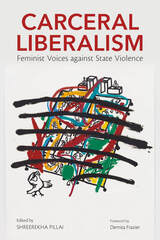 Carceral Liberalism: Feminist Voices against State Violence
Edited by Shreerekha Pillai. Foreword by Demita Frazier
University of Illinois Press, 2023 One of Ms. Magazine's Most Anticipated Books of 2023 Carceral liberalism emerges from the confluence of neoliberalism, carcerality, and patriarchy to construct a powerful ruse disguised as freedom. It waves the feminist flag while keeping most women still at the margins. It speaks of a post-race society while one in three Black men remain incarcerated. It sings the praises of capital while the dispossessed remain mired in debt. Shreerekha Pillai edits essays on carceral liberalism that continue the trajectory of the Combahee River Collective and the many people inspired by its vision of feminist solidarity and radical liberation. Academics, activists, writers, and a formerly incarcerated social worker look at feminist resurgence and resistance within, at the threshold of, and outside state violence; observe and record direct and indirect forms of carcerality sponsored by the state and shaped by state structures, traditions, and actors; and critique carcerality. Acclaimed poets like Honorée Fanonne Jeffers and Solmaz Sharif amplify the volume’s themes in works that bookend each section. Cutting-edge yet historically grounded, Carceral Liberalism examines an American ideological creation that advances imperialism, anti-blackness, capitalism, and patriarchy. Contributors: Maria F. Curtis, Joanna Eleftheriou, Autumn Elizabeth and Zarinah Agnew and D Coulombe, Jeremy Eugene, Demita Frazier, Honorée Fanonne Jeffers, Alka Kurian, Cassandra D. Little, Beth Matusoff Merfish, Francisco Argüelles Paz y Puente, Shreerekha Pillai, Marta Romero-Delgado, Ravi Shankar, Solmaz Sharif, Shailza Sharma, Tria Blu Wakpa and Jennifer Musial, Javier Zamora
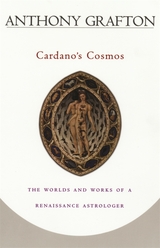 Cardano’s Cosmos: The Worlds and Works of a Renaissance Astrologer
Anthony Grafton
Harvard University Press, 1999 Girolamo Cardano was an Italian doctor, natural philosopher, and mathematician who became a best-selling author in Renaissance Europe. He was also a leading astrologer of his day, whose predictions won him access to some of the most powerful people in sixteenth-century Europe. In Cardano’s Cosmos, Anthony Grafton invites readers to follow this astrologer’s extraordinary career and explore the art and discipline of astrology in the hands of a brilliant practitioner.
Renaissance astrologers predicted everything from the course of the future of humankind to the risks of a single investment, or even the weather. They analyzed the bodies and characters of countless clients, from rulers to criminals, and enjoyed widespread respect and patronage. This book traces Cardano’s contentious career from his first astrological pamphlet through his rise to high-level consulting and his remarkable autobiographical works. Delving into astrological principles and practices, Grafton shows how Cardano and his contemporaries adapted the ancient art for publication and marketing in a new era of print media and changing science. He maps the context of market and human forces that shaped Cardano’s practices—and the maneuvering that kept him at the top of a world rife with patronage, politics, and vengeful rivals.
Cardano’s astrology, argues Grafton, was a profoundly empirical and highly influential art, one that was integral to the attempts of sixteenth-century scholars to understand their universe and themselves.
 A Cardboard Castle?: An Inside History of the Warsaw Pact, 1955-1991
The National Security Archive Mastny
Central European University Press, 2005 This is the first book to document, analyze, and interpret the history of the Warsaw Pact based on the archives of the alliance itself. As suggested by the title, the Soviet bloc military machine that held the West in awe for most of the Cold War does not appear from the inside as formidable as outsiders often believed, nor were its strengths and weaknesses the same at different times in its surprisingly long history, extending for almost half a century. The introductory study by Mastny assesses the controversial origins of the "superfluous" alliance, its subsequent search for a purpose, its crisis and consolidation despite congenital weaknesses, as well as its unexpected demise. Most of the 193 documents included in the book were top secret and have only recently been obtained from Eastern European archives by the PHP project. The majority of the documents were translated specifically for this volume and have never appeared in English before. The introductory remarks to individual documents by co-editor Byrne explain the particular significance of each item. A chronology of the main events in the history of the Warsaw Pact, a list of its leading officials, a selective multilingual bibliography, and an analytical index add to the importance of a publication that sets the new standard as a reference work on the subject and facilitate its use by both students and general readers.
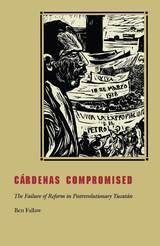 Cárdenas Compromised: The Failure of Reform in Postrevolutionary Yucatán
Ben Fallaw
Duke University Press, 2001 Cárdenas Compromised is a political and institutional history of Mexico’s urban and rural labor in the Yucatán region during the regime of Lázaro Cárdenas from 1934 to 1940. Drawing on archival materials, both official and popular, Fallaw combines narrative, individual case studies, and focused political analysis to reexamine and dispel long-cherished beliefs about the Cardenista era.
For historical, geographical, and ethnic reasons, Yucatán was the center of large-scale land reform after the Mexican Revolution. A long-standing revolutionary tradition, combined with a harsh division between a powerful white minority and a poor, Maya-speaking majority, made the region the perfect site for Cárdenas to experiment by launching an ambitious top-down project to mobilize the rural poor along ethnic and class lines. The regime encouraged rural peasants to form collectives, hacienda workers to unionize, and urban laborers to strike. It also attempted to mobilize young people and women, to challenge Yucatán’s traditional, patriarchal social structure, to reach out to Mayan communities, and to democratize the political process. Although the project ultimately failed, political dialogue over Cárdenas’s efforts continues. Rejecting both revisionist (anti-Cárdenas) and neopopulist (pro-Cárdenas) interpretations, Fallaw overturns the notion that the state allowed no room for the agency of local actors. By focusing on historical connections across class, political, and regional lines, Fallaw transforms ideas on Cardenismo that have long been accepted not only in Yucatán but throughout Mexico.
This book will appeal to scholars of Mexican history and of Latin American state formation, as well as to sociologists and political scientists interested in modern Mexico.
The Cardinal
Text by June Osborne, Photos by Barbara Garland
University of Texas Press, 1992 In this inviting guide, June Osborne and Barbara Garland follow a year in the life of the Northern Cardinal with a fact-filled text and glowing color photographs. They describe how cardinals stake out territory and choose mates, find a nesting site and incubate their eggs, feed the young and prepare them for full-fledged independence. The Cardinal also explores the special relationship that humans have with their favorite redbirds. Osborne traces the symbolic use of cardinals as state birds (Illinois, Indiana, Kentucky, North Carolina, Ohio, Virginia, and West Virginia) and athletic mascots and shows how they appear on everything from postage stamps to Christmas cards, as well as in fine art, literature, and Native American folklore.
 Cardinal Adam Easton (c. 1330-1397): Monk, Scholar, Theologian, Diplomat
Miriam Wendling
Amsterdam University Press, 2020 The varied career of Adam Easton (c.1330—1397) led him from Norwich Cathedral Priory to Oxford, Avignon and Rome. Not only a monk of the Benedictine Order, he was also a scholar, theologian, diplomat and cardinal, and his work reflects the breadth of this multifaceted background. This volume presents recent research on Easton’s oeuvre, his diplomacy and the books that accompanied him on his travels. Amongst the works addressed in this volume are Easton’s Defensorium ecclesiastice potestatis, his Defensorium Sanctae Birgittae and his Office for the Feast of the Visitation of the Virgin Mary. Further evidence is also offered on his testimony during the Great Schism, on the dating of his copy of De pauperie Salvatoris, while two reassessments are made of his likeness, including his sepulchral monument at S. Cecilia in Trastevere in Rome and the Lutterworth wall painting. Finally, a catalogue of Easton’s important manuscript collection is also provided.
 Cardinal in My Window with a Mask on Its Beak
Carlos Aguasaco, Translated by Jennifer Rathbun
University of Arizona Press, 2022 Cardinal in My Window with a Mask on Its Beak takes readers on a journey through poetic portraits, exploring the lives of passionate social justice advocates and historical migrants such as Ota Benga, Sarah Baartman, Isidro Marcelino Orbés, César Vallejo, and Gertrude Stein, among others. Raw and unapologetic, the poems in this bilingual collection ask readers to question their role in today’s society. The verses press the reader to examine what it means to have social justice in our globalized world, as Aguasaco confronts how society treats the Other—be that the immigrant, the Indigenous person, or anyone who embodies Otherness.
A first-generation immigrant to the United States, Aguasaco embraces his transborder/transnational/intercultural identity by building a bridge across time and distance to unite the great voices of the Renaissance with his lyrical poems. The collection offers bold and fascinating dialogue with Spanish authors such as Juan Boscán, Francisco de Quevedo, Garcilaso de la Vega, and Sor Juana Inés de la Cruz. The poems examine the fundamental liberties inherent to humanity through stunning verse. In a quest for freedom, the poems openly criticize the treatment of immigrants in the United States, drawing poignant parallels with human rights abuses throughout history.
Cardinal in My Window with a Mask on Its Beak brings potent voices of the past to life in poems that critically examine the present and future of the human experience.
 Cardinal Memories: Recollections from Baseball's Greatest Fans
Edited & Intro by Tina Wright
University of Missouri Press, 2000
Heralded by local and national media as perhaps baseball's most devoted followers, the lovers of St. Louis's legendary Redbirds have a special bond with their team. Cardinal Memories: Recollections from Baseball's Greatest Fans celebrates this relationship by focusing on the people in the stands. A collection of essays gathered from around the world, from St. Louis to Hong Kong, Cardinal Memories forms a history of the team the way it is best remembered—through the eyes and hearts of its fans.
By turns funny and poignant, these stories chronicle Cardinal teams and players from the Gashouse Gang to the Swifties, from El Birdos to Whiteyball and Big Mac. The bond between parent and child, the generosity of numerous players, and the power of a single game to unite thousands of people are only a few of the themes that run throughout this remarkable collection. Whether it's the tale of young fans clamoring at a bus stop for a glimpse of Stan the Man, a surprise gift from the "Mad Hungarian," or Mark McGwire's "71st" home run, these vignettes capture the joy, heartbreak, and passion of being a Cardinal fan.
Focusing on the game's emotional appeal, Cardinal Memories is about more than baseball—its evocative tales capture the game's deeper meanings and offer readers an affectionate slice of Americana. Transcending Cardinal country, these touching stories will appeal to baseball fans and sports enthusiasts everywhere.
Cardinal Points
Pettit, Michael
University of Iowa Press, 1988 Strung throughout the book are poems based on the Scottish photographer Eadwaerd Muybridge's Animal Locomotion, a historic photographic document. Pettit uses these pioneering images as the basis for his poetic dreaming, and the result is a poignant, integrated sequence of highly moving poems, studded between other vivid lyrics.
 Cardinal Rafael Merry del Val
Philippe Roy-Lysencourt
Catholic University of America Press, 2021 Rafael Merry del Val (1865-1930) was a cardinal of the Roman Catholic Church who had one of the most dazzling careers in ecclesiastical history: he was a secret supernumerary chamberlain at the age of 21, a secret participating chamberlain at the age of 26, an apostolic delegate to Canada at age 31, president of the Academy of Ecclesiastical Nobles and archbishop at age 34, secretary of state for Pius X (1903-1914) and cardinal at age 38, archpriest of St. Peter’s Basilica and prefect of the Fabric of St. Peter at age 48, secretary of the Congregation of the Holy Office at age 49. In 1953, his beatification process was introduced to the Congregation for Rites.
In this study, Philippe Roy-Lysencourt presents the life of this personage, his curial charges, his relations with the popes he served (Leo XIII, Pius X, Benedict XV, and Pius XI), his apostolate, his unexpected death and the furor it caused.
The book includes an inventory of sources for understanding Cardinal Merry del Val’s life, a list of his published writings, as well as a bibliography of the works written about him.
Cardiology: The Evolution of the Science and the Art
Bing, Richard J.
Rutgers University Press, 1999 Contributors to this volume examine the history of cardiology, stressing the source of ideas that have guided cardiology to the present. The lives of the scientists and physicians are emphasized, as are their successes and failures, their struggles and disappointments. Chapters cover. - Cardiac Catheterization - Echocardiography and the Doppler method - Cardiopulmonary Bypass - Congenital Heart Disease - Transplantation of the Heart - Artherosclerosis - Coronary Artery Disease - Coronary Artery Surgery - Isotopes in Cardiology - Myocardial Failure - Valvular Surgery - Hypertension and Hypertensive Heart Disease - Molecular Biology and Genetics of Cardiovascular Diseases - Electrophysiology - History of Cardiology at the Bedside Contributors to this volume include: Dr. Donald Baim, Dr. John Baldwin, Dr. Arnold M. Katz, Dr. Berndt Luderitz, and Dr. Alexander Nadas.
Cardiovascular Diseases in the United States
Iwao M. Moriyama, Dean E. Krueger, and Jeremiah Stamler
Harvard University Press, 1971 Cardiovascular diseases kill and disable more than a million Americans each year. The major types of this complex of diseases are coronary heart disease, hypertensive disease, cerebrovascular diseases, rheumatic heart disease, and congenital malformations of the circulatory system. Authors Moriyama, Krueger, and Stamler relate each of these types to etiology, age of patient at onset, clinical course, and socioeconomic impact on the population. For each type of cardiovascular disease they analyze the quantitative data on the incidence, prevalence, and levels and time trends of mortality and on the demographic characteristics of person affected. They also examine international differences in levels and trends in mortality and point out areas for further research. More than thirty-five figures as well as extensive tables document their text.
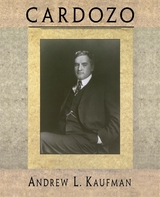 Cardozo
Andrew L. Kaufman
Harvard University Press, 1998 Benjamin Nathan Cardozo, unarguably one of the most outstanding judges of the twentieth century, is a man whose name remains prominent and whose contributions to the law remain relevant. This first complete biography of the longtime member and chief judge of the New York Court of Appeals and Justice of the Supreme Court of the United States during the turbulent years of the New Deal is a monumental achievement by a distinguished interpreter of constitutional law.
Cardozo was a progressive judge who understood and defended the proposition that judge-made law must be adapted to modern conditions. He also preached and practiced the doctrine that respect for precedent, history, and all branches of government limited what a judge could and should do. Thus, he did not modernize law at every opportunity.
In this book, Andrew Kaufman interweaves the personal and professional lives of this remarkable man to yield a multidimensional whole. Cardozo’s family ties to the Jewish community were a particularly significant factor in shaping his life, as was his father’s scandalous career—and ultimate disgrace—as a lawyer and judge. Kaufman concentrates, however, on Cardozo’s own distinguished career, including twenty-three years in private practice as a tough-minded and skillful lawyer and his classic lectures and writings on the judicial process. From this biography emerges an estimable figure holding to concepts of duty and responsibility, but a person not without frailties and prejudice.
Cardozo: A Study in Reputation
Richard A. Posner
University of Chicago Press, 1993 What makes a great judge? How are reputations forged? Why do some reputations endure, while others crumble? And how can we know whether a reputation is fairly deserved? In this ambitious book, Richard Posner confronts these questions in the case of Benjamin Cardozo. The result is both a revealing portrait of one of the most influential legal minds of our century and a model for a new kind of study—a balanced, objective, critical assessment of a judicial career.
"The present compact and unflaggingly interesting volume . . . is a full-bodied scholarly biography. . . .It is illuminating in itself, and will serve as a significant contribution."—Paul A. Freund, New York Times Book Review
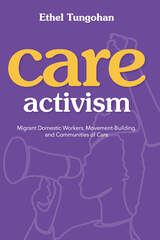 Care Activism: Migrant Domestic Workers, Movement-Building, and Communities of Care
Ethel Tungohan
University of Illinois Press, 2023 Care activism challenges the stereotype of downtrodden migrant caregivers by showing that care workers have distinct ways of caring for themselves, for each other, and for the larger transnational community of care workers and their families. Ethel Tungohan illuminates how the goals and desires of migrant care worker activists goes beyond political considerations like policy changes and overturning power structures. Through practices of subversive friendships and being there for each other, care activism acts as an extension of the daily work that caregivers do, oftentimes also instilling practices of resistance and critical hope among care workers. At the same time, the communities created by care activism help migrant caregivers survive and even thrive in the face of arduous working and living conditions and the pains surrounding family separation. As Tungohan shows, care activism also unifies caregivers to resist society’s legal and economic devaluations of care and domestic work by reaffirming a belief that they, and what they do, are important and necessary.
|
|

